Tennis memorabilia has its dayin court

African 7modernists
Every collector should know

Tennis memorabilia has its dayin court

African 7modernists
Every collector should know
Discover the family of Italian designers beyond the famous cars SPECIAL REPORT
TIME TO SHINE THREE CENTURIES OF HOROLOGICAL MASTERPIECES
ENIGMA MAN ALAN TURING’S ARCHIVE IN THE SPOTLIGHT
TheCollectorAuction
Thursday19June2025startingat11am atourGlandford,Norfolksaleroom
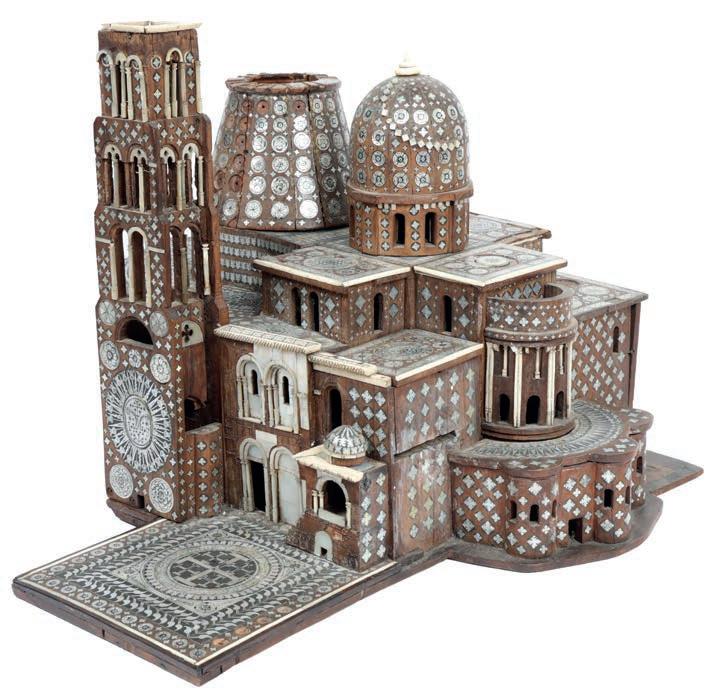
alreadyconsignedtothisspecialistauctionisafabulousandrare17thcenturymodelof TheChurchofTheHolySepulchre,Jerusalem.Estimate:£10,000-£15,000.
Fullauctiondetailsavailableonourwebsite.


You don’t have to be all that invested, as the young people say, or even that interested in the royal family to recognise the cultural phenomenon that was, and is, Princess Diana. A lasting legacy only boosted in recent years by e Crown which spread her popularity to to a whole new generation. e memorabilia expert Paul Fraser is always keen to advise collectors that the one signature they really need to own is that of the late princess.
So when 200 items associated with Diana and other British royals go under the hammer this summer it will be big news for collectors. e sale includes dresses that were among the 79 of hergowns that Diana herself sold for charity in her famous 1997 Christie’s auction. But there is one significant difference. As Martin Nolan, founder of Julien’s Auctions, said: “Atthat time her dresses were selling for $30,000 or $40,000…now they’re comingback and selling for $800,000, $900,000,$1 million ”
Here are the numbers: a Catherine Walker ivory gown that sold for $25,300 in 1997 sold for $508,000 in 2023 (an increase of1,907 per cent); a green and black gown by the same designer which sold for $24,150 in 1997 sold for $571,50 in 2023 (an increase of 2,266 per cent) and a Bruce Old eld red chi on dress which sold for $34,500 in 1997 sold for $571,500 in 2023 (an increase of 1,556 per cent). And there aren’t many collectables that do that. We will keep you up to date with the results.
Of course spotting a trend before it takes o is many collectors’ dream. O ne such phenomenon you would be mad to ignore is the current market for modern and contemporary African art Prices are booming as the world wakes up to the remarkable breadth of talent the continent continues to produce. Have a look at the feature on page 48.
Elsewhere in the magazine, on page 40, Ivan Macquisten sets his sights on tennis memorabilia which is fast catching up with the more sought after sports of football, golf and cricket; while, on page 46, books expert Jim Spencer takes a deep dive the personal archive of Enigma code breaker Alan Turing, including a signed copy of his PhD, which appears in hissaleroom this month. And on this year’s 100th anniversary of art deco, Joy McCall shares herinsight on the design movement and its lasting importance and why it will never fall out offavour with collectors. Enjoy the issue.`
Georgina Wroe, Editor
Write to us at Antique Collecting, Riverside House, Dock Lane, Woodbridge, Suffolk, IP12 1PE, or email magazine@accartbooks.com. Visit the website at www.antique-collecting. co.uk and follow us on X and Instagram @AntiqueMag
is straw hat worn by Princess Diana for her honeymoon send o on July 29 1981 which has an estimate of $20,000-$40,000 at Julien’s Auctions’ sale on June 26. We love!


JOY MCCALL celebrates a century of art deco and what it means for collectors, page 18

JAMES STRATTON goes behind the scenes of a very special clock sale, page 26

EDWARD HORSWELL reveals why there is more to the Bugatti family than cars, page 28

JIM SPENCER puts the personal archive of Alan Turing in the spotlight, page 46
Editor: Georgina Wroe, georgina. wroe@accartbooks.com
Online Editor: Richard Ginger, richard.ginger@accartbooks.com
Design: Philp Design, philpdesign.co.uk Advertising and subscriptions: 01394 389969, magazine@ accartbooks.com

Tuesday 17 June
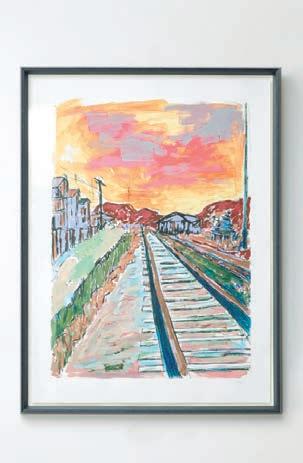
Wednesday 25 June
Preview of Roseberys’ forthcoming auction calendar

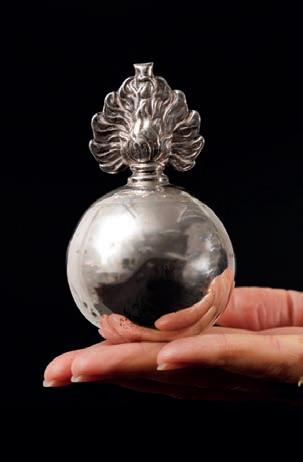
Wednesday 18 June

Tuesday 8 July
Tuesday 24 June




3 Editor’s Welcome: Georgina Wroe introduces the combined June/ July issue jampacked with features and ideas

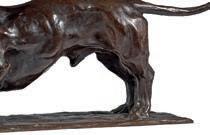



Edgar Brandt (1880-1960) La Tentation, a patinated gilt bronze floor lamp designed 1920-1926. Image courtesy of Lyon & Turnbull, see the feature on page18












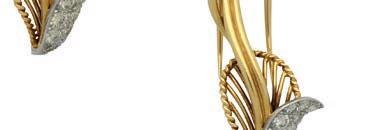




6 Antiques News: ere is a wealth of activities on o er for the antiques and ne art devotee this summer. Antique Collecting reveals all the latest
10 Your Letters: One reader recalls a favourite TV programme from the ‘70s while another is taken aback by a trip to an Essex gallery
12 Around the Houses: Highlights from the UK’s leading salerooms including a sword from the Battle of Flodden and a record-breaking Land Rover once owned by Rowan Atkinson
15 Lots to Talk About: Columnist, TV expert and auctioneer Catherine Southon has her hopes pinned to an exceptional collection of samplers

25 An Auctioneer’s Lot: Charles Hanson says cheers to a Georgian wine funnel unearthed from a Nottingham cupboard and set to create a stir in the saleroom
26 Saleroom Spotlight July: We preview some very special clocks going under the hammer in July including a “mortar” clock in the shape of a cannon, and a solar powered timepiece by Patek Philippe
44 Puzzle Pages: Don’t let the long summer break turn your brain soft, keep those little grey cells alive with an antiques crossword and quiz, devised by our resident puzzles editor Peter Wade-Wright
Fairs Calendar: Planning a summer
getaway? Wherever you are heading check out the local events taking place courtesy of our comprehensive guide

59 Fair News: Details of one of the highlights of the London fairs calendar – the Treasure House Fair, as well as a popular event taking place in Harrogate
61 Auction Calendar: Never miss another lot with our one-stop guide to the best sales taking place in June and July around the UK
66 e Last Word: Another slice of life from Antiques Roadshow specialist Marc Allum on his experiences in the front line as a valuer, lecturer and TV expert
18 All that Jazz: 100 years since the advent of art deco, Joy McCall looks at the era’s enduring style which collectors can never get enough of. She shares her guide to the sculpture, art and design that made the movement so famous
28 Family A air: ere is much more to the Bugatti family name than the famous cars it produced. On the eve of an exhibition on the Italian dynasty, Antique Collecting pro les the family’s leading lights and their innovative designs
36 Why I Collect: Bottles from the 500,000-strong collection of brands owned by social historian Ropert Opie go on show this summer. Antique Collecting lifts the lid on a lifetime obsession








46 Saleroom Spotlight June: Scienti c papers belonging to the Enigma code breaker Alan Turing, including a signed copy of his PhD, go under the hammer in Sta ordshire














Top of the Lots: A rare copy of William Blake’s Songs of Experience is set to make $1.5m in New York while a gem-set Mughal dagger appears on the rostrum in London
Top of the Lots: appears
Book O ers: Make the most of this month’s selection of titles from our sister publisher ACC Art Books and save more than a third on the recommended price in our subscriber exclusive
40 Net Gains: With Wimbledon set to have us glued to our TV sets this month, Ivan Macquisten puts tennis memorabilia in the spotlight. Undervalued compared to other sports, now is the perfect time to bag some big hitters
48 Continental Shift: Few collecting elds have the potential of modern and contemporary African art. is summer’s rst ever Africa Basel is shining a light on the phenomenon. Antique Collecting reveals seven artists every collector should know

Make this the best ‘antiquing’ summer ever with our suggestions of places to visit and events to take part in
A memorabilia collector is hoping to reach 100 Beatles fans who sent fan mail to Ringo Starr in 1965 as part of a special project. Joseph O’Donnell, from Tynemouth, bought the envelopes, some sent from as far away as Brazil and Australia dated between 1965 and 1966 in an online auction in January.




ey had been collected by Starr’s former employee who had kept them for the international stamps. Joseph said: “More than half of them have clear return addresses.
“ e goal is to exhibit them as 100 Letters to Ringo. I’d also love to speak to any Royal Mail workers from the time, to learn more about the volume of letters sent to e Beatles.”

A rare 18th-century French mantel clock has gone on show at Blenheim Palace in Woodstock, Oxfordshire. e ormolu and blue painted timepiece, c.1795, is part of the house’s new family treasures tour which takes visitors into the Grand Cabinet – the most opulent room in the palace.
e clock’s urn case is surrounded by a spray of owers anked by leaf-scroll handles on a rectangular plinth with garlands of owers. On the same tour, visitors can view another horological treasure – a rare skeleton clock attributed to highly-regarded maker John Moxon.
Above e French mantel clock is part of the tour at the Oxfordshire palace
Top right Sandro di Lorenzo di Smeraldo (1483-1554), e Master of the Unruly Children, terracotta, Trinity Fine Art
Above right e reversible brooch has a price tag of £95,000
Right e brooch and its mechanism can be seen in an original pencil and gouache sketch c.1946,
Left Joseph O’Donnell with the letters sent by Beatles fans
London welcomes a new art event this summer bringing together dealers in both old and modern disciplines.

Highlights of Classic Art London, from June 23 to July 5, include works by JMW Turner at Guy Peppiatt Fine Art and a newlydiscovered collection of watercolours by the explorer artist Constance Gordon-Cumming (1837-1924) at Karen Taylor Fine Art.


Confirmed selling exhibitions throughout the event, taking place at galleries around Mayfair and St James’s, include terracotta sculptures at Trinity Fine Art, works by British Impressionists at David Messum Fine Art and a selection of portrait miniatures from The Limner Company.













A London jeweller is highlighting one of its finest examples of Cartier’s craftsmanship to coincide with the landmark exhibition on the French maker at the V&A.




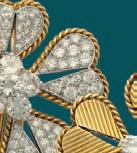





individually rotating petails, the brooch can
The reversible diamond and 18ct yellow gold daffodil brooch, dated 1946, is part of the stock of Hancocks London. With its individually rotating petails, the brooch can showcase either pavé-set diamonds in a ropetwist border or an allgold finish.

In the mid 20th century Cartier’s floral brooches captivated connoisseurs and collectors alike with Queen Elizabeth II given one for her wedding in 1947. Cartier is on at the V&A London until November 16.

















e rst major presentation of the work of the British artist, teacher and plantsman Cedric Morris (1889-1982) in the north of England opens at the Granary Gallery, Berwick-upon-Tweed in June. Highlights include Iris Seedlings showcasing Morris’ skill as a ower painter, with irises one of his specialities. Morris ran the East Anglian School of Painting and Drawing from 1939 to 1982, where pupils included Lucien Freud.
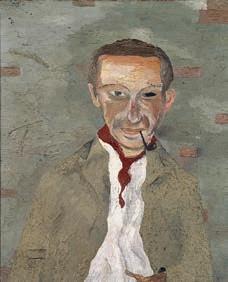

Feathers might not usually be associated with Britain’s greatest landscape painter, but JMW Turner’s bird studies have gone on show for the rst time in 40 years at his former London home.
Marking the 250th anniversary of his birth, the exhibition Turner’s Kingdom: Beauty, Birds and Beasts is on until October 26 at Sandycombe Lodge, the ameside villa in Twickenham where he lived from 1813-1826.
Works include watercolours from the Farnley Book of Birds, an album of natural history studies, painted for Turner’s patron, Walter Fawkes of Farnley Hall in Yorkshire.
Left Cedric Morris (18891982) Cedric Morris, c.1930 © e Estate of Sir Cedric Morris, National Portrait Gallery
Right Dante Gabriel Rossetti (1828-1882)
e Blue Bower, 1865, e Barber Institute of Fine Arts, University of Birmingham
Below right Edgar Degas (1834-1917) Jockeys before the Race, 18781879, e Barber Institute of Fine Arts, University of Birmingham
Below far right Elisabeth Vigée-Lebrun (17551842) Portrait of Countess Golovine, 1797-1800, e Barber Institute of Fine Arts, University of Birmingham
Left Cedric Morris (1889-1982) Iris Seedlings, 1943, Tate © e Estate of Sir Cedric Morris
Far left Lucien Freud (1922–2011) Cedric Morris, 1940, National Museum Wales © e Lucian Freud Archive. All Rights Reserved 2025/Bridgeman Images
Right JMW Turner (1775-1851) Gold nch, 1815 © Leeds Museums and Galleries
Far right JMW Turner (1775-1851) Peacock, from e Farnley Book of Birds, c. 1816 © Leeds Museums and Galleries, UK / Bridgeman Images
Below right JMW Turner (1775-1851) Head of a Turkey Cock, 1815 © Leeds Museums and Galleries



ere’s a chance to see 18 masterpieces from e Barber Institute of Fine Arts, part of the University of Birmingham, when they go on show at the Courtauld Gallery in London this summer. Works by Gainsborough, Reynolds, Turner, Degas and Monet will be available to view in the capital while the Barber undergoes major building improvements.
e Barber in London: Highlights from a Remarkable Collection continues until February 22 next year.
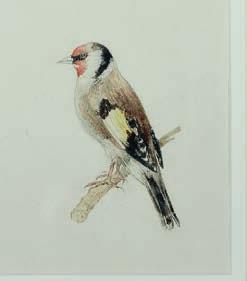






A summer charity auction in Beverly Hills claims to be the largest ever sale of items from the wardrobe of Diana, Princess of Wales.
The sale, on June 26, will be hosted by Julien’s Auctions, the house that has twice set records for Diana items in recent sales.
In 2023 it sold a 1985 Jacques Azagury evening gown for $1.14 million. Last year a gown by Victor Edelstein worn by Diana realised $910,000.




A newly-commissioned series of Tube posters celebrating iconic venues in the capital goes on show this year. Created by the artist and illustrator Eliza Southwood, the four posters celebrate Dulwich Picture Gallery, London Transport Museum, the Royal Albert Hall and London Zoo. Each follows in a rich artistic tradition of posters advertising the London Underground started by London Transport’s chief executive, Frank Pick, in 1908 as he pioneered a new approach to posters and continued to oversee an innovative array of commissions.
By the time the designs hit their peak in the 1920s and ‘30s, more than 40 posters were commissioned every year by a wide range of designers, from the famous and established to the new and unknown.





Chris Chapman from Medway Antiques in Faversham, Kent
Tell us about the business

We are a small independent shop based at the historic Standard Quay, where we opened 11 years ago. We specialise in Georgian and earlier furniture, maps and objects. Faversham is one of the few towns in Kent that still has a good selection of antique shops and the history to match.
How did you start as a dealer?
We started to collect antique furniture when a good friend, who owned a furniture shop in north London, showed us the durability, value and beauty of antique pieces after which we went on to furnish our house and have since
furnished the houses of many others. I love the idea of recycling furniture, bringing it back to life and I am constantly surprised at how little our field is given credit for our low carbon footprint and green credentials
Do you have a favourite period? The 17th century to me is the birth of the modern age but it was a diifficult birth involving civil wars, plagues and social upheaval.
These insecurities are reflected in the furniture, objects and art, making it a fascinating period to study. The furniture speaks to us through its carving which, although often regional, is always informative.
What are the popular sellerstoday?
One lucky art lover enjoyed an experience most can only dream of when they were selected to take part in a sleepover at the National Gallery.
For the first time in its history, the London gallery offered an overnight stay for the winner of a prize draw, ahead of its public reopening last month.
The winner, who was given a sumptuous bed for the night, could stroll alone among more than 1,000 works of art, each of which helps trace the development of painting in the western European tradition from the 13th to 20th century.
The last decade has seen the total loss of our European trade and, more recently, the localisation of our customers who seem less willing to travel.
We have also seen the end of the connoisseur buyers who are sadly dying out and not being replaced. The increase cost of auctions and the demise of antique fairs has meant most items are now purchased privately.
One thing that hasn’t changed is the popularity of the trusty Windsor chair. As houses have become smaller, items such as the Georgian pedestal wine table have proved popular.
For more details on Chris’s stock go to www.medwayantiques.co.uk or visit the showroom at Standard Quay, Faversham, Kent ME13 7BS

The V&A in South Kensington has unveiled plans for a major transformation of its fashion gallery, set to open in 2027.
The gallery is one of the museum’s largest permanent halls and among its most visited spaces. It also ranks as one of the largest and most comprehensive collections of dresses in the world.
Costumes vary from 18th-century mantua dresses, which originated in France in the 1670s, to cutting-edge contemporary couture from across the world. Recent exhibitions have included Gabrielle Chanel. Fashion Manifesto in 2023 and Christian Dior: Designer of Dreams in 2019.
Later this year it will host Marie Antoinette Style, celebrating the fashionable French queen.
Above A mantua and petticoat of silk, brocaded with silver-gilt threads, 1755-1760 made in England using French silk
A secretaire by the French 20th-century designer Stéphane Boudin (1888-1967) thought to be lost has gone on show at Leeds Castle in Kent. It comes from the collection of the Anglo-American heiress Lady Olive Baillie, who is credited with saving the castle. An avid collector, many of her wideranging treasures were sold following her death in 1974. e castle’s current curatorial team is pledged to return the collection to the 900-year-old property.
Queen Alexandra’s gold coronation dress is the latest treasure to go on show at this summer’s celebration of the Edwardian era at Buckingham Palace.
e King’s Gallery, alongside the royal residence, is hosting the exhibition e Edwardians: Age of Elegance which sees more than 300 works from the Royal Collection on show until November 23.
Centring on two of Britain’s most fashionable royal couples – Edward VII and Queen Alexandra and George V and Queen Mary - Alexandra in particular bucked the trend for coronation dresses to mimic ecclesiastical robes, opting for a dramatic gold dress by the Parisian fashion house Morin Blossier. Its tiny gold spangles were designed to sparkle in the electric lights that had been installed in Westminster Abbey for the rst time in honour of the occasion. At her suggestion the dress also included the national emblems of Britain, a tradition
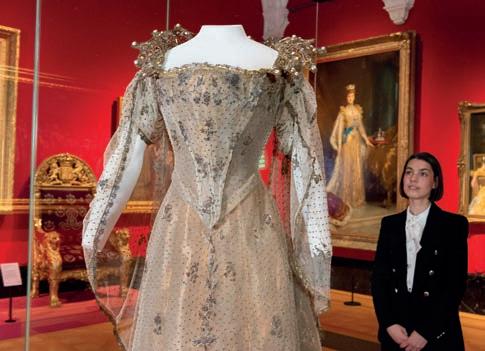

Top Queen Alexandra’s coronation dress in situ in e King’s Gallery © Royal Collection Enterprises Limited 2025/ Royal Collection Trust

Above Laurits Tuxen (1853-1927) e Anointing of Queen Alexandra at the Coronation of King Edward VII, 1902–1903

gift range based on mudlarking finds from the banks of the


There’s a chance to see more than 80 ships’ figureheads at the Cutty Sark in London this summer.
They come from the collection of the late British businessman and collector of Merchant Navy memorabilia Sydney Cumbers (1875-1959) who amassed the largest number of historic figureheads in the world, with some dating back some 200 years.
The well-crafted heads can be seen in the large gallery space beneath the famous tea clipper moored in Greenwich.
London Museum Docklands’ new collection includes ceramics inspired by London’s 17th and 18th-century Delftware potteries, as well as a limited-edition print depicting clay pipe bowls discovered on the famous London foreshore.
Early records of mudlarking date back to the mid-1800s, when London’s poor made a living by searching the water’s edge for items to sell.
Today it is the preserve of licensed mudlarkers who scour the riverside for treasures at low tide. The hobby, which has seen a huge boom in recent years, is now the subject of everything from podcasts to books.


Memories of a favourite TV show are evoked, plus details of a trip to an Essex art gallery
As one of your Australian readers, I greatly enjoyed Marc Allum’s recent column (Marc My Words, May issue) detailing his trip to my adopted country. As a devoted antiques enthusiast based in regional New South Wales, I am also a diehard fan of Antiques Roadshow. ough I’m thousands of miles away from the stately homes where the show is lmed, it has become a weekly ritual for me and my wife. Here in Australia, we have our own treasures: colonial furniture, Aboriginal artefacts, and items brought over by immigrants from every corner of the globe. But it’s always nice to have a glimpse of the Old Country.
Doug Bradshaw, Orange, NSW, Australia

I would like to share details ofa wonderful recent trip to the Fry Art Gallery in Sa ron Walden. In case subscribers are notaware, it is asmallish venuein the charming Essex town which specialises in work by artists who lived in and around the nearby village of Great Bard eld from the 1930s to the ‘80s. e list includes Eric Ravilious, his wife Tirzah Garwood and their friends John and Charlotte Aldridge. It was on my recent visit that I discovered the work of the artist Du y Ayers (who I confess I had not heard of before) and immediately became a fan. All in all a tremendous trip, added to by the gallery’s knowledgeable guides. I was also heartened that, even ona rainy Saturday afternoon, it was packed. Well done to all involved.
Fraser McFarlane, St Albans
Our star letter receives a copy of British Designer Silver by John Andrew and Derek Styles worth £75. Write to us at Antique Collecting magazine, Riverside House, Dock Lane, Melton, Woodbridge, Suffolk, IP12 1PE or email magazine@ accartbooks.com

Top right Last month’s article brought back happy memories for James
Left Melbourne was one of the cities on Marc’s itinerary Down Under
Below e Fry Art Gallery in Sa ron Walden, image public domain


What memories your recent article on toys inspired by TV programmes from the 1970s (Money to Play With, May issue) brought to mind. As a youngster how I looked forward to CHiPs with its catchy theme music and sweeping shots of California freeways. en appeared Erik Estrada as O cer ‘Ponch’ with his aviator sunglasses and con dent swagger alongside Jon Baker (played by Larry Wilcox). Surely these two were the rst of the buddy cops which went on to become such a hallmark of detective shows?
anks for bringing sun-drenched southern California to a rainy Lincolnshire.
James Dri ord, Spalding, by email
The answers to the quiz on page 44.


Q1 (b). Diners Club International was founded on February 8, 1950. The first real bank-issued credit card appeared in 1958. Q2 (c). Q3 (d). It was also known as a washing dolly and was used to move clothes around in water. Q3 (b) It is the iconic red telephone box designed in 1935 to commemorate the Silver Jubilee of George V. It was the first telephone kiosk to be extensively used outside London. Q5 (a). Shorter detective stories had been written, but Clement Lorimer or The Book with the Iron Clasps is considered the first full-length crimeand-detection story, written 20 years before Wilkie Collins’ The Moonstone was published as a novel. Q6 (d). Made in 1940, it was based on Daphne du Maurier’s 1938 novel. Q7 (c). Most surviving examples date from about the 17th century. Q8 (b). It also came with a stapled booklet entitled I am a Loco Spotter, a log book with blank spaces for collectable photo-cards of various British trains. Q9 (a). It was a game like charades where seals and string attached to verses (about a character) written on a roll of paper or parchment. Players chose a string at random and acted out the character. Q10. (a) Frog, (b) Mule-chest (c) Toad mug. (d) Bat’s-wing fluting e.g. graduated gadrooning on silverware, (e) Butterfly table, (f) Rat-tail spoon distinguished by a tapering rib running down from the back of the bowl.
Mousier envoi abed can be rearranged to form the name of the French writer Simone de Beauvoir; Cute boomer is an anagram of Umberto Eco; Eggs run arts can be rearranged to form the name Günter Grass and Acquire mailbag grazer is an anagram of Gabriel Garcia Márquez.
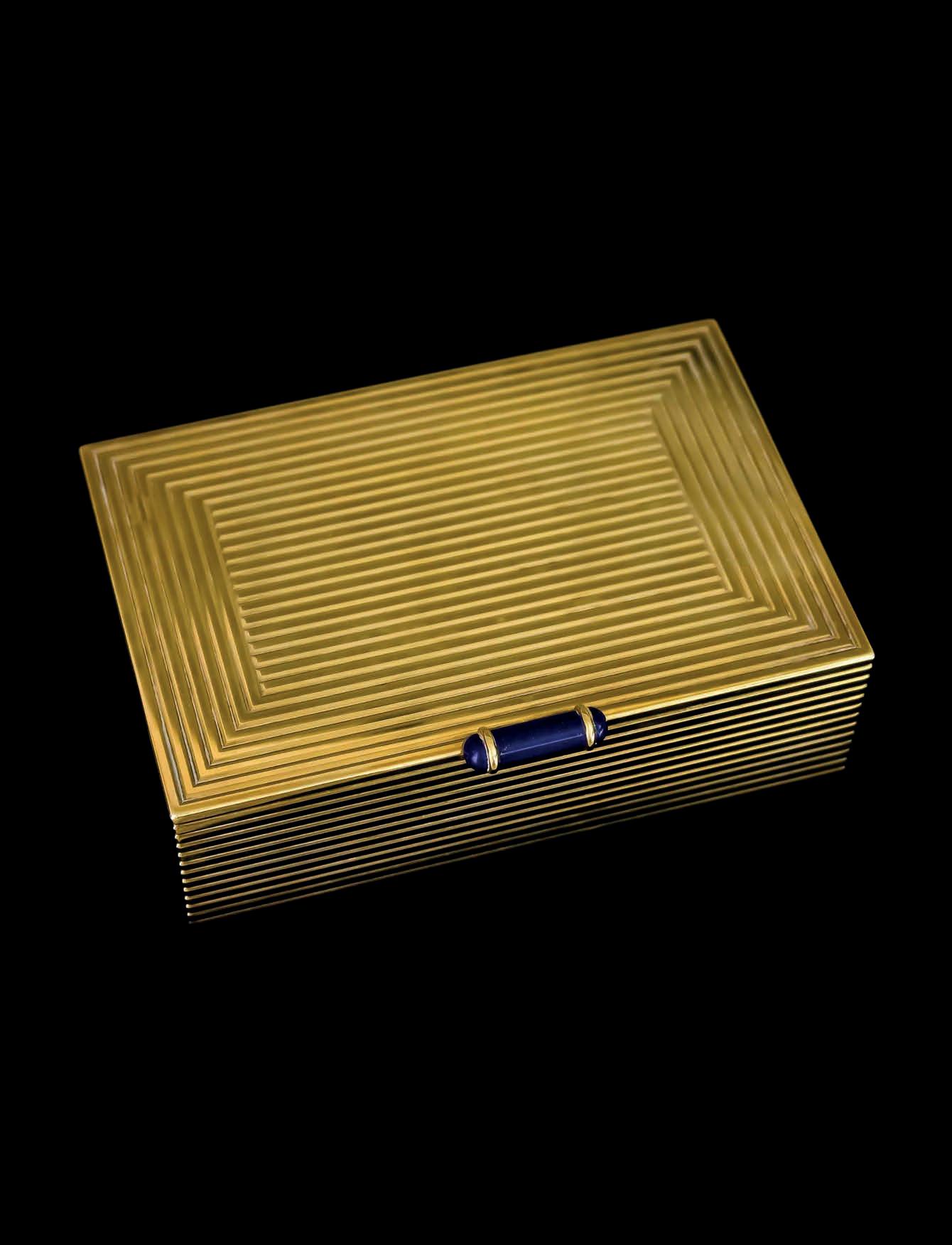
A Frank Lloyd-Wright lamp lights up the auction room in New York, while a sword from the Battle of Flodden slices through its guide price in Nottingham


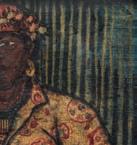
A broken sword believed to have been used at the Battle of Flodden made more than 30 times its pre-sale estimate of £20£30 when it sold for £900 at the Nottinghamshire auction house. e battle, fought on September 9, 1513, near Branxton, Northumberland, was the largest battle England and Scotland





the Scots, with 10,000 killed, compared to English losses of 400e sword came with a label stating that it was unearthed by a plough in Flodden Field, Northumberland in about 1900.



The bronze sculpture was by the Iraqi modernist

The weapon may have been used in the Battle of Flodden in 1513

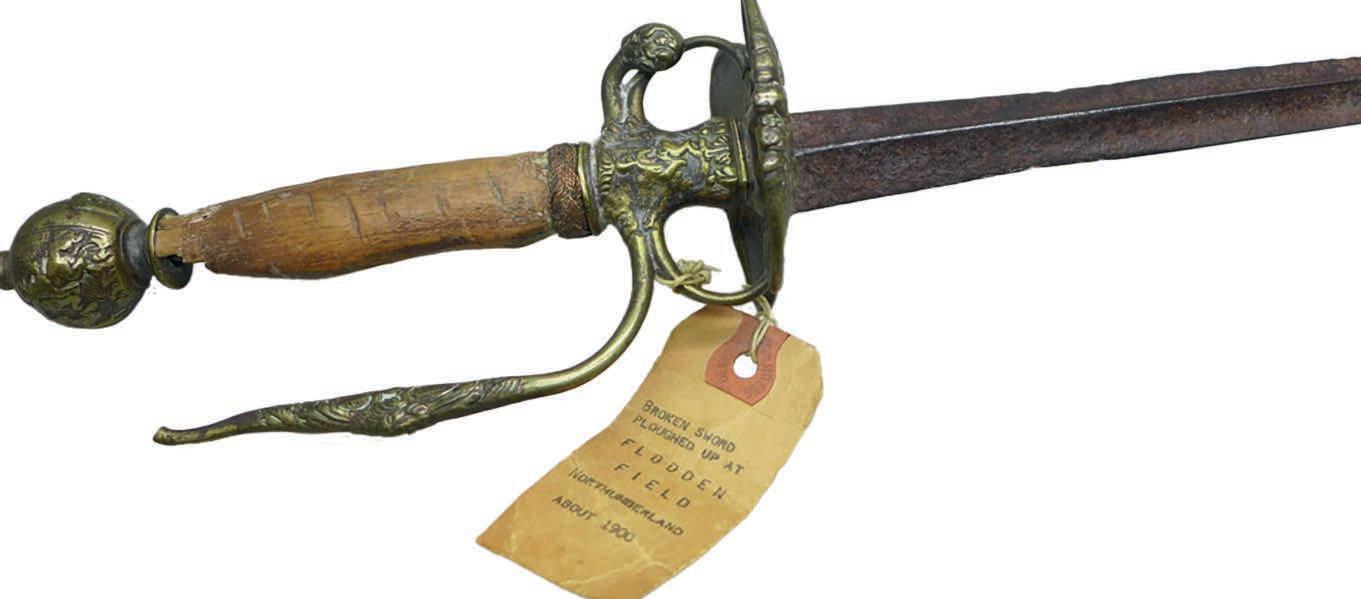





a world reord for a artist


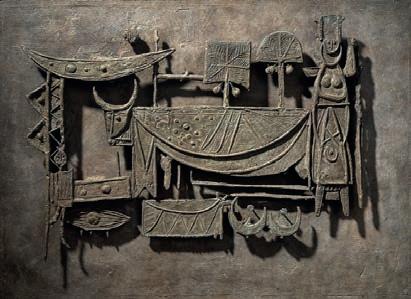
A painting by the Egyptian artist Gazbia Sirry (1925-2021) set a record for a female Egyptian artist when it sold for £216,300 beating its estimate of £170,000-£200,000.
Painted in 1951, A Woman with Water Pots was the earliest work by the artist ever to come to auction. Bonhams’, Nima Sagharchi, said: “As one of Egypt’s most in uential modern artists, Sirry had both a bold visual language and an unwavering dedication to portraying the strength and resilience of Egyptian women.”
At the same sale a bronze sculpture by the Iraqi artist Jewad Selim (I919-1961) sold for £114,700 beating is low guide price of £80,000. Selim was renowned for his iconic public monuments in Baghdad. Pastorale was one of two artworks presented at the inaugural exhibition of the Society of Iraqi Artists in 1957.

An unusual18th-century memento mori needlepoint beat its guide price of £300-£600 to sell for £1.300 at the North Yorkshire house’s textiles sale on May 23.



The tapestry features a skull, a vase with a wilted flower, and arecently blown out candle trailing a wisp of smoke. Below, written in Latin, is the phrase“My days have faded away like smoke.” Pieces of memento mori, which actsas a reminder that life is fleeting, started to appearin the arts from the medieval period onwards. Commonly seen in jewellery or painting, it is unusual to see its message crafted in needlepoint.
Needlepoint memento mori pieces like this one are rare



The red-painted wooden bench sparked a bidding war among Manchester United fans


With bidders from more than 35 countries registered to take part in the sale, it was no surprise fans kicked the price of a red-painted wooden bench from Old Tra ord beyond its £800-£1,200 estimate to hit £40,000 at the Northamptonshire auction house.




After the 1992 Taylor Report into the Hillsborough tragedy, Manchester United replaced wooden benches from the Stretford End with an all-seater stand.
Graham Budd’s, David Convery, said:
“ e price achieved was testament to the popularity of the football memorabilia market, especially related to Manchester United. Two United collectors went head-to-head to win the ultimate man-cave collectable.”



A WWI military cross awarded to a 23-yearold o cer who went on to play for Tottenham Hotspur beat its guide price of £800-£1,000, selling for £1 900 to the London football club. Scots captain James Ross, who served in the North Sta ordshire regiment on the western front, was given the medal for conspicuous gallantry during the Second Battle of the Sambre – an allied o ensive a week before the war’s end.

Military medals including the military cross awarded to James Ross





lamp by the American architect and designer Frank Lloyd Wright (1867-1959) sold

A rare double-pedestal y the American architect and designer Frank Lloyd Wright (1867-1959) sold for a record-breaking £5.9m at the American auction house’s recent sale beating its pre-sale guide price of £2¼m-£3¾m making it the most expensive work by Wright to sell at auction. Wright designed the object, known as the Double-Pedestal lamp and made in his signature Prairie style, for the Susan Lawrence Dana House in Spring eld, I llinois in 1902, at a time when electricity was still a novelty.

The lamp set a record for the most expensive Wright piece at aucion
A 9ct gold cigar box, by Jacques Cartier of London, featuring a lapis lazuli latch jewel beat its estimate of £8,000-£10,000 to fetch £12,500 at the Kent auction house’s recent sale. Jacques Cartier, one of the three Cartier brothers, established the London branch of the famous jewellers in 1902. Under his leadership, it produced pieces in the art deco style, characterised by clean lines and bold geometry, He also had a strong hand in overseeing gold cigarette and cigar boxes, noted for their engineturned patterns, enamel overlays and the use of precious stones.
The gold cigar box had the maker’s mark on the lid along with a lapis lazuli latch
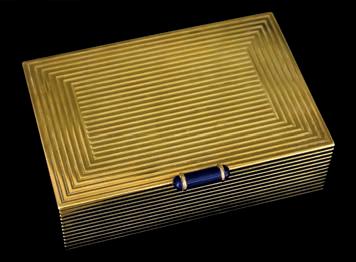
The lot included a squad photograph of the 1923-1924 Tottenham Hotspur team
Ross later played professional football for Tottenham Hotspur between 1923 and 1924 after joining the club from Scottish club Raith Rovers, making seven appearances for the rst division side as a defender.

A Land Rover Heritage Defender 110 once owned by Rowan Atkinson sold for £83,250, beating its low guide price of £65,000 and setting a new world auction record for the model. The vehicle had just 3,800 miles on the clock andwas in pristine condition. The Mr Bean star is an avid car collector having owned everything from McLaren F1s to Lancia Delta Integrales.
e Heritage Edition was limited to just 400 examples featuring a Grasmere Green body, an Alaskan White roof and Heritage-style grill.
The sale of Rowan Atkinson’s Land Rover set an auction record


The impressive candelabra was the top seller from the single owner Georg Jensen collection

A pair of silver twin-branch candelabra by the famous Danish maker Georg Jensen (18661934) was the top seller from a large single owner collection consigned to the Cotswold auctioneer’s recent sale when it fetched £5,500 beating its low estimate of £4,000. Dated 1922, and designed in 1919, the pair, known as model 212, was decorated with leaves and berries. e son of a knife grinder, Georg Jensen trained as a goldsmith before creating his rst piece of jewellery in 1899. His work embraced the prevalent art nouveau style before adopting the more modernist lines of art deco. He employed the talents of leading designers of the day, such as Johan Rohde, Sigvard Bernadotte, and Harald Nielsen. e collection, amassed over 30 years, included atware, barware, writing accessories, lighting, hollowware, and even a timepiece.
A 12-piece set of cutlery by Charles Rennie Mackintosh (18681928) sold for £140,000 at the Scottish auction house, slicing through its pre-sale guide price of £20,000-£30,000.
It had been commissioned in 1902 by Jessie and Francis (Fra) Newbery, then director of the Glasgow School of Art, and included a soup spoon, dessert spoon, dinner fork and dessert fork.
‘Fra’ Newbery, who led the Glasgow School of Art as its international reputation grew between 1885 and 1917, was a strong supporter of Mackintosh’s work and played a crucial role in promoting his career. His wife, Jessie Newbery, was herself an accomplished embroiderer and in uential gure in the arts and crafts movement.
The Mackintoshmade cutlery set was commissioned by the director of the Glasgow School of Art

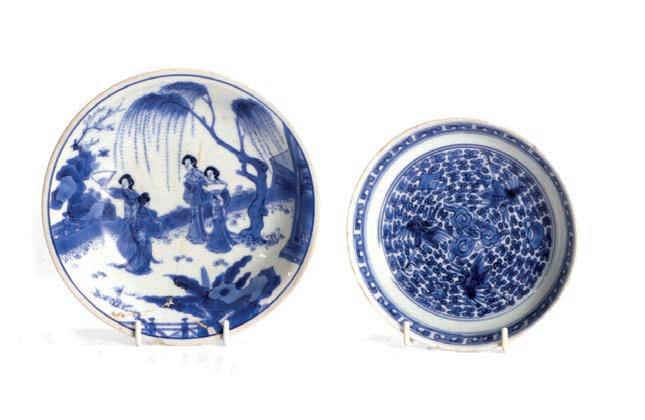
A Kangxi period (1662-1722) blue and white dish expected to make £200-£400 was the top seller from the collection of David and Sarah Battie when it sold for £1,800 at the Essex auctioneer’s recent Asian art sale.
The collection of David and Sarah Battie went under the hammer in Essex
Battie worked for Sotheby’s in the Ceramics and Oriental Works of Art departments from 1965-1999 but is probably best known for his 43 years with Antiques Roadshow, from the rst series in 1977 until his retirement in 2020. He has collected Chinese and Japanese ceramics for much of his career, choosing pieces that tell the story of innovation and cultural exchange, from the elegant restraint of Song dynasty monochromes to the vibrant decoration of Ming and Qing export wares.
An ink onpaper painting by the Ming dynasty landscape artist Wang Shimin (1592-1620) beatits low estimate of £3,000 to sell for £4,000 at the Suffolk auction house’s recent sale.
The ink painting Stream with Pines and Egrets in Flight, is by Wang Shimin one of the masters of the early Qing dynasty
Renowned as one of the most in uential painters of the early Qing dynasty, Wang Shimin was a master of classical Chinese landscape painting. He was the eldest of the “Four Wangs”—the others being Wang Jian (1598–1677), Wang Hui (1632–1717), and Wang Yuanqi (1642–1715). ey were the leaders of the Orthodox school of painting in the early Qing period.



Catherine Southon has her hopes pinned to a collection of needlework samplers going under the hammer at her Kent saleroom this month
have always been interested in hand embroidered samplers. I imagine those tiny hands from centuries past proving their sewing skills while leaving an indelible record of their presence. Names, dates and places frozen in a piece of embroidery. What became of the tiny seamstresses?
So when we took a telephone call from a lady who had inherited a collection of more than 40 samplers, spanning some 300 years, I was keen to discover more.
During the 17th and 18th centuries, samplers were viewed as an essential part of domestic education, used as a teaching tool for girls as young as ve.
As such, early examples tend to be utilitarian in design, featuring rows of letters and practice stitching. e earliest piece in our collection dates to 1709, the reign of Queen Anne. It is fairly unusual to nd such a detailed example in good condition with such strong colour from this period; the exceptionally ne stitching is a wonderful demonstration of the maker’s skill.
Despite being learning tools, many samplers are beautifully executed with intricate embroidery, decorative borders, and vivid imagery. From the mid-18th century onwards, samplers became more decorative, depicting plants, people and animals. e skill and e ort involved in creating them make them valuable as folk art. ey are often signed and dated, sometimes including names, ages, towns, or family mottos. is personalisation makes each piece unique and o ers a glimpse into the life of the maker. One of my favourites from the collection is by Mary Coal, made in March 1774. Mary used an array of coloured silks to display blossoming trees and owerladen vases alongside lines of scholastic text – the hue of which remain remarkably bright. From this date we also start to see the incorporation of more personal details, such as

Above right A George IV needlework sampler by Ann Scott, Boston, 1823, aged eight, including letters and numbers, as well as words from Percy Bysshe Shelley’s poem Witch of Atlas. It has an estimate of £200-£400 at this month’s sale
Below left A Victorian needlework sampler, by Charlotte Butcher, 1840, silk on linen, depicting Adam and Eve under the Tree of Knowledge. It has an estimate of £120-£180 at this month’s sale
Below An early to mid 19th-century needlework sampler by Mary Murton, silk on linen, with alphabet lines. It has an estimate of £300-£500 at this month’s sale
local houses and gardens. An 1809 example by Charlotte Woods includes a gure (perhaps the 12-year-old Charlotte herself) standing beneath a tree outside a typically Georgian house.
By the 19th century, needlework had become a standardised part of the school curriculum. Maps were a common subject, testing geographical knowledge and sewing pro ciency. e start of the Industrial Revolution also saw the introduction of pre-dyed threads, allowing samplers to become more ornate and colourful. Mary, aged 11, has made the most of the new Victorian colours, with her sampler featuring deep blue stags and lively red birds beneath a pink bible verse.
Samplers have seen a recent resurgence in popularity. ey t well into a wide range of collecting categories: textiles, folk art, and even genealogy. eir aesthetic charm also makes them desirable for home décor, especially in a traditional or vintage setting and they also work surprisingly well in contemporary interiors adding character, warmth and a sense of history to a space. In terms of geography the collection includes English, Scottish and even French examples, with one sampler by eight-year-old Ann Scott coming from Boston. All in all, the collection is a fantastic opportunity to own a piece of local domestic history, whether you are a seasoned collector or new to needlework.


e collection of samplers goes under the hammer at Catherine Southon’s interiors sale on June 4. For more details go to www.catherinesouthon.co.uk
‘The start of the Industrial Revolution also saw the introduction of pre-dyed threads, allowing samplers to become more ornate and colourful. Mary, aged 11, made the most of the new Victorian colours, with her sampler featuring deep blue stags and lively red birds beneath a pink bible verse’
Hundreds of lots online with new lots added daily.
Art I Antiques I Books I Carpets I Ceramics I Clocks I Coins I Collectables
Furniture I Glass I Mirrors I Jewellery I Silver I Toys I Watches and morefrom high-end art to low-key bargains. lawrences.co.uk
The Linen Yard, Crewkerne, Somerset TA18 8AB T. 01460 73041 E. enquiries@lawrences.co.uk






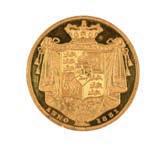

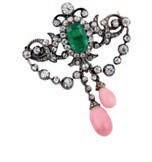
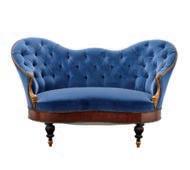
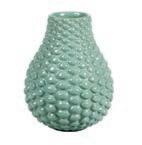

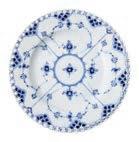
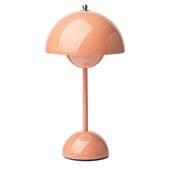
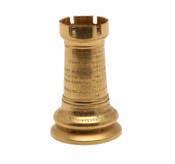




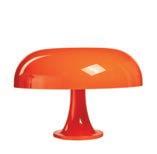
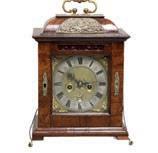





A century on from the birth of art deco in Paris in 1925
Joy McCall looks back at one of the most pivotal events in design history and why for collectors the style will never go out of fashion
The Exposition Internationale des Arts Décoratifs et Industriels Modernes held in Paris in 1925 had been planned to run from April to October but proved so popular it was extended until the November of that year.
It was not especially large by comparison to previous world fairs, but it followed the Turin exhibition of 1902 and was intended to focus on modern consumer goods.
e French government wanted to showcase to the world the country’s architecture, furniture and decorative arts, in part to stem what was seen as the rising threat of German design and industrial production from the end of the 19th century.
e exposition had been planned to take place earlier but was delayed because of fears of impending war. It was ultimately to be the onset of another war – WWII that curtailed the appetite for art deco.
Interest in the style revived in the late 1960s and into the 1970s as people looked back on what was seen as a golden age of luxury. is fascination sparked exhibitions and publications which stirred further awareness.
From then there has remained a steady following of collectors keen to amass art deco items and even to recreate period interiors.
It is estimated 16 million visitors attended the event, which brought together the world’s most in uential architects and designers who were to establish the agenda for the rest of the century.
It was here that French art deco was rst recognised as a style which in turn in uenced other countries to develop their own regional variants. Modernism also arguably made its rst appearance with Le Corbusier’s L’Esprit Nouveau pavilion, while Scandinavian countries presented a new type of aesthetic we would now refer to as mid-century modernism or Scandinavian design.
While art deco, a shortened form of the words arts décoratifs, was recognised as a style early on, the term only came into common parlance in 1968 when the
Opposite page Edgar Brandt (1880-1960) a detail from La Tentation, a patinated gilt bronze oor lamp with a Daum mottled glass shade, designed 1920-1926. It sold for £31,250 in 2021 at Lyon & Turnbull. All images, unless otherwise started, courtesy of Lyon & Turnbull
Right left Encyclopédie des Arts Décoratifs et Industriels Modernes, c. 1925, rst edition, Paris O ce Central d’Editions et de Librairie. 12 volumes. e set has an estimate of £5,000-£7,000 at Lyon & Turnbull’s art deco sale this month
Below left A view of the Exposition Internationale des Arts Décoratifs et Industriels Modernes from Les Invalides, image public domain
Below right René Lalique (1860-1940) Quatre Figurines Femmes Formant Soutien, a cire perdue vase, 1921, signed R. Lalique, engraved France. It has an estimate of £30,000-£50,000 at this month’s sale

academic Bevis Hillier used it in his exhibition and book.
It was an international style as opposed to a movement with no de ning philosophy, or values, no hierarchy or formal structure. It was not based on a coherent framework or manifesto, but re ected the spirit of the age.
As an aesthetic it incorporated all aspects of visual life. From architecture to the interior design, with all the ttings and functional items, as well as decorative arts and so-called ne arts. We see it in furniture, lighting, carpets, textiles, sculpture, glass, ceramics, metalwork, and jewellery. It can also be seen in modes of travel and advertising, especially posters.
Art deco was a style of geometry; clean, crisp lines and bold strident colours, as well as luxurious materials with polished, smooth, shiny and re ective surfaces.
Its streamlined forms spoke of movement, industry and progressive modernity. ere was a fascination with exoticism and the celebration of life, perhaps as a reaction to the past horrors of war and the in uenza pandemic that followed.
It can be seen as a development from art nouveau sharing a high regard for craftsmanship, beauty and good design. Instead of the organic forms of art nouveau, art deco had a greater symmetry in its compositions often drawing on the geometry of Cubism, the colours of Fauvism, the dynamism of Futurism, as well as contemporary life more broadly.



Many of the most sought-after and collected 20th-century designers presented work at the exposition as can be seen if we take a brief look at four di erent materials, namely glass, ceramics, metalwork and sculpture.
Although Emile Gallé (1846-1904) the art nouveau glass designer had died by 1925, his factory, along with that of the Daum Frères presented works in an art deco style. Gallé’s notable pieces include elephant and polar bear vases as well as mould blown designs incorporating owers or fruit. e art deco works of Daum by contrast are characterised by thick, heavy acid-etched glass with patterns of simpli ed geometric designs.
René Lalique (1860-1940) played a leading role in the exposition having changed focus in the early 20th century from his highly successful career as a jeweller into making glass. He was president of the glass category which focused on the architectural and decorative possibilities of the medium. Besides this, he had his own pavilion, oversaw the creation of the dining room of the Sèvres pavilion, created the centrepiece Fontaine des Sources de France on the site, and was heavily involved with designing the perfume pavilion.
His objective was to create high-quality mass-

Lef t René Lalique (18601940) Nanking vase, 1925, clear, frosted and sepia stained, engraved R. Lalique France No. 971 It has an estimate of £8,000-£12,000 at this month’s sale
Right Luc Lanel (18931966) for Christo e, Aux Serpents, two vases, 1919, bronze with green patina and gilt highlights, stamped Christo e 1007. e pair has an estimate of £10,000-£15,000 at this month’s sale
Below left Gabriel Argy-Rousseau (18851953) Gazelles bowl, pâte de verre, 1928, signed in mould G. Argy Rousseau, France. It has an estimate of £7,000£9,000 at this month’s sale

Below right Maurice Gensoli (1892-1973) for Sèvres, vase and cover, c. 1925, glazed stoneware incised M.Gensoli, printed Sèvres mark. It has an estimate of £5,000-£7,000 at this month’s sale
produced glassware without sacri cing standards of design. What he created was a vast range of object types, from scent bottles to car mascots, which still hold sway with contemporary collectors.
ere is also a connoisseur market for his unique cire perdue works made using the ‘lost wax’ technique, being cast like bronze sculptures.
e pâte de verre designers Gabriel Argy-Rousseau (1885-1953) and François-Emile Decorchement (18801971) also took centre stage. Argy-Rousseau who was at the peak of his career was invited to be one of the judges. Pâte de verre mixed powdered glass and metal oxide with more recent innovations enabling designers to create large objects which enjoy an enthusiastic collector base.
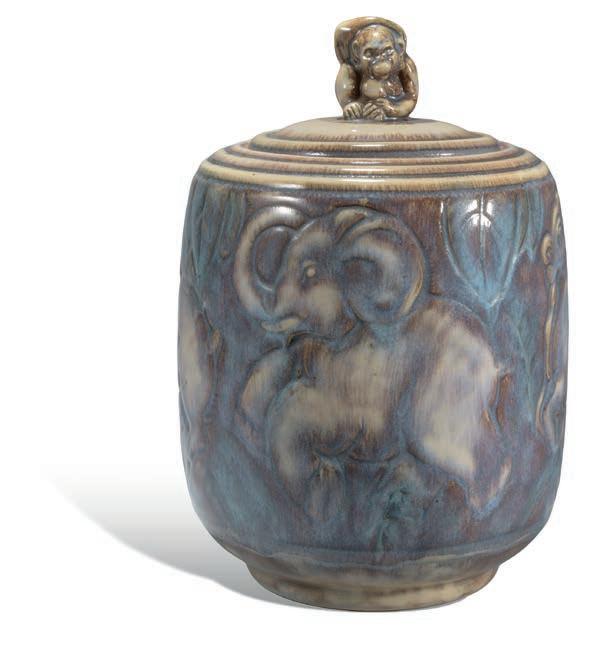
In the eld of metalwork the French designer and ironworker Edgar Brandt (1880-1960) enjoyed great prominence alongside Jean Dunand (1877–1942) and Christo e, the makers of luxury plated silver wares which had its own pavilion.
Brandt was acclaimed for his wrought iron work that combined traditional craftsmanship with modern techniques allowing for greater output and more elaborate designs. His work ranges from small domestic items, such as bookends and ashtrays, to hanging lights and screens, as well as large architectural scale designs.
Consequently, collectors can appreciate his work at a wide range of price points from hundreds of pounds through to more than a million. One of his most icon designs is La Tentation a lamp in the form of a serpent incorporating a Daum glass shade.
e same can be said for Dunand’s work in terms of breadth of price points. He is best known for his lacquer work, an art form he had learnt from Seizo Sugawara, a Japanese lacquer artist.
Like Brandt he also produced screens, Dunand typically executed these in black and red, enlivened with gilt and white.
Christo e produced silver plated wares for functional use, as well as decorative piece vases which are very collectable. Like Dunand these often explore the graphic possibilities of contrasting metallic patinas designed by Luc Lanel which display particularly well in groupings.

Top right Daisy MakeigJones (1881-1945) for Wedgwood, Fairyland lustre Imps on a Bridge vase, c. 1925, glazed earthenware, enamelled with gilt highlights. It has an estimate of £3,000-£5,000 at this month’s sale

Left Edgar Brandt (18801960) La Tentation, oor lamp with a Daum mottled glass shade, designed 1920-1926. It sold for £31,250 in 2021 at Lyon & Turnbull
Below Edgar Brandt (1880-1960) console table, c. 1925, wrought steel and marble. It has an estimate of £4,000£6,000 at this month’s sale
It is not surprising the French ceramics firm Sèvres was given great prominence in the exposition and, again, its work remains sought after by collectors. Perhaps what is more remarkable and less acknowledged is just how many British potteries were shown in the British section. There was a display from Wedgwood that included Daisy-Makeig Jones’ Fairyland lustre wares, lustre ware from Pilkington Royal Lancastrian, high-fired pieces of Ruskin Pottery, as well as ranges from the Doulton and Poole potteries. All of these names still command attention from buyers of antiques and most of them have collectors’ clubs too.
‘Art deco was a style of geometry; clean, crisp lines and bold strident colours, as well as luxurious materials with polished, smooth, shiny and reflective surfaces. Its streamlined forms spoke of movement, industry and progressive modernity’
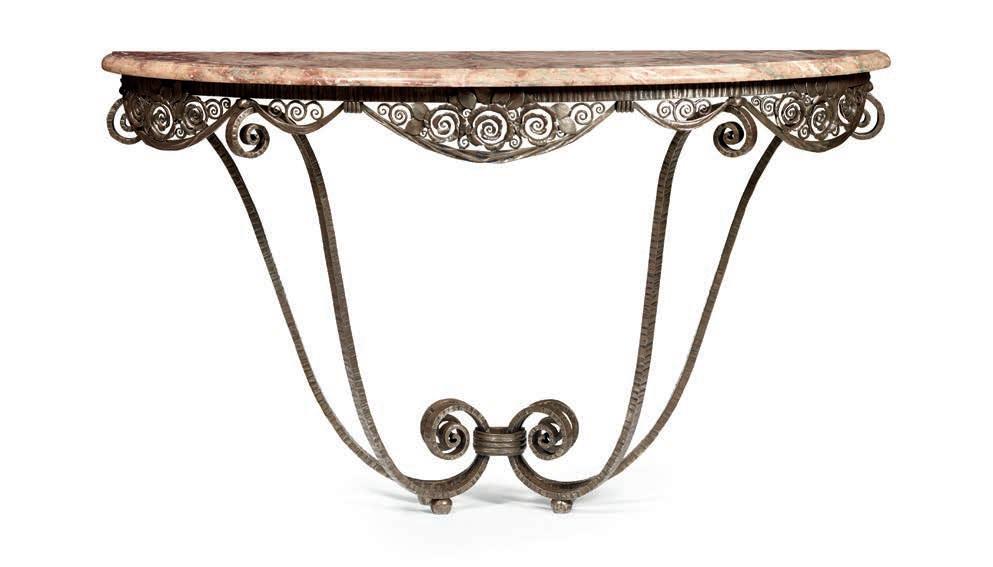

While large sculptural forms were presented at the exposition, one of the distinguishing characteristics of the art deco pieces on show were their smaller scale. Owning sculpture was no longer the exclusive domain of the elite, whose nancial and spatial resources enabled them to display large pieces in appropriate settings.
e rising middle class appreciated works executed on a domestic scale, conceived for a mass market and reproduced according to demand. As a result, the collecting of sculpture began and still continues. In the past, discussions of art deco sculpture would inevitably have involved the mention of bronze and ivory gures, by the likes of Demetre Chiparus and Ferdinand Preiss. However, the market has changed with ivory restrictions coming into place and the focus for collectors is now on materials such as bronze, spelter, ceramics and glass.
Much art deco sculpture took the human form as its subject, or the animal kingdom, and in this regard is in keeping with classical traditions. In both cases they are frequently depicted in a frozen state of motion. e surfaces are smooth and sleek, with contour lines playing a key role. is can be seen in the works of Josef Lorenzl (1892-1950) with his popular dancing gures, or in panthers by sculptors such as the Russian maker Georges Lavro (1895-1991), the French sculptors
Above Claire Jeanne Roberte Colinet (1880-1950) Dancer of Carthage, c. 1920, gilt, patinated and coldpainted bronze, onyx base, signed in cast Cl. J. R. Colinet. It has an estimate of £6,000£8,000 at this month’s sale
Right Josef Lorenzl (1892-1950) patinated and cold-painted bronze, onxy base, c. 1925, signed in cast Lorenzl. It has an estimate of £10,000£15,000 at this month’s sale
‘Owning sculpture was no longer the exclusive domain of the elite, whose financial and spatial resources enabled them to display large pieces. The rising middle class appreciated works executed on a domestic scale, conceived for a mass market’
Maurice Prost (1894-1967) and Emile-Louis Bracquemond (1889-1970), and the Belgian Michel Decoux (1837-1924). It is interesting to note that the same subject was repeatedly addressed by different people.
Inspiration came from other cultures and contemporary life as can be seen in Claire-JeanneRoberte Colinet’s (1885–1972) Dancer of Carthage inspired by19th-century excavations of the ancient ruins in the Gulf of Tunis. Chiparus’ dancing figures were likewise inspired by Sergei Diaghilev’s influential Ballet Russes, with its impressive costumes, that was incredibly popular in Paris between 1909 and 1929.
Joy McCall is a senior specialist in design from 1860 to the presentday at the auction house Lyon & Turnbull which is holding the sale 1925 – Celebrating Art Deco at its London saleroom on June 26. The auction will showcase both worksshown in the exposition and pieces by designers who












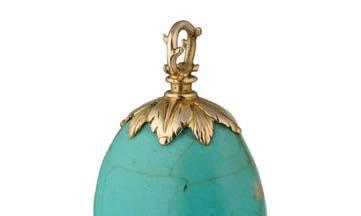

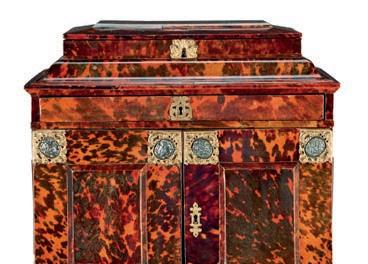


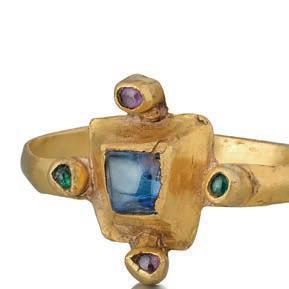









Charles
Hanson
raises a glass to a charming Georgian wine funnel discovered at the back of a Nottinghamshire cupboard
Is there anything that brings the past to life quite as much as antiques relating to food and, even more so, drink?
Imagine this, the year is 1808, a re crackles in the grate, two gentlemen sit opposite each other discussing the news of the day. e conversation moves from the ongoing Peninsular War to the problem of Catholic Emancipation. Alongside both, a decanter of claret rests on a sideboard. After a while, and with an ostentatious ourish (because this was a ceremony intended to impress) the man of the house produces an elegant silver funnel, and the winepouring ritual begins.
So it was, some two centures later, when I came across another such funnel – unearthed from the back of a cupboard in Nottinghamshire – I was reeled back to that sitting room encounter 220 years ago.
Wine funnels emerged at the end of the 17th century, during the reign of Charles II, with the earliest dating to 1661. Pouring liquid from one vessel to another risks spillage – and when it comes to something as valuable as wine this should be avoided at all times. In addition wine responds to gentle handling and doesn’t respond well to being shaken, splashed or generally aerated.
e solution was a small funnel, also known as a “port strainer” which, with the addition of a lter could eliminate sediment of small pieces of cork. While the earliest examples were quite plain, by the mid-18th century, wine funnels had evolved into two-part pieces.
e golden age of the wine funnel appears to have been from the 1760s. A typical example of that date has a broad, hemispherical or ogee bowl with a gadrooned or beaded rim. e bottom is pierced with a geometrical arrangement of holes forming the coarse lter for broken pieces of cork and large pieces of crust.
On the underside of the bowl beneath the lter would have been a small, plain collar which formed one half of the attachment for the spout. e spout, or spiggot, was cleverly curved to allow the wine to gently run down the side of a decanter or glass, avoiding aeration – something which could spoil the wine’s character. Over time, these pieces became larger and more decorative. e example on sale this month has a classic “egg and dart” rim.
Despite signs of use, the hallmarks remain crisp and clear, dating it to London in 1808, during the reign of George III.
Because the majority of wine funnels were made in silver it is a safe bet to assume the drink was generally decanted not in the cellar, but in the main body of the house and by a gentleman and not a servant. After all, who would work objects in silver for his servant’s use?
Indeed wine funnels were elegant and essential dining accessories in the 18th and early 19th centuries representing sophistication on the part of the owner.
Above Charles Hanson with the wine funnel which is o ered for sale this month with an estimate of £200-£300
Below right Wine funnels were a mark of re nement and sophistication
Objects like this one, rich in history and craftsmanship, are increasingly popular at auction. Silver items from the Georgian and Victorian eras – from sh knives to wine funnels – appeal to both collectors and those with an eye for elegant, usable antiques. Something we can all say “cheers” to.
e wine funnel has an estimated of £200- £300 in Hansons Auctioneers’ ne art auction at its Derby saleroom on June 12-13. For more go to www.hansonsauctioneers.co.uk


‘Because the majority of wine funnels were made in silver it may be assumed that the wine was generally decanted not in the cellar, but in the main body of the house and by a gentleman and not a servant. After all, who would work
objects in silver for his servant’s use?’

A 19th-century, brass-cased, eightday chronometer signed Dent, Watchmaker to the Queen, 33 Cockspur Street, London. It has an estimate of £5,000-£10,000

signing his work with the initials “T.C.” By 1845, Cole was calling himself a “designer and maker of ornamental clocks” and, in 1851, he exhibited at the Great Exhibition at Crystal Palace, where he unveiled a new design of a at, portable clock known as a strut clock. But it was for his ingenious mortar clocks, marrying imaginative design with precision engineering, that he became best known. No two of Cole’s mortar clocks are the same: some, like this example (right) were gilded in brass and coromandel, while others were crafted from richly patinated bronze, some incorporating enamel or mother-ofpearl. His work, cut short by his early death from typhoid fever in 1864, remains a lasting testament to the artistry of British horology at its Victorian zenith – a period when military symbols, such as a mortar clock, echoed Britain’s success in global con icts like the Napoleonic Wars and, later, the Crimean War.
A century after Cole’s mortar clocks, the rst half of the 20th century saw Swiss manufacturers battle over the latest technological advances. In 1948, Patek Philippe developed
From a Victorian novelty “mortar” clock to a solar-powered desk timepiece, horological innovation is celebrated at a Bonhams’ clock sale in July
AVictorian “mortar” clock by the celebrated maker omas Cole (1800–1864) is one of the highlights of Bonhams’ clock sale on July 2. e novelty timepiece sees the short barrel of the mortar adapted to house the clock mechanism, while the dial appears on the cannonball. Its maker, Cole, was born in Nether Stowey in Somerset and trained under his father before moving to London in the 1820s. By 1838 he had set up an independent workshop gaining a name for technical skill and artistic air, often
Above left A late 17th-century brass mounted tortoiseshell and boulle tête de poupée (doll’s head) table clock by Louis Ourry. It has an estimate of £8,000-£12,000
Right An advertisement for Patek Philippe’s solar powered clocks. Ilustration only, image Creative Commons

A gilt brass solar-power
clock,
Genève No 70101. It has an estimate of £3,000£5,000


an electronics division exploring nuclear, electronic and photoelectric timekeeping. Soon after it developed an innovative light-powered mechanism with additional storage in an electronic accumulator.
Some of the earliest examples shown in advertisements (below left) from the Basel Fair of 1952 highlight the clock’s ability to “run for 24 hours from energy drawn from [only] one hour’s exposure to light”.
e American market was captivated by the new technology and the clock’s launch was celebrated by a US tour, with the timepieces displayed at prestigious venues including the Museum of Science in Boston, Massachusetts.
e trademark domed top was designed to be rotated to better face a light source.
The sale also includes a Japanese hashiradokei weight-driven pillar clock. Such clocks were designed to measure time according to the “temporal hours” of a day. As the seasons changed, so too did the length of each of these hours with the summer having longer daylight hours and shorter night-time hours.
WHAT: Fine clocks
Where: Bonhams, 101 New Bond Street, London, W1S 1SR
When: July 2
Viewing: June 29 to July 2 and online at www.bonhams.com
We asked Bonhams’ head of clocks, James Stratton, for his sale highlights
Do you have a favourite clock?

Above left A rare mid 19th-century gilt brass and coromandel “mortar” timepiece by omas Cole, stamped London No.1653. It has an estimate of £4,000-£6,000 in the July sale
The foliot balance has a series of notches and weights which allow a twice daily adjustment at the end of each six-hour period. The clock has an estimate of £1,500-£2,000.
Meanwhile, a late 17th-century tête de poupée (doll’s head) table clock by the French maker Louis Ourry has a guide price of £8,000-£12,000. Ourry, originally from Blois was active in Paris until his death in 1699, when his widow continued the business from the Quai des Orfèvres in Blois.
His work is represented in several major collections, including the British Museum, the Louvre, the Musée des Arts Décoratifs and the Château de Versailles.
Above A mid 19th-century Japanese weight driven hashira-dokei wall clock. It has an estimate of £1,500-£2,000
‘During the Victorian period military symbols were deeply intertwined with ideals of strength, heroism and imperial power. Britain’s success in global conflicts like the Napoleonic Wars and, later, the Crimean War, had made martial imagery fashionable among the upper classes’

The small tête de poupée clock by Charles Ourry is a super piece. At just 25cm (10in) tall and 12½cm (5in) wide, it can sit on any mantel piece, bedside cabinet or display case. Smaller clocks are always popular, and this is no exception. The sinuous case is covered in turtle shell, laid on a red-coloured ground, which gives a fantastic contrast to the naturally-occurring patterns in the shell. It has also been mounted and inlaid with brass in the manner of the great French designer André-Charles Boulle.
Are there any examples of horological innovation in the sale?
Many of the pieces are among the most innovative examples of their time. One in particular is the Patek Philippe solar-powered clock, made during the 1950s Space Race era. It feels incredibly futuristic even today, incorporating a solar design that powers a mechanical movement without the need for winding. The electricity generated by the sun is enough to drive the mechanism, offering a brilliant and elegant solution that was well ahead of its time.
Where will interest come from?
Classic English table clocks tend to attract collectors from the UK and US, while the French and German clocks — known for their beautiful decorative appeal — often sell to a European or Asian audience. We also have some Japanese clocks, which will appeal to collectors looking for something different as they show a fascinating way of reading and understanding time.
Do you have a favourite clockmaker?
Makers whose work is consistently high quality include the lantern clock maker William Bowyer, the table clocks of Thomas Tompion, the longcase clocks of Ahasuerus Fromanteel, the travel and precision clocks of Abraham Louis Breguet and, finally, the engraved fancy cases of Thomas Cole. Moving into the 20th century, I would have to include Cartier, in particular its amazing mystery clocks.
Is there one clock you would love to own?
If money were no object, it would have to be a carriage clock by Abraham Louis Breguet – his work was lightyears ahead of its time. He didn’t follow any rules on what a dial should look like. A silver example in its original travel case would be lovely.

Known to most for its cars, the Bugatti family was one of the creative powerhouses of the 20th century. On the eve of a new exhibition,
Antique Collecting reports on a remarkable Italian dynasty
For most, the word Bugatti conjures images of sleek cars from the golden age of motoring –designs that seamlessly blended artistry and mechanical perfection. But for collectors there is more to the famous name than its cars. is month’s Treasure House Fair in London showcases 30 designs from the remarkable family, including its patriarch, Carlo (1856-1940), the art nouveau furniture maker whose fantastical designs paved the way for the likes of Piero Fornasetti. Alongside these outlandish designs can be seen the work of his son, the sculptor Rembrandt (1884-1916) as well as Carlo’s other son, the epoch-de ning car engineer Ettore (1881-1946) the name behind the Bugatti fame today.
rough their considerable talent, fertile imaginations, technical virtuosity and pioneering amboyance, three generations of creators produced completely unique bodies of work. Exhibition curator, Edward Horswell, said: “ e multi-generational accomplishments of Carlo, Ettore and Rembrandt are phenomenal. Beside their immense creative range, each was a pioneer of their respective elds, creating completely new aesthetics, and demonstrating an unabated pursuit for perfection.”
is month’s display will feature a chair and desk (above right), made at the turn of the 20th century by Carlo Bugatti for his long-time friend, the painter Giovanni Giacometti, father of Alberto Giacometti. e set created in Carlo’s distinctive and instantly recognisable style, with abundant use of parchment and painted decorations, was a central piece of the Giacometti’s Swiss studio. e exhibition will also include a rare silver tea set – unique for the period and a testament to both Carlo’s inventive imagination and his rapid mastery of working with silver.
Furniture by Carlo Bugatti is like no other. His were fantastical designs with tassels, carved wood, inlaid with brass and pewter, and sheathed in vellum and parchment.
Recently rediscovered by design a cionados, his designs anticipated the stylised and geometric forms of art deco, 20 years before the movement became known.
He took inspiration from Islamic and Japanese decorative traditions, as well as Romanesque architecture, creating amboyant pieces unlike anything seen before, or since.
Carlo Bugatti was born in Milan on February 16, 1856. While little is known of his early life, or the profession of his parents – the family claimed descent from the 15th-century
Opposite page Carlo Bugatti (1856–1940) throne, c. 1900, walnut, ebonized walnut, hammered copper, painted parchment, inlaid pewter, inlaid brass and silk tassels. Expected to make $12,000-$18,000, it sold for $70,350 at Bonhams Los Angeles’ sale of the Peter Mullin collection on July 24, 2024, image courtesy of Bonhams, not on show at this month’s exhibition
Right Chair and desk, c. 1904 made by Carlo Bugatti (1856–1940) for his long-time friend Giovanni Giacometti, and thereafter in the studio of Alberto Giacometti, part of this month’s exhibition
Below Carlo Bugatti, c.1865
Below right 1925 Bugatti Type 39 works Grand Prix car © courtesy of the owner, part of this month’s exhibition
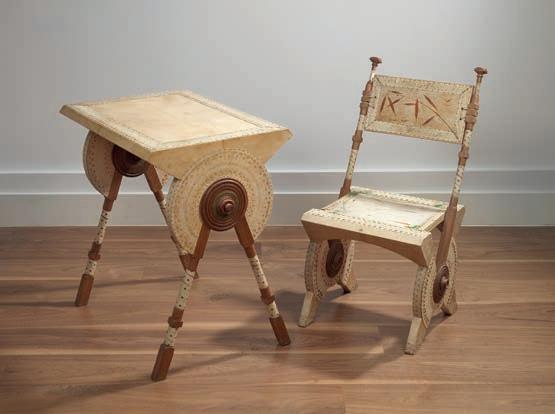
Milanese painter Zanetto Bugatti and the 17th-century engraver Giovanni Francesco Bugatti.
Carlo studied at the Brera Academy in Milan and at the Académie des Beaux Arts in Paris, kickstarting a love of the country that would last a lifetime.
His obvious artistic abilities earnt him the nickname “the young Leonardo” with his precocious talents matched by his personal amboyance – from an early age he designed his own clothes.
Towards the end of the 1860s, Carlo began working for a cabinetmaker in Milan opening his own workshop in the city with one of his rst known pieces, a bedroom suite which was a present for his sister Luiga and the artist Giovanni Segantini.
In 1888, he exhibited a number of pieces at the Italian Exposition in Earl’s Court, London with a write up in the newspaper e Queen describing his furniture as “quaint”. His designs melded a number of ethnic motifs, though Bugatti never travelled to Asia or made any formal study of non-western design.
e 1890s were the heyday of Bugatti’s furniture production. e rst phase of his furniture making saw his use of heavy, ebonised wood inlaid with copper, brass, ivory, mother of pearl or camel and deer hide which he then decorated with fringes or metal discs, or stencil

‘The first phase of Carlo’s furniture making saw his use of heavy, ebonised wood inlaid with copper, brass, ivory, mother of pearl or camel and deer hide which he then decorated with fringes or metal discs ’ a


work of oriental calligraphy or with ower, animal or insect motifs. But at the turn of the new century, his style changed. His love of vellum increased, to the point where he was wrapping entire pieces of furniture in the material allowing it to smooth over all the hard edges. Ornament was reduced drastically, and the forms became simpler, lighter, and more curvaceous.
In 1902, Bugatti unveiled his famous “snail” room at the rst International Exhibition of Modern Decorative Arts in Turin. e remarkable design was based on a spiral and lled with extraordinary sculpture-like furniture. At the centre of the room was a semicircular banquette with drinks cabinet that was made to look like a snail’s shell. Alongside were four Cobra chairs now considered to be one of the most avant-garde pieces in Bugatti’s oeuvre. Each was entirely covered with parchment and decorated with Indian ink designs of stylised owers and insects. e design earned Bugatti a Grand Prix d’Honneur for being “the rst in Italy to create, and not just to dream, a modern style of furniture”.
Despite the accolade the exhibition marked the beginning of the end for Bugatti’s furniture designs. His theatrical experimentation with new materials like vellum failed to attract clients. On the brink of bankruptcy, he was forced to close his workshop taking his family to Paris. In 1904, he opened another workshop, producing luxury items for clients such as the Bon Marché department store. In the French capital he met Adrien-Aurélien Hébrard (1865-1937) the publisher, art dealer and foundry owner who convinced him to start sculpting and who, in 1907, held an exhibition of his silverware.
Below left Bugatti’s design for the Snail room for the rst International Exhibition of Modern Decorative Arts in Turin, image Creative Commons
Bottom left A Cobra chair and table, image courtesy of Brooklyn Museum, Creative Commons
Below right Rembrandt Bugatti (1884-1916), Hippopotamus Yawning, 1905, unique cast © Sladmore Gallery, London, part of this month’s exhibition
Rembrandt was the family’s second son, born in Milan on October 16, 1884. For too long after his death, Rembrandt was dubbed ‘the other Bugatti’, but he left behind an exceptional body of work which has steadily grown in importance, not to mention value, along with his reputation. Named after the Dutch master Rembrandt van Rijn, there was little doubt as to the artistic expectations pinned to him. And he didn’t disappoint.
Surrounded by his father’s cultural associates, including the Alpine impressionist Giovanni Segantini (his uncle) and the sculptors Ercole Rosa (his godfather) and Prince Paolo Troubetzkoy, Bugatti soon began working with clay and wax. He surprised his father by leaving a fully formed sculpture of a cow and its herder (bovines being one of his earliest themes) when aged only 15. He showed work at the 1903 Venice Biennale followed by exhibitions in his Milan hometown and Turin.
When the family moved to Paris in 1904, Rembrandt became immersed in the Parisian belle époque. But for the young sculptor it was the city’s Jardin des Plantes, one of the greatest zoological gardens in Europe, that provided the real lure and grabbed his artistic vision. For the next decade Bugatti lived among the animals, creating “sketches” in clay or plasticine, always nishing the piece on site directly in front of the animal itself. In this way he captured yaks, secretary birds, elephants, lions and kangaroos, introducing them into European art as sculpted subjects for the rst time.



Panthers were a particular favourite, with Bugatti depicting them as living, breathing beings full of energy,
‘For the young sculptor it was the city’s Jardin des Plantes, one of the greatest zoological gardens in Europe, that provided the real lure and grabbed his artistic vision’


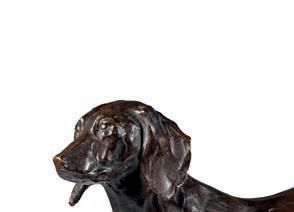
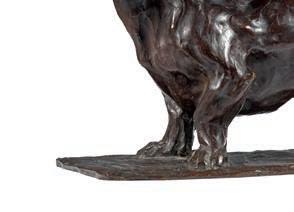


emotion, and character. In Panthere Devorant, Bugatti represents the cat quietly feeding on its prey, which he depicts with reverence and respect.


Bonhams’ specialist Ruth Woodbridge, said: “By choosing to sculpt freehand, Bugatti presented animals as if in motion in a way that is both precise and complex. His works show a wonderful understanding of the animal he’s sculpting and of his works, his big cat sculptures are his most desirable.”






Adrien-Aurélien Hébrard, already known to his father, also played a great part in Rembrandt’s career. Every year, Hébrard exhibited Bugatti’s new works in his gallery located on rue Royale, Paris. Every ve years, he organised a retrospective which would tour between the o cial French and foreign Salons of the day, in Venice, Milan, Brussels, Berlin, Antwerp, and New York.
By 1906 Bugatti’s gaze had turned to Antwerp’s zoological garden where, as in Paris, he immersed himself in the life of its animals.
But with the outbreak of war in 1914, Bugatti took up work as a nurse-assistant at the city’s military hospital. Shaken by the tragedy he was witnessing daily, he was devastated when, in 1915, animals from the zoo were put to sleep due to food shortages. Despite continuing to sculpt, Bugatti struggled with depression as well as tuberculosis. Short of money and in fragile mental health, his nal works, including haunting representations of animals in distress or isolation, re ected his deepening despair. Returning to Paris, he committed suicide by gassing himself in his Montparnasse studio in January 1916.
But Rembrandt left behind an exceptional body of work which has steadily grown in importance, not to mention value, along with his reputation. In fact, his work now sells for more than the cars of his elder brother and furniture of his father.
Highlights in this month’s exhibition include some of his most iconic works, as well as more personal pieces, such as a life-size portrait of Rembrandt’s own dachshund, Wurst.
His brother Ettore honoured Rembrandt by naming the Bugatti Type 41 Royale, after him and adorning its hood with a replica of one of Rembrandt’s most famous sculptures, a dancing elephant.




Top left Rembrandt Bugatti (1884-1916) Mon Chien (my dog), 1906, bronze © Sladmore Gallery, London, part of this month’s exhibition
Above Rembrandt Bugatti modelling c. 1909
Top right Rembrandt Bugatti(1884-1916) a family of greater kudu, La Mère blessée ( e Injured mother), 1911, part of this month’s exhibition
Above right A Bugatti Royale elephant replica mascot designed c. 1927 cast after an original bronze sculpture by Rembrandt Bugatti. It sold for $3,840 at Bonhams Los Angeles’ sale of the Peter Mullin collection on July 24, 2024, image courtesy of Bonhams, not on show at this month’s exhibition
Right A trunk once owed by Ettore Bugatti, stamped EB, estimated at $3,000-$5,000 it sold for $19,200 at the same sale, image courtesy of Bonhams, not on show at this month’s exhibition





Rembrandt’s older brother, Ettore gave up on art when he realised that he lacked his younger brother’s talent. He wrote: “There are two types of artists. Those who are born artists … My brother was one of them. The other type, to which I belong, are those who try and create art but are not as gifted ... One day they should wake up and realise that they ought to do something else.” Ettore chose engineering. Aside from cars, Ettore patented more than 1,000 inventions, from safety razors to pasta machines. The cars he and his son, Jean, designed in the first half of the 20th century are today credited as some of the fastest and most glamorous ever built. This month’s exhibition includes a 1925 Type 39. Also celebrated is the achievement of Jean Bugatti, Ettore’s eldest son who helped his father design the Bugatti Royale and the Type 57 models.







But as with his uncle, Jean’s legacy continued with his designs. Bugatti cars combined luxury and aerodynamics, with an unmistakable art deco aesthetic, making them some of the most brother was one of them. The

But on 11 August 1939, aged 30, Jean died when he crashed the car he was testing to avoid a cyclist. His death added another layer of tragedy to the family still affected by the death of Rembrandt 23 years earlier.

We asked this month’s exhibition curator and Bugatti devotee, Edward Horswell, why he finds the Italian family so beguiling
Q
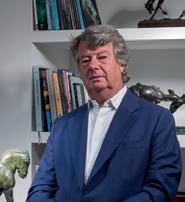

When did you first get to know the Bugattis?
A My mother and father were passionate collectors of Rembrandt Bugatti’s sculpture, so I was introduced to his work from an early age. Early childhood memories are of holidays to Paris, with frequent museum visits and fun trips to the flea market. In 1979, I visited the ground-breaking exhibition focusing on the Bugatti family at the Royal College of Art, London, which ignited a lifelong interest.
Q
A
What do you find most impressive about each of them?
Carlo’s rich cocktail of Moorish and Byzantine influences and his faith in traditional hand skills, combined with radical daring make him a peer of international figures such as Charles Renee Mackintosh and Louis Comfort Tiffany. At the same time, his style is quite unique, and pays homage to pure design, with works such as his legendary Cobra chair and little-known avant-garde silverware. Rembrandt is one of the most talented and individual sculptors of the 20th century, creating a prodigious body of work in his short career. His art combined huge technical finesse, formal beauty, intensity of expression and subtle stylistic inventiveness. He revived the animal as an artistic subject, bringing to this tradition his own vision, empathy with the animals and truth to observation.
Q How would you describe the Bugatti collector?
A Passionate and with a good eye. Many collectors of specific




Above Rembrandt
Bugatti (1884-1916)
Léopard au repos, conceived c. 1911 and cast by A.A. Hébrard in a numbered edition of 23.
Estimated at £180,000£250,000, it sold for £216,300 at Bonhams on April 2, image courtesy of Bonhams, not in the exhibition
Below Rembrandt
Bugatti (1884-1916)
Petite panthère assise, conceived in 1912 and cast by A.A. Hébrard in a numbered edition of 10.
Estimated at £150,000£200,000, it sold for £222,650 at Bonhams on April 2, image courtesy of Bonhams, not in the exhibition



aspects of the Bugatti Family, because of the

aspects of the Bugatti family, because of the wonderful design vein that runs through all of them, are tempted to ‘fi ll out’ their collections with works by other family members.
But it is a hard habit to kick, so it is not often that these are dispersed on the open market. Public collections, such as the Museed’Orsay in Paris hold a substantial number of Rembrandt’s plasters and Carlo’s furniture, as does the Cleveland Museum in the US. In addition, most of the exhibitions on the Bugatti family over the last 50 years have been mounted by museums around the world.
QDo you collect their work?
AI do collect their work, I feel it is in my blood and plan to continue for many years. While I have bought and sold most sculptures by Rembrandt I would love to have an example of his Sacred Hamadryas Baboon at home. For Carlo, I definitely covet the Cobra chair and for Ettore it would have to be his Type 50 Grand Prix car in this exhibition – the classic racing Bugatti and this example is as authentic in every detail as they come.
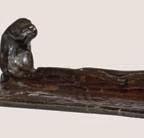






AQWhat was their lasting legacy on Italian and global design?
Rembrandt’s key works are now recognised as classics of 20th-century sculpture, his works have stood the test of time, despite changing tastes and artistic styles and they continue to resonate with each new generation. The strength of his sculptures, their sense of composition, balance, movement, positive and negative space, contour and texture remains undeniable. This, coupled with the psychological and spiritual element of his work has left a lasting legacy.
Carlo’s unique designs helped to usher in the art nouveau movement and later develop what would be known as art deco. He was very much part of a progressive trend in European art which spawned the arts and crafts movement.
Ettore’s cars are beautiful both on the outside and under the bonnet. He was a designer at heart and if he thought that he could improve on an object or an engineering device he would redesign it, hence he holds more patents than anyone - from motor components, to bench vices to pasta making machines. He continues to inspire young designers around the world.

Rare to appear at auction, works by the Bugatti family achieve huge prices when they do – sought after by collectors around the world for their quirkiness and craftsmanship
On July 24, 2024, Bonhams Los Angeles presented the largest collection of Carlo Bugatti pieces ever to be o ered at auction. Some 60 pieces by the Italian maker were part of the sale of the Peter Mullin collection, which sold for a total of $2.43m with 80 per cent of the lots doubling their estimate or more.
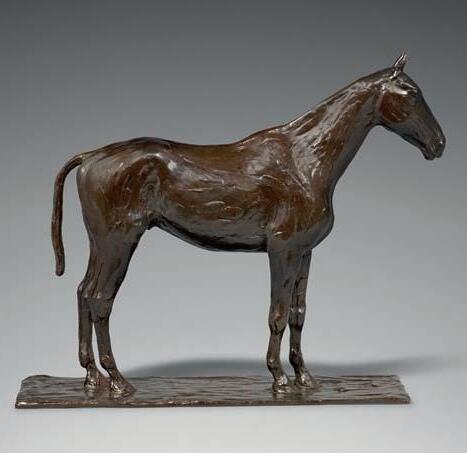
Above Carlo Bugatti (1856–1940) a rare dragon y bowl c.1907, executed by A.A. Hébrard, estimated at $80,000-$120,000 it sold for $191,000 at Bonhams Los Angeles’ sale on July 24, 2024, image courtesy of Bonhams, not in this month’s exhibition
Below left Lidia Bugatti (1907-1972), Cheval debout, 1935. It sold for $191,000, 27 times its estimate of $7,000-$9,000 at the same sale, image courtesy of Bonhams, not in this month’s exhibition
Bonham Los Angeles’ head of modern decorative art, David Trujillo, said: “Only a handful of works by Carlo Bugatti tend to be o ered at auction every year, so this sale presented an unprecedented opportunity to delve deep into the artist’s oeuvre and acquire a superb work by the famed designer.
“ is was a once-in-a-lifetime auction, and the collector response to this incredible collection is re ected in the exceptional results we achieved.”
For the prominent American businessman and philanthropist Peter Mullin (1941-2023), art deco was the supreme expression of artistry and industrial design. As well as owning the most impressive collection of pre-WWW Il Bugatti vehicles in the world, his passion for the Bugatti design aesthetic and art deco movement extended to the entire Bugatti family even Lidia Bugatti (1907-1972), Ettore’s daughter, who was known for her paintings and animal bronzes. In fact, her 1935 sculpture of a horse, Cheval debout, sold for $191,000 – 27 times over the estimate of $7,000-$9,000, setting a record for her work at auction.
One of the sale stand outs was a rare, silver dragon y bowl made towards the end of Carlo Bugatti’s career, perhaps the only one of its kind in existence.
While Carlo’s trademark theatrical furniture is more famous from 1900, around the time of the Paris Exposition Universelle, he also worked with silver with his designs following the same fantastical, exotic, and Moorish-in uenced style seen in his furniture. His range included bowls, chalices and small table items with some even incorporating Arabic-inspired calligraphy, nature motifs, or geometric designs.
In 1907, he created a number of boar’s head,
‘One
of the sale
stand
outs was a rare silver dragonfly bowl made towards the end of Carlo Bugatti’s career, perhaps the only one of its kind in existence. While Carlo’s furniture is more famous — bold, exotic, and richly detailed — he did also work with silver, though less extensively’

elephant-trunk and dragon y-themed tableware sets, with the animal themes perhaps a nod to the contemporaneous work of his son, Rembrandt.
e 1907 silver bowl which sold last July had been expected to sell for $80,000-$120,000 but fetched $191,000, proving the demand for Carlo’s work.
Last June, Bonhams Cornette de Saint Cyr in Paris set a record at auction for a work by Rembrandt Bugatti when it achieved €3.7m for a rare bronze sculpture of three walking panthers.
Conceived and cast in the French capital in 1905, the sculpture comprises a trio of brilliantly interlinked wild cats following each other, loping with as much menace as charm across some imaged veldt, a wide-open, empty space. e interlocking elements required such a highly complex bronze casting process, the founder Hébrard produced only one sculpture, forsaking any further editions.
Above Rembrandt Bugatti (1884-1916)
Petit léopard marchant, conceived c. 1912 and cast by A.A. Hébrard in a numbered edition of 16. Estimated at £220,000£350,000, it sold for £406,800 at Bonhams’ sale on April 2, image courtesy of Bonhams
Right Rembrandt Bugatti (1884-1916)
Trois panthères, set an auction record in Paris last year when it sold for €3.7m, image courtesy of Bonhams
Below leftt Rembrandt Bugatti (1884-1916)
Jaguar Accroupi, conceived c. 1908 and cast by the A.A. Hébrard in 1909. Estimated at $70,000-$90,000 it sold for $152,900 at Bonhams Los Angeles sale on July 24, 2024

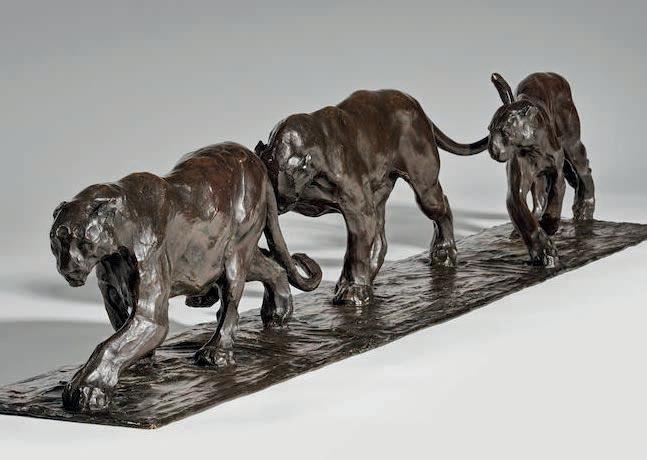
In April this year at Bonhams New Bond Street, three big cat sculptures by Bugatti also shone, with a sculpture of a leopard beating its guide price of £220,000-£350,000 to sell for £406,800, while a sculpture of a standing leopard, selling for a mid-estimate £216,300. At the same sale a seated panther, with a guide price of £150,000-£200,000 sold for £222,650.
In Bonhams Magazine, Adrian Dannatt wrote: “ e three big cats come from the richest period of his Bugatti’s career, beginning in 1911 when Hébrard exhibited at their Paris space an ambitious menagerie of a hundred of his bronze animals and culminating in 1912 when he was o cially invited to show his works in the Olympic Games.
“ e trio demonstrates the full technical perfection for which Hébrard were celebrated and all the vivid energy, and the sheer anthropomorphic symbolism of Bugatti’s singular skill.”
e exhibition e Brilliant Bugattis takes place in the foyer of the main hall at the Treasure House Fair at the Royal Hospital Chelsea from June 26 to July 1. It includes a range of works by Carlo, Rembrandt, Ettore and Jean Bugatti including sculpture, decorative arts and cars. For more details go to www.treasurehousefair.com. For more details on visiting the fair turn to page 59.


Glass bottles from the 500,000-strong packaging collection of the social historian Robert Opie are on show as part of a new exhibition. He explains his lifelong collecting obsession
Why did you start collecting?
Most children collect something, or at least they did when I was at school. Perhaps there are too many distractions today. I found an interest in coins, stones, stamps and the Lesney Matchbox series.
is was my apprenticeship in how to collect. Within philately I branched away from the mainstream and into the ‘Cinderella’ world of non-adhesive stamps from postal stationery to stamp booklets.
But, even then, I found there were already other collectors breaking new ground. Instinctively I wanted to be a pioneer. One day it struck me. Packaging. It was 1963, I was 16 years old, and the supermarket was in its infancy.
Here was a subject seemingly no one else was collecting or studying, and yet packaging had both a point and a purpose and a massive story behind it.
Even though wrapping has a throwaway history, it played a vital role in branded goods and had in many ways transformed the way we lived.


I came from a family where collecting was not only encouraged but expected. My father created an important archive of early children’s books, the best in private hands which went to the Bodleian Library on his death, by which time their signi cance was becoming recognised.
When I was a child and keeping Lesney Matchbox cars in their boxes, it was my father who said I should annotate them with the date and price.

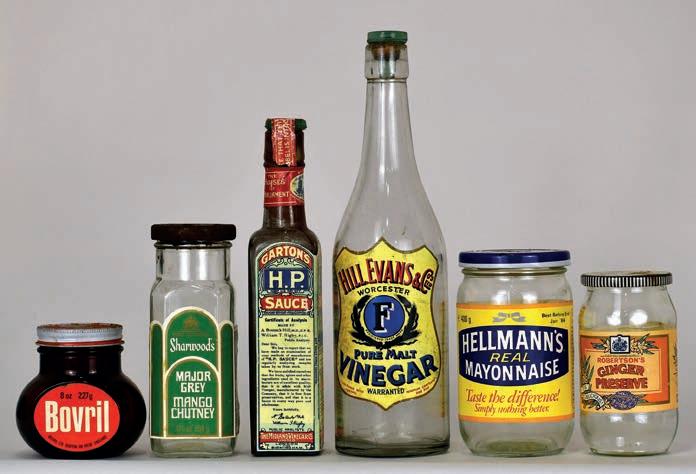
In 1969, the Round Pond in Kensington Gardens was being drained for the rst time in 30 years. ere, among the mud ats, were some Express Dairy milk bottles from the 1930s. I ventured out and rescued six examples. e chase had begun.
In the early years of collecting packaging and bottles, it was di cult to know how much material was going to survive. It was nevertheless exciting to start putting together what was to become some giant jigsaw puzzle, not knowing what might turn up.
Above Heritage food brands, including Bovril and Garston’s HP Sauce reveal the UK’s social history
Above right Robert Opie is known for his jigsaws produced by Gibsons
Below Georgian and Victorian bottles are among Opie’s recovered treasures
‘While some may consider the brands to be nothing more than rubbish, it is among the fragments of daily living that we are psychologically and socially rooted. This is where the impulses of our society can be found’

Known to jigsaw enthusiasts around the world, Robert Opie is a British historian and collector renowned for his extensive archive of British consumer culture focusing on packaging, advertising and branding.
In 2009, he won a UK Packaging Award for Outstanding Contribution to the Industry and has compiled more than 20 books, including the scrapbook series covering each decade from the Victorians to the 1970s.
In collaboration with puzzle manufacturer Gibsons, Opie curated a series of jigsaw puzzles celebrating British cultural history with titles including, Spirit of the 60s, Sweet Memories of the 1980s and The Brands That Built Britain. The latter is a 1000-piece puzzle displaying classic British brands such as OXO, Kellogg’s, Marmite and McVitie’s, reflecting the nation’s favourite foods.

In 1973, I approached the V&A to stage an exhibition of my entire collection of packaging.
It opened two years later with about 3,000 items e Pack Age; A Century of Wrapping It Up. e media loved it, and so did the public. It was packed from start to nish. e Sunday Times wrote:
“Advertising like this provides some of the wittiest clues about the impulses of our society.”
Following that success, I opened Britain’s rst museum devoted to the history of advertising and packaging in Gloucester in 1984. Now known as the Museum of Brands, Packaging and Advertising, it moved to its current Notting Hill location in 2005.
On show are around 12,000 objects from the collection of an expanding 500,000 pieces which includes a lot of social history materialposters, pamphlets, song sheets, magazines and newspapers, toys and games, travel and transport, entertainment, royal souvenirs, plus things to do with the Great Exhibition of 1851 and the two world wars.

When your collection went on display, what memories did it spark?
Much of the interest was due to the memories the brands generate – from happy holidays to Christmas parties. Complete strangers found a shared memory triggered by a brand whether it was Marmite, HP Sauce, Kellogg’s Corn Flakes, Spangles, Lyon’s Individual Fruit Pies or Rose’s lime juice. Among the visitors there was a continual wave of nostalgia and murmuring of reminiscence.
While some may have considered the brands to be nothing more than rubbish, it is among the fragments of daily living that we are psychologically and socially rooted. is is where the impulses of our society can be found.
‘Complete strangers found a shared memory triggered by a brand whether it was Marmite, HP Sauce, Kellogg’s
Corn Flakes, Spangles, Lyon’s Individual Fruit Pies or
Rose’s
are among Opie’s 500,000-piece collection
lime
juice. Among the visitors there was a continual wave of nostalgia and murmuring of reminiscence’
Below Soft drinks labels and mixers dating from the 1970s, ‘80s and ‘90s
Never-before-seen bottles from the Robert Opie collection are on view this summer at the Museum of Brands, alongside contemporary artworks by the award-winning glass artist Hannah Gibson. Gibson’s pieces will run alongside Opie’s ancient glass vessels, Victorian Codd bottles and a contemporary rarity – an exclusive limited-edition Johnnie Walker Blue Label Ultra.

Like the objects in Opie’s collection, Gibson explores the hidden narratives within everyday objects which have been discarded.
Central to her work is the use of recycled glass and found materials – from television screens and Jägermeister bottles to car windscreens.
Museum of Brands’ curator, Alice Kain, said: “Hannah’s work resonates with the collection, telling stories with iconic brands that make our visitors see the world around them in new ways.”
Gibson grew up in north Wales overlooking theMenai Straits. After a childhood interest in rocks, she went on to study geology at the University of Edinburgh, where she became fascinated by glass.

She took her first course in glass at Edinburgh Stained Glass House, before continuing to explore stained glass, fused glass, lampworking, blown glass and then casting.
Capturing the nostalgic imagery of childhood through cast sculptural glass stands at the core of her work.
Her work has been collected and widely exhibited internationally including locations such as Gallery Ten, Habatat Detroit Fine Art, Habatat Galleries Florida, the British Glass Biennale and the Royal Scottish Academy.
Glass Renewed is on at the Museum of Brands until August 17. The museum islocated at 111117 Lancaster Road, Notting Hill, London, W11 1QT. It is open Monday to Saturday from10am5pm. Visit www.museumofbrands.com


Tennis memorabilia is yet to reach the heady heights of football, golf, or even baseball, which means right now it is serving up some bargains. Ivan Macquisten reports
With all eyes turned to SW19 this month, tennis is back in the headlines, and with it a boost to its memorabilia among collectors. When Andy Murray nally lifted the Wimbledon trophy in a straights set victory over Novak Djokovic on July 7, 2013, it was the rst time a British player had won the Men’s Singles nal in 78 years. ree-time winner Fred Perry had last succeeded in 1936. e public reaction clearly demonstrated that, like England in the World Cup, this was not just a matter of sporting prowess or even national pride, it was a celebration of character and a cultural landmark.
Tennis fans are as passionate about their sport as those who follow football, cricket, or golf. When players throw sweatbands, clothing, tennis balls and the rest into the stands after Grand Slam success, the lucky people who catch them are grabbing hold of what e ectively amounts to a religious relic.
Certainly, these talismans are viewed in the same way as medieval pilgrims would have considered the bones of saints: in some way they bring them closer to the individual themselves. While tennis memorabilia in general may not have reached the heady heights of prices achieved by other sports, they can do very well indeed.

As with other sports and entertainment memorabilia, the more personal an item and the more closely associated it is with one of the greats, the higher the value will be. ese days, in tennis, that means anything linked to the three great male players of the past quarter of a century: Roger Federer, Rafa Nadal and Novak Djokovic, as well as their female equivalents over the past 50 to 60 years: Serena Williams, Martina Navratilova, Ste Graf, Monica Seles and Billie Jean King.



Above Novak Djokovic’s signed Asics cap, o ered with a certi cate of purchase from Charity Stars. It has an estimate of £100-£200 in Ewbank’s sale

Of the new generation, Jannik Sinner and Carlos Alcaraz are likely to prove the most collectable, as things stand on the men’s front, while in the UK anything associated with Emma Raducanu should prove to have longevity after she scooped the US Open title in 2021, despite not replicating that level of success since.
the UK anything associated with




2021, despite not replicating success








way, sold Andre Agassi’s Lawn Tennis Championship

What can fans expect to pay for the top items? e iconic black shirt worn by Rafa Nadal during his historic 2010 US Open victory sold for just over $33,000 in April this year. e Surrey auction house Ewbank’s, which holds a tennis memorabilia auction on June 24, as this year’s Wimbledon tournament gets under way, sold Andre Agassi’s Lawn Tennis Championship semi- nalist Bronze Medal from the 2000 championships in 2024 for £7,150. e sale also featured a Roger Federer signed headband (£780).
Just as guitars played by the most successful rock musicians are the must-have for collectors, so tennis racquets used in Grand Slam nals are the zenith of


collectables for tennis fans.
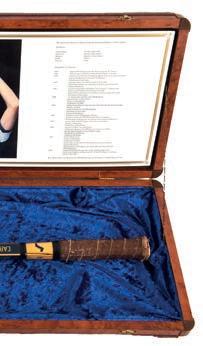
A racquet Roger Federer used during his second successful Wimbledon run in 2004 sold in February 2025 for $100,000 – the same price as earlier paid for the racquet Nadal had used to beat Federer in the 2007 nal of the French Open in Paris.
It was also the price paid for Rafa Nadal’s 2005 Roland Garros-winning shirt – an auction record for a piece of tennis clothing.
Opposite page Peter Robertson’s photograph of John McEnroe in a familiar pose challenging the umpire. A three-time Wimbledon Champion, he won in 1981, 1983 and 1984. e Robertson archive, numbering thousands of photos from the ‘80s and ‘90s, is up for sale
Left A Snauwaert racquet used by Boris Becker at the age of 15. It has an estimate of £500-£800 at Ewbank’s sale on June 24
Right e 1925
Wimbledon nals programme has a guide price of £150-£250 at the same sale
Below Peter Robertson’s photograph of Boris Becker. At 17 and unseeded, the German was the youngest Men’s Wimbledon Champion in 1985

Programmes, especially signed, can make money too and are worth holding onto.
Anything that helps fans relive the excitement and glory of their sport’s most memorable moments fits the bill. Collectors often seek programmes from specific years, finals, or matches featuring renowned players. Programmes from the 1930s Wimbledon Championships, such as those from 1932 to 1939, have been auctioned and are considered valuable due to their age and the era they represent.


A 100-year-old programme for the Wimbledon championships finals on July 4, 1925, originally priced at one shilling, is on offer at Ewbank’s for £150-250. It includes annotated results and press cuttings naming the 1925 Men’s champion as Henri Lacoste and the Women’s champion as Suzanne Lenglen, both among the legends of tennis.
It is generally acknowledged that the 2008 Wimbledon nal between Federer and Nadal is the greatest tennis match ever played – and the last Wimbledon Men’s Singles nal signi cantly a ected by rain. e ve-set thriller saw Nadal beat Federer 9-7 in the deciding set after Federer had been just two points from victory. (If you want to understand why Federer is the most sublime player ever, watch the video of him taking Nadal to deuce in the nal game.)
‘Of the new generation of players, Jannik Sinner and Carlos Alcaraz are likely to prove the most collectable, as things stand on the men’s front, while in the UK anything associated with Emma Raducanu should prove to have longevity after she scooped the US Open title in 2021, despite not replicating that level of success since’
Above Novak Djokovic’s signed match-worn tennis shoes. e pair has an estimate of £1,000-£2,000 at Ewbank’s sale

e racquet Nadal clutched as he fell onto his back at the end sold for an undisclosed sum at auction for the Cure Our Kids charity run by fellow tennis champion Lleyton Hewitt later that year. Tennis highlights at Ewbank’s June 24 sale include a pair of Novak Djokovic’s signed match-worn tennis shoes, expected to fetch £1,000-£2,000. Pitched at £500-800 is a unique racquet associated with Boris Becker. e former Wimbledon champion had used the Snauwaert racquet at the age of 15 and it is o ered here in an ornate wood box lined with blue velvet fabric accompanied by a printed provenance signed by Becker and a photograph of the player holding a trophy aloft.
Becker con rmed the provenance after meeting with the owner of the racquet, collector Alan Chalmers, on the Players lawn of the All England Club in July 2007. He immediately recognized it as his when he saw the strange grip fabric.
Of more academic interest is a 1703 second edition copy of Memoires du Monsieur Le Marquis de Montbrun, by the French author Gatien de Courtilz de Sandras (1644–1712). e writer was known for his semi- ctional memoirs, particularly those attributed to famous gures like D’Artagnan, the real-life inspiration for Alexandre Dumas’ e ree Musketeers. e novel describes how a French aristocrat swindles English players by disguising the best real tennis player in Paris as his valet. It has an estimate of £1,500-£2,000.
Another historic piece appearing on the rostrum is a mezzotint engraving of the French real tennis player J.E. Barre (1802-1873), who was a world champion from 1829-1862 and paumier to Napoleon III. e word comes from the French name for the precursor to tennis – jeu de paume – meaning “game of the palm”. A paumier was a craftsman or specialist who made equipment for the game. e engraving has a guide price of £700-£1,000 at this month’s sale.

Right A mezzotint engraving of the French real tennis player J.E. Barre (1802-73) has a guide price of £700£1,000
Below Engraving from the tennis memoir novel Memoires du Monsieur Le Marquis de Montbrun, it is expected to fetch £1,500-£2,000



‘Tennis fans are as passionate about their sport as those who follow football, cricket, or golf. When players throw sweatbands or tennis balls into the stands after Grand Slam success, the lucky people who catch them are grabbing hold of what effectively amounts to a religious relic’










A remarkable archive of photographs of some of the best court-side shots ever taken from the golden era of the modern game is also likely to get fans’ pulses racing
Wimbledon Final, which Borg won in five sets, and
The emergence of John McEnroe as the heir apparent to Bjorn Borg in SW19 began with the 1980 Wimbledon Final, which Borg won in five sets, and is widely regarded as one of the greatest matches in tennis history. The following year it was McEnroe lifting the trophy after four sets. Then came the bitter rivalry between McEnroe and Jimmy Connors, who objected to the latter’s on-court tantrums.




Peter Robertson said: “My job gave me access to almost all areas, and I was fortunate to see all the big matches and players. As a keen (but untrained) amateur photographer, I used my privileged position at The Championships to take photographs of the players, playing and preparing for matches, including John McEnroe, Martina Navratilova, Jimmy Connors, Chrissie Evert, Ivan Lendl, Steffi Graf, Andre Agassi, Monica Seles, Boris Becker, Gabriela Sabatini, and Pete Sampras.”
Robertson’s court-side snaps proved so good that the Wimbledon authorities bought many of them from him and used them for promotional material, including postcards at the tennis championships and in the Wimbledon Museum, as well as to form part of its archive.
As a talented player of the sport, Robertson’s natural knowledge gave him an understanding of when and how to take the best shots.
right
Robertson’s collection of Wimbledon photographs, numbering several thousand in total, has never been formally valued but is probably worth a healthy five-figure sum. Contact pjrobbo@ btinternet.com for more details.

unseeded in 1985 aged just 17. He went on to defend his Wimbledon title successfully the
Next was the powerhouse that was Boris Becker. One of the best serves in tennis and the youngest Men’s Wimbledon Champion ever, winning the title unseeded in 1985 aged just 17. He went on to defend his Wimbledon title successfully the following year and won again in 1989.




in the 1990s – a clean sweep from 1993 to seven-time Wimbledon champion from
Sampras held sway with seven triumphs in the 1990s – a clean sweep from 1993 to 2000 except for 1996 - while Andre Agassi was champion once, in 1992. Agassi later married Steffi Graf, one of the top five women players of all time and herself a seven-time Wimbledon champion from 1988 to 1996.
Witnessing these star-studded decades firsthand at Wimbledon was the amateur photographer and talented player Peter Robertson who worked behind the scenes at the famous court overseeing staff from court coverers to litter-pickers.

the amateur photographer and talented









Don’t let your antiques know-how wilt in the summer. Put it to the test against the super brain of Antique Collecting’s resident quiz editor Peter Wade-Wright

Q1 Under what designation was the rst generalpurpose charge (ie credit) card issued? (a) Car Club, (b) Diners Club, (c) Hotel Club, (d) Holiday Club.
Q2 e collection of stories, lore, geography etc. called Highways and Byways in Devon and Cornwall by Arthur H. Norway was rst published in which year? (a) 1893, (b) 1895, (c) 1897, (d) 1900.
Q3 Where would one once have found a possing stick? (a) a stable, (b) a gun/ shing tackle room, (c) the schoolroom, (d) the scullery.
Q4 If you owned a K6 what would it be? (a) a camera (Kodak), (b) a telephone kiosk, (c) a koala teddy-bear given to “Ten Pound Poms’” children on arrival in Australia after WWII, (d) a prototype of the Doctor Who robotic dog (K9).
Q5 For what is the Scottish-born Angus Bethune Reach (1821-1856) credited with creating in 18481849? a) e rst full-length detective story, (b) a tent with an integral inner groundsheet, (c) a gentleman’s gol ng umbrella, (c) a pioneering hippouch based on the sporran.
Q6 Alfred Hitchcock’s rst lm directed in America for David O. Selznick was titled, (a) Ariadne, (b) Frederica, (c) Magdalene, (d) Rebecca?
Q7 What is a snaphaunce? (a) a hasp used on Medieval money-chests, (b) an early, and unsuccessful, paperclip, (c) a form of int-lock rearm, (d) an Edwardian gentleman’s sock suspender-belt.
Q8 e Wizard comic included a lapel badge with its April 1961 issue. What was written on it? a) I am a Grand Speller, (b) I am a Loco Spotter, (c) I am a Star Gazer, (d) I am a Rocketeer.
Q9 Ragman’s Roll was what? (a) a 14th-century game, (b) a 16th-century kitchen tool, (c) a mid 18th-century naval hammock, (d) an early 20th-century meat-loaf container.
Send your answers to Crossword, Antique Collecting magazine, Riverside House, Dock Lane, Melton Woodbridge, Su olk, IP12 1PE. Photocopies are also acceptable, or email your answers to magazine@ accartbooks.com. The first three opened by July 20 will win a copy of Jackson’s Hallmarks, Pocket Edition: English, Scottish, Irish Silver & Gold Marks From 1300 to the Present Day, worth £7.99.


The letters in the highlighted yellow squares could be rearranged to make the word ‘turning’. The winners, who will each receive a copy of the book are Peter Bloomfield, by email; Trevor Hughes, Peterborough and Lorraine Beattie-Wright, by email.


Q10 Nature has always been a source of inspiration for art and design. e following animal names (bat, butter y, frog, mule, rat and toad) can all be linked to speci c purposes. Can you match them to the list below? (a) A sleeve-like device used to attach a sword to a belt. (b) a mid 17th-century chest. (c) a 19th-century drinking mug. (d) Wing-like uting, (e) a drop-leaf table, (f) a spoon design of the 17th/18th century.
Finally, here are four anagrams of 20th-century writers: Mousier envoi abed; Cute boomer; Eggs run arts and Acquire mailbag grazer. Rearrange them to form the name of the French author of She Came to Stay (6, 2, 8); the Italian who wrote e Name of the Rose (7, 3); the German author of e Tin Drum (6, 5) and the Colombian writer behind One Hundred Years of Solitude (7, 6, 7)
6 Special type of biscuit porcelain called Carrara by Wedgwood. (6)
7 _____work. Style of furniture inlay by the Parisian cabinetmaker (1642-1732) whose name was (properly) spelt differently. (4)
8 One of the three parts of the personality…as far as psychoanalytic theory is concerned. (2)
9 _____ - glass. Heavy-footed vessel used to thump a table as part of a toast. (6)
10 What one bids for. (1, 3)
11 Voting slip…rare because destroyed after use…or should be. (6-5)
15 The number of Muses, rivers of Hell and Scandinavian earths. Also what one is said to dress-up to. (4)
16 Decorative gilded metal objects. (6)
17 Mythological daughter of Inachus, loved by Zeus and turned into a heifer. (2)
18 Biblical garden and Cornwall project. (4)
19 C. R. _______ (1809-1882) Major contributor to evolutionary biology, geology…and so much else. (6)
1 Surface appearance from handling, corrosion etc. (6)
2 Decoration at the end of a gable, spike etc. (6)
3 Meritorious awards (pl.). David Attenborough has two (at the time of writing). Thoroughly deserved. (11)
4 Coarse canvas. (6)
5 Long, loose overcoat. (6)

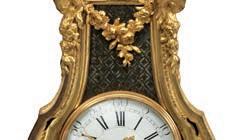


16
ACROSS CLUE What is the name given to this type of gilded object?
11 Head covering e.g. _____-rouge…the cap of liberty of the French Revolution. (6)
12 Timber, stone etc. strengthening over a door or window. (6)
13 Have a high opinion of. (6)
14 A long cake with cream filling. Beautifully described as “long in shape, but short in duration”. (6)
Finally, rearrange the letters in the highlighted squares to form the verb…to __________ …decorate with designs in needlework.

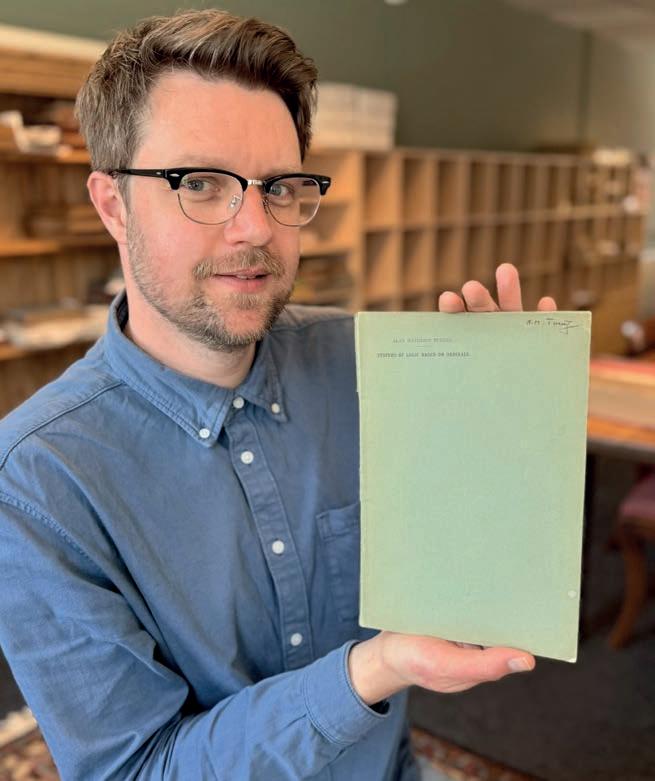
Rare Book Auctions director, Jim Spencer, with Alan Turing’s signed copy of his PhD dissertation Systems of Logic Based on Ordinals, 1939. It has an estimate of £40,000-£60,000 in this month’s sale

Sadly today’s appreciation (since 2021 Turing has appeared on the £50 note and his biography was bought to life in the 2014 lm e Imitation Game) is at odds with that he received during his own lifetime when he was criminalised and outcast for his sexuality.
Turing remains most famous for decoding the encryption of German Enigma machines during WWII, that sped up the end of the war saving thousands of lives. But decades before that, it was his groundbreaking research into computers and coding, and even arti cial intelligence, for which he was known.
is month sale o ers a series of his papers known as “o -prints”, produced in small numbers and distributed within academia. Each is an incredibly scarce survivor and rarely appear on the market. e archive was given to Turing’s friend and fellow mathematician, Norman Arthur Routledge (1928-2013) by Turing’s mother, Ethel, two years after her son’s death by apparent suicide in 1954.


TGroundbreaking papers belonging to the German Enigma codebreaker
Alan Turing – including a signed copy of his PhD – go under the hammer this month
o the untrained eye they might not look much more than a dusty pile of type-written papers, but within their pages lies the blueprint for every computer ever made, and an understanding of arti cial intelligence decades before it hit the mainstream. Because this is the personal archive of Alan Turing (1912-1954) one of the pioneers of computing science today lauded the world over, not least in Silicon Valley where today’s technological innovators celebrate the Englishman’s genius, and are likely to be among the bidders at this month’s sale at Rare Book Auctions in Lich eld, Sta ordshire.
Above right Letter signed by Alan Turing’s mother Ethel Turing (1881-1976) dated May 16, 1956. It has an estimate of £1,000-£2,000
Right An original telegram from Alan Turing to Norman Routledge congratulating him on his fellowship to King’s in 1951. It has an estimate of £1,000-£2,000
As early as 1936 Turing’s work On Computable Numbers introduced a “universal computing machine”, which, despite the model’s simplicity, has been described as “e ectively the rst programming manual of the computer age” and the basis for all modern computing systems. is month’s sale includes Turing’s own proof of the work with an estimate of £40,000-£60,000.
Equally impressive is a copy of Turing’s 1939 PhD dissertation Systems of Logic Based on Ordinals, written at Princeton, which introduced the notion of relative computing. It has an estimate of £40,000-£60,000.
As well as academic papers, the archive includes a letter from Ethel, dated May 16, 1956, disputing whether her son took his own life, instead stating her belief that the cyanide poisoning had been an accident.
Turing’s body was found by his housekeeper two years earlier with a half-eaten apple by his bed. Rather than suicide from the poisonous fruit, Ethel believed her son had inhaled poisonous fumes while electroplating spoons with gold, a process that requires potassium cyanide.

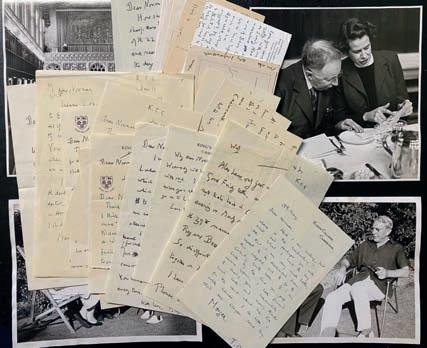
In the letter she writes: “I have to-day sent by registered post 13 of Alan’s o -prints...I don’t know what people in Cambridge thought of the manner of Alan’s death. I am convinced it was accidental as the experiment of coke under electrolysis - which smelt of cyanide had been going on for weeks - I feel sure he got some of this on his ngers & so on to the apple he customarily ate in bed...”
At the time Turing was a year into a two-year chemical castration after being charged with gross indecency (having reported a burglary, Turing let police know he had a male lover in his house).
After the war, Turing’s work remained leading edge in a number of fields. The hypothesis outlined in his masterpiece of mathematical biology, The Chemical Basis of Morphogenesis in 1952, Turing’s last major published work, remains groundbreaking to this day. Also in the sale is his 1942 work The Journal of Symbolic Logic, which Turing wrote during his spare moments while working full-time at Bletchley Park.
The papers were consigned by relatives of Turning’s friend Norman Routledge. The pair met at Cambridge after WWII, where Turing was studying physiology. Routledge was also a fellow at King’s College. They remained friends, with one of Turing’s last letters confiding in his arrest and subsequent conviction.

WHAT: The Alan Turing Papers: The collection of Norman Routledge (1928-2013)
Where: Rare Book Auctions, 3 Wade St, Lichfield, Staffordshire, WS13 6HL
When: June 17
Viewing: By appointment from June 3, on the day of the sale and online at www. rarebookauctions.co.uk
We asked Rare Book Auctions director, Jim Spencer, for his insights into this month’s sale

How important is the collection?
It is arguably the most important archive I’ve ever handled. These seemingly plain papers, perfectly preserved in the muted colours of their unadorned, academic wrappers, represent the foundations of computer science and modern digital computing. Literature has always been my forte, not mathematics, so the past few months of researching and cataloguing these papers has left me feeling that Alan Turing was superhuman. For me, it’s like studying the language of another planet; something composed by an ultra-intelligent civilisation.
How poignant is it, knowing what became of Turing?
I’m also painfully aware of the tragic end to Turing’s life, precisely because he was treated as alien - charged as a criminal, barred from GCHQ, banned from the United States, and forced to undergo chemical castration. All this despite the invaluable work he’d done at Bletchley Park during the war. And for nothing more than his sexuality. This injustice, and the fact he didn’t survive to see his enormous influence and impact, makes these papers feel even more special. It’s at least comforting to know that he lives on through his work. He survives through his legacy.
What are your highlights?
Above left An archive of letters from the author EM Forster to Norman Routledge, 1953-1969. e letters have an estimate of £2,000£3,000
Left A statue of Alan Turing outside the University of Guildford, image Shutterstock, illustration only
‘Turing’s body was found by his housekeeper in June 1954 with a half-eaten apple by his bed. Ethel believed her son had inhaled poisonous fumes while electroplating spoons with gold, a process that requires potassium cyanide’
The archive includes Turing’s PhD dissertation, Systems of Logic Based on Ordinals and, if that isn’t exciting enough, it’s his personal copy, signed by him. The provenance couldn’t be better: the archive was gifted to Turing’s friend and fellow mathematician, Norman Arthur Routledge (1928-2013), by Turing’s mother Ethel and her handwritten letter is the golden thread that neatly ties up and seals the authenticity of everything being offered.
Where are you expecting interest to come from?
Hardly anything like this appears on the open market, so predicting hammer prices is fortune-telling. I suspect interest will be strong in Silicon Valley - where Turing’s influence shines brightly – but it would be lovely to see material acquired by an institution who could share it with the public.
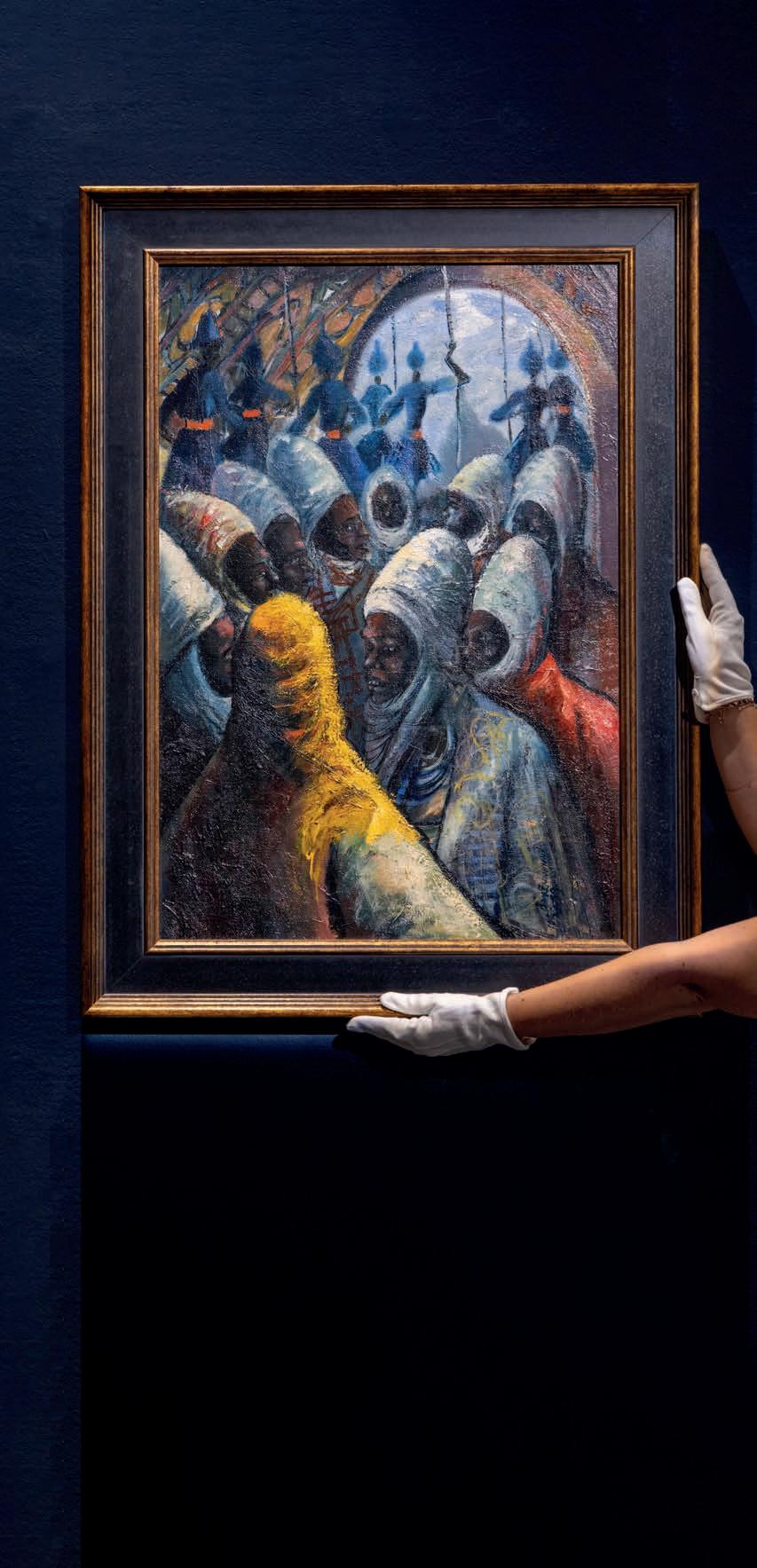
Collectors from Lagos to London are today clamouring for artworks once overlooked and now selling for estimate-busting sums, as the world wakes up to what insiders have long known: African modernist art is not just in the ascendancy – it is rede ning global aesthetics.
Indeed few movements pulse with as much energy, innovation and cultural richness as African modernism as the continent’s artists challenge outdated narratives and create a new visual language.
is autumn’s upcoming exhibition at Tate on Nigerian modernism, will celebrate the achievements of the county’s artists during national independence from British colonial rule in 1960. Meanwhile, the current exhibition at the Pompidou Centre in Paris – Paris Noir – explores the city’s role as a hub for African artists in the mid 20th century.
In this country, the Yorkshire Sculpture Park’s current show showcases the work of the South African sculptor William Kentridge, with the work of the British-Ghanaian artist Lynette Yiadom-Boakye, one of the most acclaimed gurative painters working today, on show at Leeds Art Gallery until October 5. At London’s Serpentine Gallery there is a chance to see a large scale mural by the South African artist Esther Mahlangu.
e marketplace for contemporary African art is also becoming increasingly dynamic, with new galleries emerging across the continent. Established fairs in Nigeria (Art X Lagos) and South Africa (Investec Cape Town Art Fair and Art Joburg) now provide robust platforms for connecting artists with collectors.
1-54, the rst international fair dedicated to contemporary African art, is now held annually in London, New York and Marrakech, helping elevate the continent’s artists onto the global stage and dismantle persistent stereotypes. is June, the launch of Africa Basel – timed with Art Basel Week – promises to further expand the European African art.
e surge in global demand for contemporary African art is re ected in the heightened activity across major auction houses. In the UK, Sotheby’s, Bonhams and Olympia Auctions are known for their dedicated sales of contemporary African art, each achieving outstanding results and breaking numerous artists’ price records.
is summer’s rst ever Africa
Basel will shine a light on one of the most exciting collecting elds around. Antique Collecting reveals seven of the continent’s modernist artists every collector should know
Above Ben Enwonwu MBE (1917-1994)
e Emir in Council, estimated at £70,000£90,000 it sold for £90,000 at Sotheby’s modern and contemporary African art sale on September 27 last year
Often dubbed the father of African modernism, the Nigerian artist Ben Enwonwu MBE (1917–1994) was arguably one of the most in uential African artists of the 20th century. A talented sculptor from an early age, after studying ne arts in Nigeria, in 1944, he won a scholarship to study at Goldsmiths College and the Slade School of Fine Arts, combining European artistic techniques with an African aesthetics, notably Igbo art. Returning to Nigeria in 1948, he was awarded an MBE by Elizabeth II for his contribution to the arts.
e theme of dance, and colonial misinterpretations of it, appears frequently in his work. His depictions of Igbo mmonwu (spirits) which bridge the world between the living and the dead, reveal the vitality of the performance.


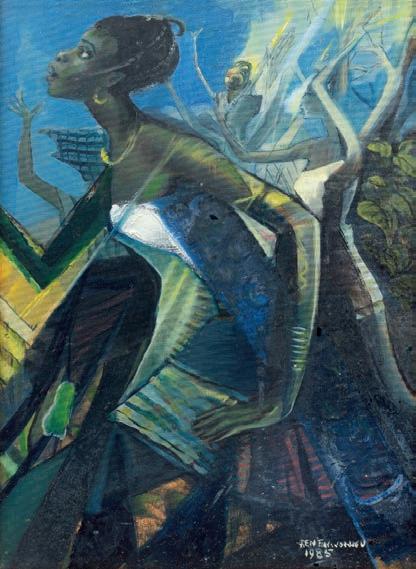
Sekoto (1913–1993) is recognised as a leading pioneer of Black South African modernism. Born in Botshabelo in 1913, Sekoto’s early life was shaped by the country’s segregationist policies. In 1939, he moved to Johannesburg to pursue a career as an artist, settling in Sophiatown and District Six, a vibrant, multiracial township. Here he captured both the vibrancy and hardship of everyday Black experience under apartheid. By 1947, the country’s escalating racial segregation led to his voluntary political exile to Paris, where he continued to paint and perform as a jazz musician until his death in 1993.
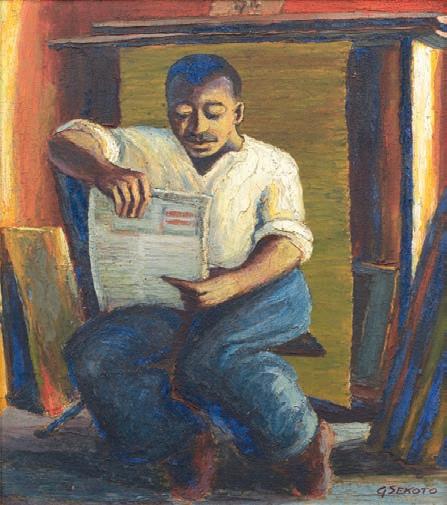

Above left Ben Enwonwu MBE (1917-1994) FESTAC
‘77, estimated at £300,000-£400,000 it sold for £444,900 at Bonhams’ modern and contemporary African art sale on October 16, 2024
Above Ben Enwonwu MBE (1917-1994) Dance
Movement, estimated at £120,000-£180,000 it sold fo £241,700 at Bonhams’ modern and contemporary African art sale this March
Left Gerard Sekoto (1913–1993) Man
Smoking. It sold for a mid-estimate £10,200 at Sotheby’s modern and contemporary African art sale on Sept 27, 2024
Far left Gerard Sekoto (1913–1993)
e Artist’s Brother It beat its guide price of £100,000-£150,000 to sell for £406,800 at Bonhams’ modern and contemporary art sale on March 20
Right Alexander ‘Skunder’ Boghossian (1937-2003), Happy Hour 14th + U St D.C. It beat its estimate of £10,000£15,000 to sell for £46,000 at the same sale
Emerging out of often brutal colonial legacies (between 1957 and 1962 some 24 African nations gained independence) and rapid urbanisation in the mid-20th century, African modernists sought to reconcile indigenous traditions with contemporary life, forging a bold, distinct identity.
Unlike the European modernists, whose rebellion was against the academies, African modernists fought an even deeper battle reclaiming their history of colonial distortion. Artists fused traditional African motifs, forms, and philosophies with modernist techniques—like abstraction, expressionism and minimalism.
Of Armenian-Ethiopian heritage, Alexander “Skunder” Boghossian (1937-2003) is one of the continent’s most highly-regarded modernist artists, whose work combines Ethiopian Coptic imagery, African folklore, surrealism and Afrofuturism.
e son of an Armenian father, imprisoned for his resistance to the Italian occupation, and an Ethiopian mother, in 1955 Boghossian won a scholarship from the Ethiopian government to attend St. Martin’s School of Art. After a stint in London he moved to Paris to teach at the Academie de la Grand Chaumiere, where he encountered Paul Klee and the Cuban surrealist painter Wilfredo Lam, two artists who had a marked in uence on his work. Jazz also played a key role in both his art and life.
After teaching at Addis Ababa’s School of Fine Arts in the late ‘60s, he moved to America in 1970, later becoming a painting professor at Howard University. Happy Hour 14th + U St D.C was likely created in Washington D.C. while he was teaching at Harvard. A vibrant, colourful abstraction, it re ects his unique blend of western modernism and Ethiopian cultural in uences.
‘This autumn’s upcoming exhibition at Tate on Nigerian modernism, celebrates the achievements of the county’s artists during national independence from British colonial rule in 1960. Meanwhile the current exhibition at the Pompidou Centre in Paris explores the city’s role as a hub for African artists’
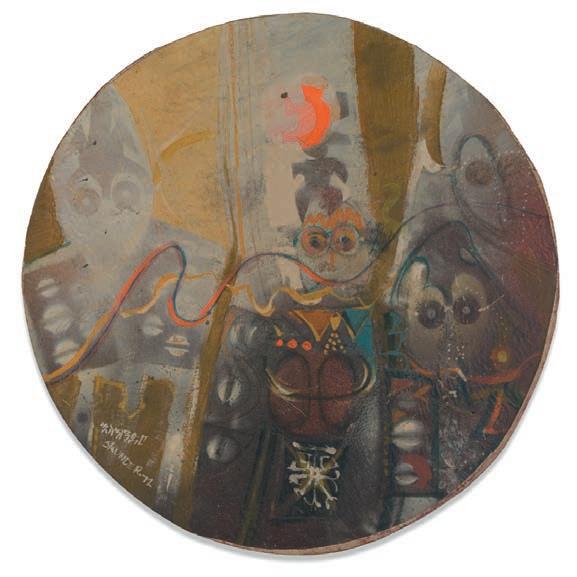


Johnson Donatus Aihumekeokhai Ojeikere was a pioneer of Nigerian documentary photography, from the 1950s producing a portfolio of some 2,000 negatives of his countrywomen’s unique hairstyles.
His trademark style: lack of backdrop, elaborate coi ure with an elegant sitter, acted as an emblem for the creativity at the heart of Nigerian cultural life.
Born in 1930, Ojeikere was raised in a rural village in southwestern Nigeria. He rst took up photography at the age of 20 when a neighbour taught him how to use a second-hand Kodak Brownie D camera. After securing a job as a photojournalist for the Ministry of Information in Ibadan, in the 1970s he worked for an advertising agency becoming skilled in commercial photography.
In Hairstyles, Ojeikere applies the skills he developed as a photojournalist to document the cultural revivalism that ourished in Nigeria following independence from British colonial rule in 1960. e theme was apt –indigenous styles were suppressed under colonial rule when European beauty standards were championed.
Born in the Kilimanjaro region in northwest Tanzania, Sam Joseph Ntiro is widely recognised as an icon of the Tanzanian artist landscape.
He studied art and education at the Makerere College of the University of East Africa, before completing a post graduate degree at the Slade School of Fine Art in London. He served as East African High Commissioner of Saint James in London and Ambassador of Tanganyika to Ireland from 1961-1964.
A highly accomplished artist, his works often explore liberation and post-colonialist identity, and depict scenes of community labour and cooperation, and it is likely that the painting (right) shows a scene from his childhood.
Indeed Untitled is an important example of Ntiro’s depictions of Tanzania and o ers an insight into the artist’s masterful control of colour and composition.
Ntiro frequently o ers gures with little facial detail, often with their backs turned on the viewer, perhaps a representation of Tanzania’s post-colonial self-image.
Above JD Okhai Ojeikere (1930-2014) Onile Gogoro or Akaba and Mkpuk Eba, estimated at £7,000£9,000, it sold for £8,400 at Sotheby’s modern and contemporary African art sale on September 27, 2024
Right Gerard Sekoto (1913-1993) Self-Portrait, 1947, the Kilbourn Collection © Estate of Gerard Sekoto/Adagp, Paris, 2025, photo © Jacopo Salvi, On show at the Paris Noir exhibition at the Pompidou Centre, Paris, until June 30
Below Sam J. Ntiro (1923-1993), Untitled, estimated at £7,000£10,000, it sold for £5,100 at Bonhams’ sale March 20, 2025
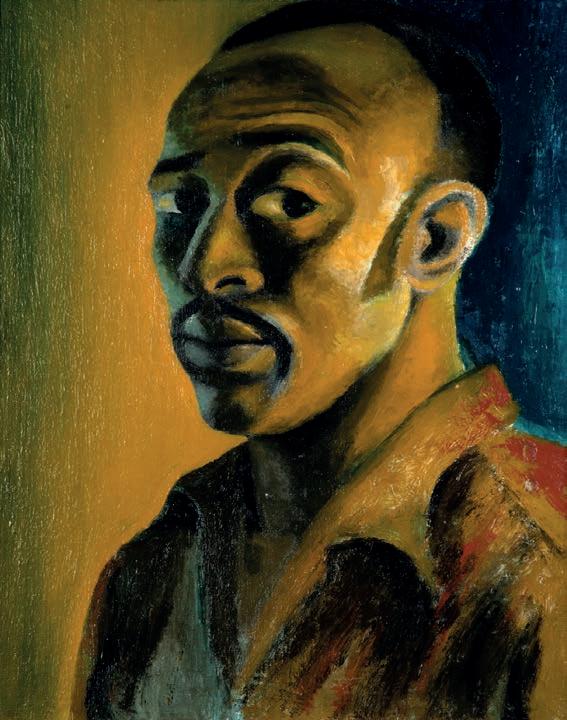
‘In the UK, Sotheby’s, Bonhams and Olympia Auctions are known for having dedicated sales of contemporary African art each achieving outstanding results and breaking numerous artists’ price records’


Mahlangu is another pioneer of African modernism celebrated for her vibrant, geometric paintings and murals, which are deeply rooted in her Ndebele heritage. Born in 1935, Mahlangu grew up outside Middelburg, Mpumalanga, and learned the art of Ndebele wallpainting and beadwork from her mother and grandmother following a tradition of the southern Ndebele people for females to paint the exterior of houses.
She came to national and international prominence when she painted an installation of brightly coloured, traditional geometric designs with strong black outlines for the Magiciens de la Terre (Magicians of the Earth) exhibition in Paris in 1989.
She was later invited to paint a designon a BMW 525i in 1991 and, in2020, painted panels for a Rolls-Royce Phantom Rather than using stencils and tape to achieve lines and shapes, she paints by hand with chicken feathers and an array of di erent brushes.
Mahlangu also works with acrylic paints on canvas, which allows her to explore di erent scales and a broader colour palette.
Right Esther Mahlangu (b. 1935) photo by Clint Strydom, courtesy of the Melrose Gallery. Mahlangu’s mural can be seen at Serpentine North Garden until September 28, photo George Darrell
Below left Esther Mahlangu (b. 1935) Ndebele Patterns, estimated at £6,000£8,000, it sold £9,000 at Bonhams sale on March 20
Bottom Irma Stern (1894-1966) Old Friends, estimated at £60,000-£90,000, it sold for £76,600 at Bonhams’ modern and contemporary art sale on March 20


Irma Stern (1894–1966) is one of Africa’s earliest and most proli c modernist painters. Of GermanJewish descent she worked extensively in South Africa, with her work documenting African life, culture and landscapes with bold colours and expressive brushwork.
Her deep engagement with African traditions — while controversial during her time — placed indigenous African subjects into the heart of modernist art conversations.
After studying in Germany in the 1910s, she gained widespread recognition after the Empire Exhibition of 1936.
Bottom right Irma Stern (1894-1966) Lady in Harem, estimated at £600,000-£800,000 it sold for £960,000 at Sotheby’s modern and contemporary African art sale on September 27 last year

Even after her work became rmly focused on African subject matter, the in uence of expressionism on her artwork, particularly the use of bright colours and the quick, thick brush strokes, endured for the rest of her career. She painted Old Friends in Alicante in the winter of 1961 recuperating from a long illness.
e work began as an observational study of local villagers in ballpoint pen and pastel but, struck by the gures’ closeness and obvious ease, she translated the study into an oil painting on canvas.


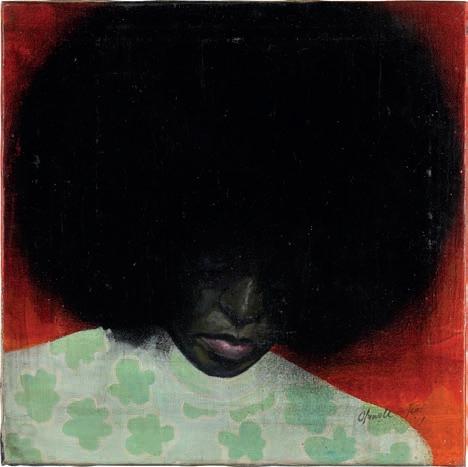
Below right Henry James (b.1996) New Fashion, estimated to make £700-£900, it sold for £2,200 at Olympia Auctions’ sale on May 7
Below Salah Elmur (1966) e White Shoes, estimated at £8,000-£12,000 it sold for £35,840 at Bonhams’ modern and contemporary art sale on March 20, 2025
Left Oluwole Omofemi (b, 1988) Meditation, estimated at £5,000£7,000 it sold for £16,800 at Sotheby’s modern and contemporary African art sale on September 27
Below Chéri Samba (b. 1956) e Water Problem, estimated at £12,000-£18,000, it sold for £14,400 at Sotheby’s modern and contemporary African art sale last September

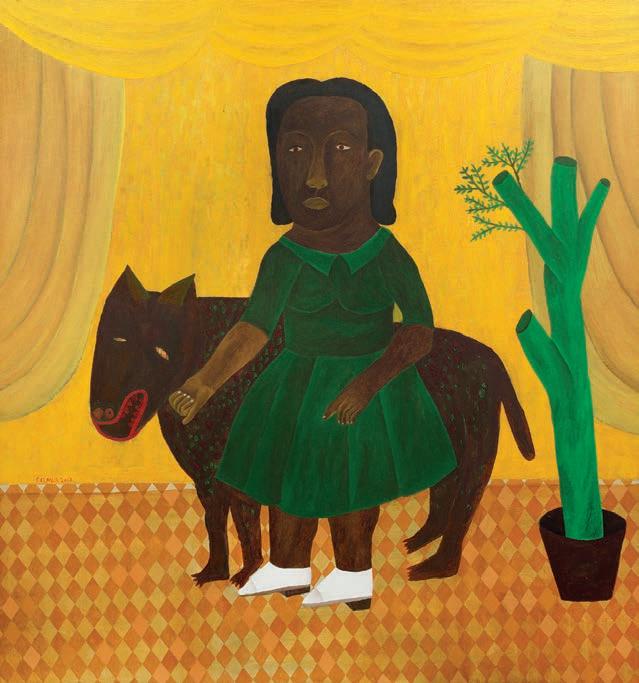
Sudanese painter, illustrator and filmmaker Salah Elmur (b. 1966) brings a whimsical but symbolic touch to African modernism with his colourful, childlike figures inspired by his country’s folklore, photography, and storytelling traditions.
Elmur grew up in a newly independent Sudan and uses the community from his youth in Khartoum as his inspiration. The White Shoes, part of his Kamal Photography series, celebrates his father and grandfather’s photography studio work.
The Ibadan-based Nigerian artist Oluwole Omofemi is mostly known for painting the last commissioned painting of Elizabeth II, commissioned for the cover of Tatler’s Platinum Jubilee issue. Introduced to the Alexis Galleries in Lagos while still a teenager, he sold his first painting aged just 18.
Few artists capture the complexity of the modern African experience as much as the Congolese artist Chéri Samba (b. 1956) whose comic strip-inspired paintings are alive with meaning. Talented from an early age, he refused to follow in the footsteps of his blacksmith father instead moving to Kinshasa in 1972 finding work painting advertising signs.
The Nigerian artist Oriolowo Henry (b. 1996), popularly known as Henry James, became a full-time artist after gaining a diploma in fine art from Lagos State Polytechnic in Ikorodu. His work focuses on human figures and the beauty of nature with his signature style blending vibrant colours and fabrics to celebrate the richness of African culture and heritage.
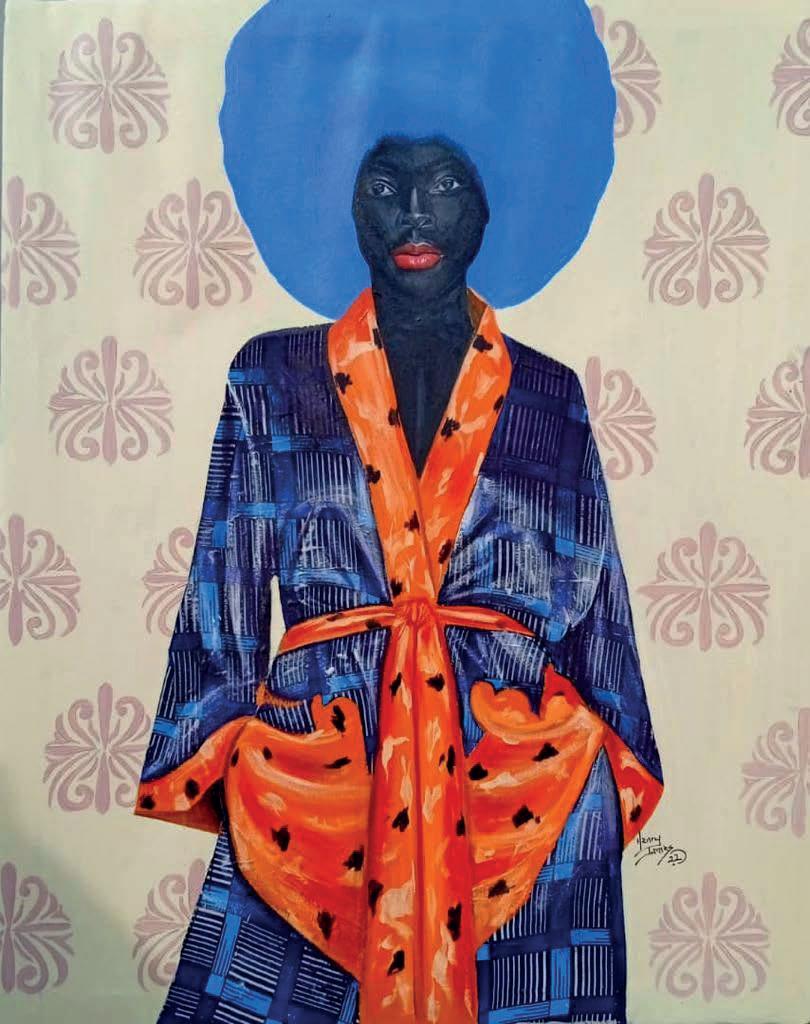
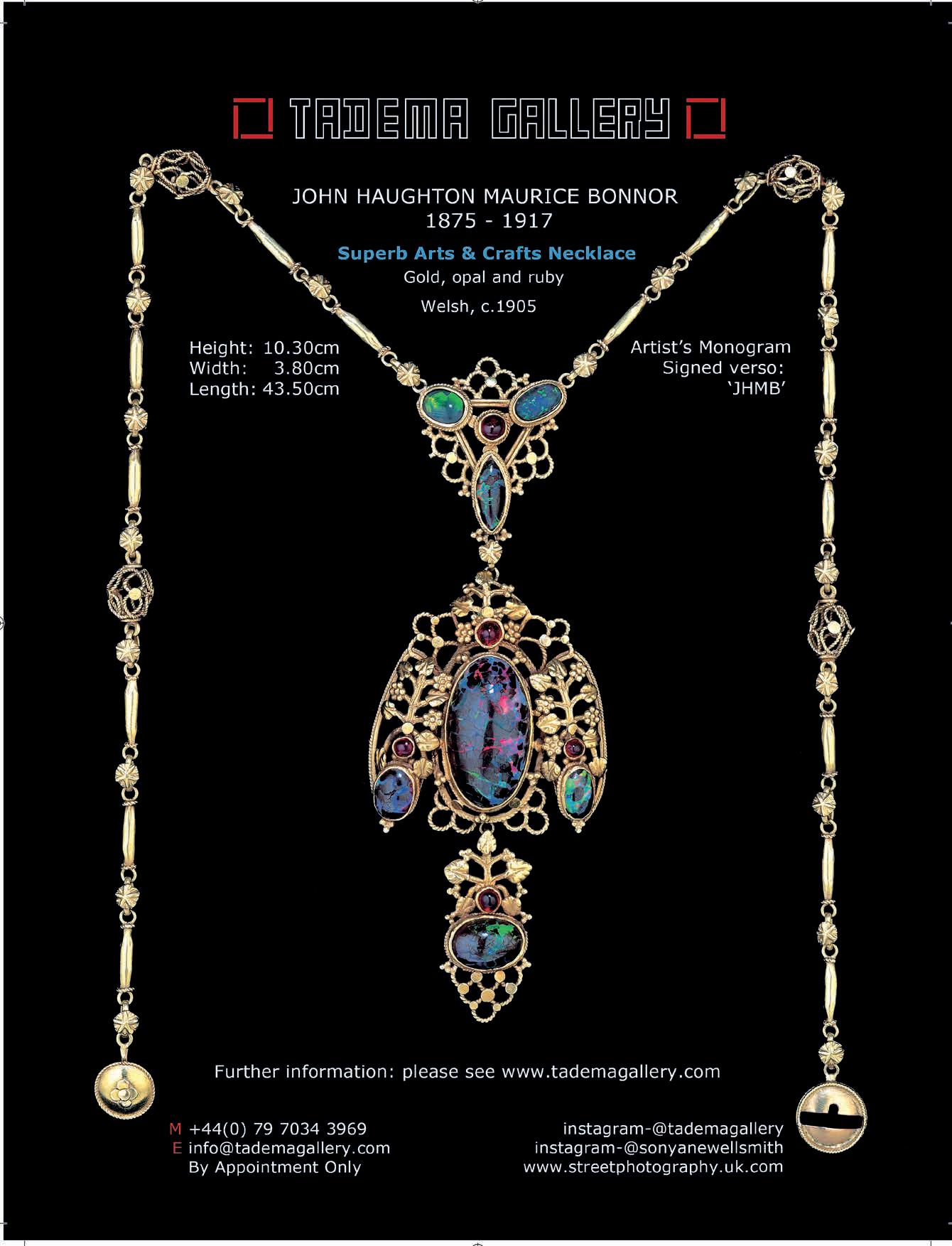
A rare copy of William Blake’s Songs of Experience is expected to make $1.5m in America, while a naïve painting of an idyllic Edwardian childhood appears on the rostrum in North Yorkshire
A large twin-handled lustreware vase by William de Morgan (1839-1917) has an estimate of £500-£1,000 at Woolley & Wallis’ auction in Salisbury on June 18.

An oil painting by Richard Ramsay Reinagle (1775-1862) has an estimate of £8,000 - £15,000 at Dukes’ two-day auction at its Dorchester saleroom on June 12-13. It comes from the contents of Bridehead, a Grade II-listed mansion in west Dorset, the recent home of Sir Philip Williams, who was the seventh generation of his family to live there.

Born in the same year as JMW Turner, Reinagle belonged to the generation of English artists who spanned the “golden age” of British portraiture, with his works reflecting the strong influence of Sir Thomas Lawrence, whose success as a society artist he sought to emulate.

De Morgan, a key figure in the arts and crafts movement, is celebrated for reviving the ancient art of lustreware pottery in the late 19th century.



His use of copper lustre, particularly, was groundbreaking, resulting in rich, iridescent finish with deep red and gold hues.


Produced primarily in his Chelsea and Merton Abbey workshops between the 1870s and 1907, De Morgan’s lustreware was admired for both its technical brilliance and aesthetic appeal.


A silver penny from the reign of the Wessex king, Aethelstan (927-939AD) has an estimate of £2,000-£3,000 at Timeline Auctions’ online sale from June 10-11.
On the death of the Viking king Sihtric (921-927) Athelstan invaded York and conquered Scandinavian Northumbria. With the Scots and Welsh kings also submitting to him, the campaign united Britain under one ruler for the first time. Hence the coin’s inscription REX TOT(ius) BRIT(anniae) meaning King of All Britain. Athelstan also introduced a law calling for one coinage throughout the country with no minting except in a port; it also outlined a quota of moneyers for each borough.
An early 18th-century, gem-set Mughal dagger has an estimate of £18,000-£20,000 at London-based Asca Auction’s sale Arts of India and the Islamic Lands on June 19.
Mughal daggers’ importance transcended the military, they were symbols of power, prestige and refined craftsmanship with some, like this one, inscribed with verses from the Qur’an, or invocations and the names of rulers.
Hilts were made of jade, ivory, horn, or gilded metals with the addition of precious stones including rubies, emeralds, diamonds and spinels – gems associated with specific astrological and spiritual benefits.


A painting by Helen Layfield Bradley (1900-1979), whose northern street scenes have been compared to LS Lowry, has an estimate of £15,000£20,000 at Tennant’s modern and contemporary art sale in Leyburn on June 14.

Above Aethelstan was known as the King of all Britain



Born near Oldham, Bradley, who only started painting at the age of 60, was known for her nostalgic paintings depicting her Edwardian childhood. Her works include recurring characters, the most famous of whom is Miss Carter who always wears pink and is often accompanied by a black poodle. Bradley’s mother also appears in formal dress, while the artist herself makes an appearance as a little girl with a red ribbon in her hair.
Above


Theeclectic art collection of the children’s author and illustrator Maurice Sendak (1928-2012) goes under the hammer at Christie’s in New York this month.
Lifelong collector Sendak, who was born to PolishJewish immigrant parents in New York, started collecting Mickey Mouse figurines as a child when they were given away free at his local cinema. A sickly youngster, with his childhood dominated by the loss of his extended family in the Holocaust, Sendak found comfort in the make believe including books, drawing and storytelling.
In his 20s Sendak sought out rarities from second-hand bookstores and print shops, with an early trip to Paris with his partner, Eugene Glynn, yielding affordable works by Toulouse-Lautrec, Félix Vallotton and Pierre Bonnard.
It was only after the success of Where the Wild Things Are in 1963, he could afford to start a collection in earnest.
He soon acquired two of his most valuable artworks: first printings of William Blake’s hand-illustrated books, Songs of Innocence and Songs of Experience. The latter being one of only four copies printed of the first issue and one of only two copies in private hands. Each is estimated to fetch between $1m and $1.5m at this month’s sale.
His collection also included works by artists with whom he shared the same inspirations. One such was the British painter George Stubbs (1724-1806) whose depiction ofhorses Sendak admired for being both scientifically accurate and imbued with an almost human empathy.
In the same vein, he appr ciated the work of Beatrix Potter (1866-1943) whose books and pictures he avidly collected. He said: “All my collections…are always things that I can use in some way. They give me back something... like talismans. I don’t collect them to invest or just collect.”
Mickey Mouse and the world of Disney also played a major role in Sendak’s collection with his love of the famous rodent based in part on a date – both were born in 1928.
After his juvenile collection amassed from local cinemas in the ‘60s, Sendak began collecting Mickey Mouse in earnest.
One of the sale highlights is a rare polychrome tin plate toy of Mickey and Minnie Mouse on a motorcycle. It was made by the German manufactirer Tippico in the 1930s and has an estimate of $30,000-$50,000. A similar Tippico Mickey and Minnie wind-up motorcycle from the collection of Monique Knowlton sold at Bertoia Auctions for $220,000 in 2024, setting the world record price for any Disney toy.
Maurice Sendak: Artist, Collector, Connoisseur takes place in Christie’s New York over two sales: a live auction on June 10 and an online sale ending on June 12.
1 Maurice Sendak (1928-2012) Where the Wild ings Are, Harper & Row, 1963, rst edition, rst state, from the author’s library. It has an estimate of $6,000-$9,000. 2 William Blake (1757-1827), Songs of Innocence, printed by the author, 1789. It has an estimate of $1m-$1.5m. 3 Maurice Sendak (19282012) Sendak in Philadelphia, pencil and watercolour. It has an estimate of $60,000-$80,000. 4 George Stubbs (1724-1806) A Lion (A Lion Resting on a Rock) etching with roulette, 1788. It has an estimate of $20,000-$30,000 5 George Stubbs (1724-1806) e Lion and Stag, enamel on copper, oval. It has an estimate of $100,000-$150,000. 6 William Blake (1757-1827) Oberon and Titania on a Lily signed with initials ‘W” , pencil, pen and black ink and watercolour. It has an estimate of $400,000-$ 600,000 7 William Blake (17571827), Songs of Experience, printed by the author, 1794. It has an estimate of $1m-$1.5m. 8 Mickey and Minnie Mouse motorcycle, Tippico, Germany, c.1935, polychrome tin plate. It has an estimate of $30,000-$50,000

















BY HEIDE CHRISTIANSEN
ISBN 9783961716289
RRP £29.95
OFFER PRICE £19.47
Bag a bargain with the latest book o ers from our sister publisher ACC Art Books. Keep up to date with its latest titles at www.accartbooks.com
Explore England as you never have before, in this captivating travel book. From bustling London to the picturesque villages of the Cotswolds, experience charming streets, medieval towns, and authentic fishing villages. Includes lovingly illustrated maps, practical information, and engaging travel stories.
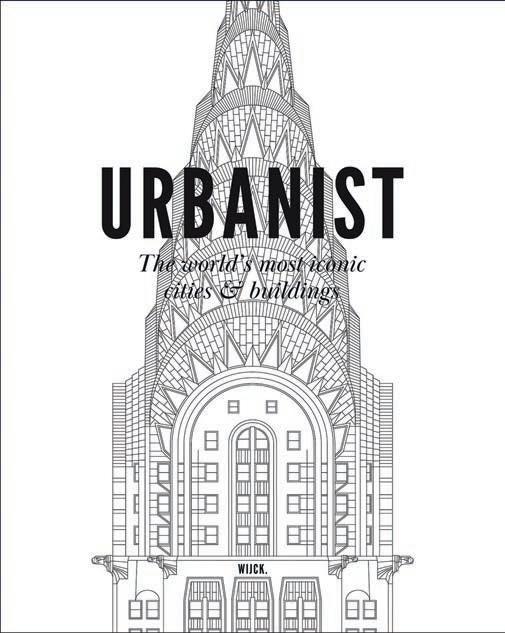
EDITED BY WIJCK
ISBN 9789090386256
RRP £45.00
OFFER PRICE £29.25
Urbanist showcases 25 iconic cities with WIJCK’s detailed maps and architectural highlights, exploring each landmark’s history, cultural impact, and unique design. Perfect for architecture lovers. From New York’s iconic skyscrapers to Barcelona’s Gaudí masterpieces and Dubai’s futuristic Burj Khalifa, Urbanist captures the essence of urban architecture.

BY JOOST JOOSSEN
ISBN 9789460583711
RRP £22.00
OFFER PRICE £14.30
A collection of inspiring stories and quotes about the power of seclusion and how to find true peace of mind, from the author of One Photo a Day Keeps the Doctor Away. It includes insights from 55 extraordinary individuals who harnessed the power of solitude. Among them are Nelson Mandela, James Dean, Edward Hopper, Immanuel Kant, Marina Abramović, Pina Bausch, David Lynch, Buddha, Frida Kahlo, Marcus Aurelius, and Marie Kondō.
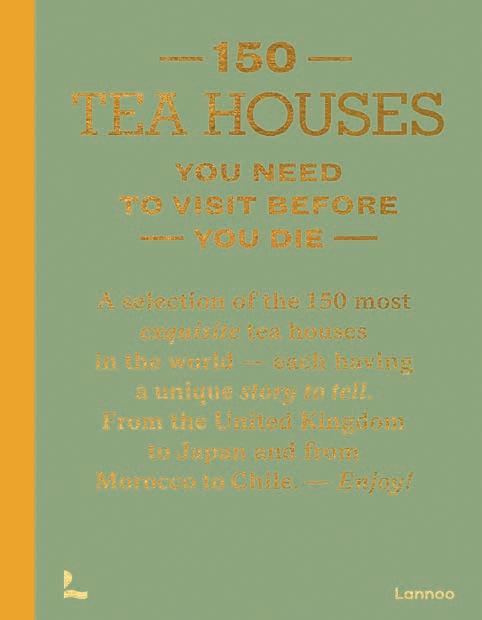
BY SUNNY HODGE
ISBN 9781917084635
RRP £25.00
OFFER PRICE £16.25
Stripping away the pretensions of wine appreciation and upending a lot of wellestablished myths, Sunny Hodge explains and unravels how wine works and tastes the way it does. The wine book all novice wine drinkers need: getting back to basics and revealing what really matters when it comes to producing the flavours in your glass of wine. Perfect for all budding wine lovers.
BY LÉA TEUSCHER
ISBN 9789020926613
RRP £30.00 OFFER PRICE £19.50
From traditional Japanese tea houses to modern, trendy hotspots in global cities, each tea house in this delightful and functional book has its own story, ambience, and unique tea appreciation experience. Whether you are a seasoned tea enthusiast or seeking new travel destinations, this richly illustrated book serves as an inspiring travel guide.
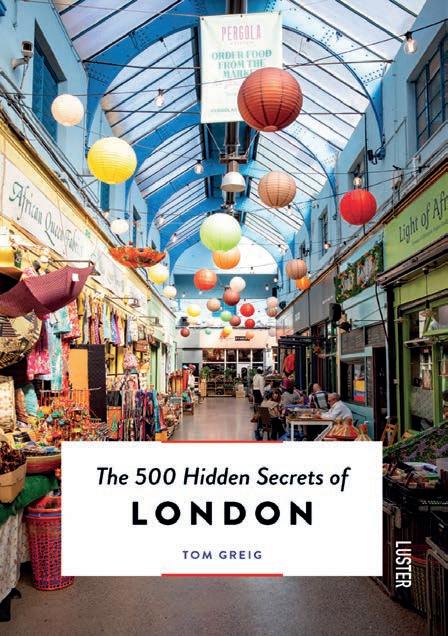

BY TOM GREIG
ISBN 9789460583735 RRP £16.95 OFFER PRICE £11.02
New and thoroughly revised edition of the bestselling London city guide, with many new places to visit, adding up to 500 addresses and facts in total, and two themed city walks. Written by a true local. This is a book for visitors who want to avoid the usual tourist spots and for residents who are keen to track down the city’s best-kept secrets
uksales@accartbooks.com, or call 01394 389950. Postage to UK addresses is £7, call for overseas rates. Offer subject to change without notice.
Because this list is compiled in advance, alterations or cancellations to the fairs listed can occur and it is not possible to notify readers of the changes. We strongly advise anyone wishing to attend a fair especially if they have to travel any distance, to telephone the organiser to confirm the details given.
Inc. Greater London
Adams Antiques Fairs 0207 254 4054
www.adamsantiquesfairs.com
Adams Antiques Fair, Lindley Hall, 80 Vincent Square, Westminster, SW1P 2PE, Jun 8, Jul 6
Coin and Medal Fairs Ltd 01694 731781
www.coinfairs.co.uk
Novotel, London West, 1 Shortlands, Hammersmith, London W6 8DR ,Jun 7
Treasure House Fair 020 4505 7760
www.treasurehousefair.com
Royal Hospital Chelsea South Grounds, London, SW3 4SR Jun 26-Jul 1
Sunbury Antiques 01932 230946
www.sunburyantiques.com
Sunbury Antiques Market, Kempton Park Race Course, Staines Road East, Sunbury-onThames, Middlesex TW16 5AQ, Jun 10, 24, Jul 8, 29
Wimbledon Antiques Market, Prince Georges Playing Fields, Bushey Road, Raynes Park, London, SW20 8TE, Jun 15, Jul 20
SOUTH EAST AND
ANGLIA:
including Beds, Cambs, Essex, Hertfordshire, Kent, Norfolk, Suffolk, Surrey, Sussex.
Arthur Swallow Fairs 01298 27493 www.asfairs.com
Decorative Home and Salvage Show, Loseley Park, Guildford, Surrey, GU3 1HS, Jul 18-20
Arun Fairs 07563 589725 www.antiques-atlas.com Rustington Antiques and Collectables Fair, The Woodland Centre, Rustington, West Sussex, BN16 3HB, Jun 8, Jul 13
Black Dog Events 01986 948546 wwwablackdogevent.com
Grand Brocante, Culford Hall, Bury
St Edmunds,Suffolk, IP28 6TX, Jun 8
Summer Brocante, Creake Abbey, Creake Road, Fakenham, Norfolk, NR21 9LF, Jun 22
Bungay Antiques Fair, Malting Meadow, Bungay,Suffolk, NR35 2SA, Jul 20
IACF 01636 702326
www.iacf.co.uk
Ardingley International Antiques and Collectors Fair, South of England Showground, Ardingley, West Sussex,RH17 6TL Jun 20 -21, Jul 22-23
Love Fairs 01293 690777
www.lovefairs.com
Kent County Show, Antiques and Collectables Detling, Maidstone, Kent, ME14 3JF, Jul 4-6
Antiques and Vintage Fair, Detling Showground, Detling, Maidstone, Kent, ME14 3JF, Jul 26-27
Marcel Fairs 07887648255
www.marcelfairs.co.uk
Antique and Collectors Fair, Sarratt Village Hall, The Green, Hertfordshire, WD3 6AS, Jun 8, Jul 13
Antique and Vintage Fair, Eagle Farm Road, Biggleswade Bedfordshire SG18 8JH, Jul 20
Melford Antiques Fair 07837 497617
www.melfordantiquesfair.co.uk
Long Melford Antiques and Vintage Fair, The Old School, Hall Street, Long Melford, Suffolk, CO10 9DX, Jun 21-22
Sunbury Antiques
01932 230946
www.sunburyantiques.com
Denbies Antiques Market
Denbies Wine Estate, Dorking, Surrey, RH5 6AA, Jul 13
SOUTH WEST
including Berkshire, Buckinghamshire, Cornwall, Devon, Dorset, Gloucestershire, Hampshire, Isle of Wight, Oxfordshire, Somerset, Wiltshire.
Arun Fairs 07563 589725
Emsworth Antiques and Collectors Fair, Emsworth Community Centre, North Street, Emsworth, Hampshire, PO10 7DD, Jun 8, Jul 13
Cameo Fairs 07790 126967 www.cameofairs.co.uk
Corfe Castle Antiques, Vintage and Decorative Fair, East Street, Corfe Castle, Dorset, BG20 5EE, Jul 6
IACF 01636 702326 www.iacf.co.uk
Antiques, Vintage and Collectors Fair, Royal Bath and West Showground, Shepton Mallet, Somerset, BA4 6QN, Jun 13-15
Newbury Antiques and Collectors Fair, Newbury Showground, Berkshire, RG18 9QZ, Jul 7
Mark Carter Militaria and Medal Fairs, 01753 534777
Yate Leisure Centre, Kennedy Way, Yate, near Chipping Sodbury, Bristol, BS37 4DQ, Jun 15
EAST MIDLANDS
including Derbyshire, Leicestershire, Lincolnshire, Northamptonshire, Nottinghamshire, Rutland.
IACF 01636 702326
www.iacf.co.uk
Runway Monday at Newark, Newark and Nottinghamshire Showground, Newark, Notts, NG24 2NY, Jun 30
Stags Head Events
07583 410862
www.stagsheadevents.co.uk
Antiques, Collectors and Classic Car Event, Naseby, Northampton, NN6 6DE, Jun 18-19
International Antiques, Vintage and Collectors Event, Fullhurst Leicester, LE3 1AH, Jul 13
WEST MIDLANDS
including Birmingham, Coventry, Herefordshire, Shropshire, Staffordshire, Warwickshire, Worcestershire
B2B Fairs
01636 676531
www.b2bfairs.co.uk
Malvern Flea and Collector’s Fair, Three Counties Showground, Malvern, Worcs, WR13 6NW, Jun 29, Jul 20
Coin and Medal Fairs Ltd. 01694 731781
www.coinfairs.co.uk
The Midland Coin Fair, The National Motorcycle Museum Coventry Road, Bickenhill,, Solihull B92 0EJ, Jun 8, Jul 13
NORTH including Cheshire, Cumbria, Lancashire, Northumberland, Tyne and Wear, Yorkshire.
Arthur Swallow Fairs 01298 27493
www.asfairs.com
Antiques and Salvage Market, Cheshire Showground, Tabley, Knutsford, WA16 0HJ, Jun 27-29
Cooper Antiques Fairs 01278 784912
www.cooperevents.com
The Pavilions of Harrogate Decorative, Antiques and Art Fair, Railway Road, Harrogate, North Yorkshire, HG2 8NZ, Jun 13-15
The Textile Society www.textilesociety.org.uk
The Textile Society’s Manchester Vintage Textile Fair, The Armitage Centre, Moseley Road, Fallowfield, Manchester, M14 6HE, Jun 8
V and A Fairs 01244 659887 www.vandafairs.com
Nantwich Town Square Antiques Market, Nantwich Town Centre Nantwich, Cheshire, CW5 5DH, Jun 14, Jul 5 Antiques Market, Civic Hall Nantwich, Beam Street, Nantwich, Cheshire, CW5 5DG, Jun 19, Jul 17
Continuity Fairs
www.continuityfairs.co.uk 07703 558600. The Mona Antique Home and Vintage Fair, The Showground, Gwalchmai, Holyhead, LL65 4RW, Jun 7-8
Jac Fairs www.jacfairs.com 07960 198409. Ayr Antique, Vintage & Collectors Fair, Citadel Leisure Centre, South Harbour Street, Ayr, Ayrshire, KA7 1JB, Jun 28, Jul 26 Glasgow, Antique, Vintage & Collectors Fair, 31 Bellahouston Drive, Glasgow, G52 1HH, Jun 15, Jul 13
A agship antiques fair returns to the capital this summer, while vintage textiles are celebrated in Manchester
It’s all change at one of the most popular antiques fairs in Wales after organiser
IACF added the Builth Wells event to its portfolio, taking over from Continuity Fairs after 25 years.

After a successful debut in May, the second event, now called the Builth Wells National Antiques Fair of Wales, is set to take place under the new owners on September 6-7 at the Royal Welsh Showground.
An IACF spokesperson said: “As a proud Welsh family business, we are especially excited about growing the National Antiques Fair of Wales and building on the wonderful legacy established by Nick and Sam at Continuity Fairs—to whom we extend our sincere thanks.”
Natasha Raskin lming Bargain Hunt at Builth Wells antiques fair, which is under new ownership, image Shutterstock
Fabrics ancient and modern take centre stage at this month’s Manchester Antique and Vintage Textile Fair on June 8.
Visitors will have the opportunity to meet dealers from across the UK, Europe and Asia at the event at the Armitage Centre, Moseley Road, Fallowfield.


The charming North Yorkshire spa town of Harrogate is the location for this month’s Decorative, Antiques and Art Fair from June 13-15.
Run by Cooper Events in two rooms at the Pavilions of Harrogate, the event offers something for everyone, from period furniture to art deco statues, as well as 19th and 20th-century jewellery, silver and ceramics
Collectors are invited to make a day of it by visiting the town’s Turkish baths, strolling through the Valley Garden or taking afternoon tea at the famous Betty’s tearoom.
A spokesperson said: “If you love history step back to ancient times when you visit monuments or admire the 18th-century elegance of historic houses such as Newby Hall or Ripon Cathedral.”
Bettys café tearoom in Harrogate is one of the spa town’s many attractions
Up to 70 internationallyrenowned exhibitors are set to take part in this summer’s prestigious Treasure House Fair when it returns to the Royal Hospital Chelsea from June 26 to July 1.

The fair has been a key event in the textile collecting calendar since 1992 when it was the first antique fair to specialise entirely in historic textiles. Since then it has established itself as a hub for passionate collectors looking for anything from world textiles to mid-century designs. As well as numerous stalls of antique textiles, the event includes displays by guilds, groups and recent graduates.
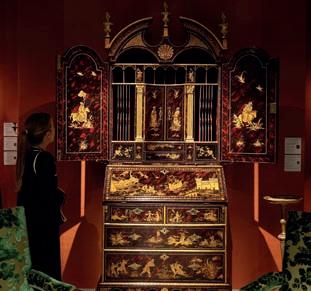
With every piece vetted by independent experts, the event showcases each of the major historical anniversaries of the year, including the centenary of art deco and the 60th anniversary of Winston Churchill’s death.
Fair director and co-founder, Thomas Woodham-Smith, said: “We like to think of it as a festival rather than an art fair. People come to enjoy the art, meet up and spend time at the restaurant and the bar. A bit like Prince Albert’s 1851 Great Exhibition and the 1951 Festival of Britain, the fair is a celebration of the greatest art and craftsmanship gathered from all four corners of the world.”
The event follows in a long tradition of summer fairs in the capital. It is 91 years since the first Antique Dealers’ Fair (later the Grosvenor House Art and Antiques Fair) which was founded in 1934 and ran until 2009. Its heir, Masterpiece, opened its doors for the first time in 2010, with the Treasure House Fair launching in 2023.
A Queen Anne tortoiseshell japanned bureau cabinet o ered by Ronald Phillips at last year’s event, image courtesy of Treasure House Fair

SPECIALISTS IN SINGLE-OWNER COLLECTIONS NATIONWIDE VALUATIONS & ADVICE
Jewellery | Watches | Silver | Ceramics | Glass | Decorative Arts
Paintings | Furniture | Clocks | Design | Books | Designer Goods
10-12 Cotswold Business Village, London Road, Moreton-in-Marsh, GL56 0JQ 01608 695695 enquiries@kinghamsauctioneers.com www.kinghamsauctioneers.com
TUESDAY





Because this list is compiled in advance, alterations or cancellations to the auctions listed can occur and it is not possible to notify readers of the changes. We strongly advise anyone wishing to attend an auction especially if they have to travel any distance, to telephone the organiser to confirm the details given
Inc. Greater London
Adam Partridge
The London Saleroom, The Auction Room, Station Parade, Ickenham Road, West Ruislip, HA4 7DL, 01895 621991 www.adampartridge.co.uk
Antiques and Fine Art with a Collection of Tolkien First Edition, First Impression Books, Jun 24-25 Antiques & Fine Art, Jul 29-30
Azca Auctions
188R Hammersmith Road
London, W6 7DJ 020 3911 6741 www.azcaauctions.com
Modern and Contemporary Middle Eastern Art, Jun 17
Arts of India and the Islamic Lands, Jun 19
Bonhams
101 New Bond St, London W1S 1SR, 020 7447 7447
www.bonhams.com
Islamic and Indian Art Online (Online), ends Jun 12
Modern British and Irish Art, Jun 18
London Fine Watches, Jun 19
Prints and Multiples, Jun 25
An Even Bigger Picture: David Hockney and Friends, Jun 18-27
Fine Decorative Arts, Jul 1 Fine Clocks, Jul 2
Old Master Painting, Jul 2
500 Years of European Ceramics, Jul 3
Bonhams
Montpelier St, Knightsbridge, London, SW7 1HH, 020 7393 3900 www.bonhams.com
Fine Glass and British Ceramics, Jun 11
Modern Decorative Art and Design (Online), ends Jun 11
Fine Books and Manuscripts, Jun 18
The Grand Tour Sale (Online), Jun 10-24
Jewels (Online), Jun 16-24
Designer Handbags and Fashion (Online)
Jun 16-26
The Classics Online Glass and British Ceramics, Jun 16-26
Antique Arms and Armour
(Online), Jun 23-Jul 1
Weekly: Watches (Online), Jun 27-Jul 9
Prints and Multiples (Online), Jun 27-Jul 9
Knightsbridge Jewels, Jul 16
Travel and Exploration, Jul 7-16
Jewels (Online), Jul 21-29
Weekly Designer Handbags and Fashion, Jul 23-31
Chiswick Auctions
Barley Mow Centre, Chiswick, London, W4 4PH, 020 8992 4442
www.chiswickauctions.co.uk
Silver and Objects of Vertu, Jun 11
The Fine Sale, Jun 18
Modern British and Irish Art, Jun 25
Prints and Multiple, Jul 3
Arts of India, Jul 8
Jewellery, Jul 15
Watches, Jul 15
Designer Handbags and Fashion, Jul 16
Chiswick Auctions
1Roslin Square, Roslin Road, London, W3 8DH 020 8992 4442
www.chiswickauctions.co.uk
Chiswick Auctions X Champagne Collectors: Champagne-only, Jun 12
Christie’s
8 King St, St. James’s, London, SW1Y 6QT, 020 7839 9060 www.christies.com
Fine and Rare Wines and Spirits: London Edition (Online), Jun 4-Jun 18
Post-War to Present, Jun 26
Post-War to Present (Online), Jun 17- Jul 17
Old Masters (Pt I), Jul 1
Old Masters (Pt II), Jul 2
Antiquities, Jul 2
Valuable Books and Manuscripts, Jul 9
Forum Auctions
220 Queenstown Road, London, SW8 4LP, 020 7871 2640
www.forumauctions.co.uk
Books and Works on Paper (Online), Jun 12, 26, Jul 10, 31
A Sixth Selection of 16th and 17th
Century English Books from the Fox Pointe Manor Library, Jun 19
Prints and Multiples 1500-2025, Jul 2
Prints and Multiples (Pt II), Jul 3
Fine Books, Manuscripts and Works on Paper, Jul 17
Modern and Contemporary Editions, Jul 30
Lyon & Turnbull
22 Connaught Street W2 2AF, 0207 930 9115 www.lyonandturnbull.com
Islamic and Indian Art (Viewing in London), Jun 11
1925: Celebrating Art Deco (Viewing in London), Jun 26
African and Oceanic Art, Natural History and Ancient Art (Viewing in Connaught Street and Online), Jul 1
Noonans
16 Bolton St, Mayfair, London W1J 8BQ, 020 7016 1700 www.noonans.co.uk
Coins and Historic Medals, Jun 10
Orders, Decorations, Medals and Militaria, Jun 11, Jul 16
Jewellery, Silver and Objects of Vertu, Jun 17
Watches, Jun 18
British and Irish Banknotes, Jun 25
Olympia Auctions
25 Blythe Road, London W14 0PD, 020 7806 5541 www.olympiaauctions.com
Fine Paintings, Works on Paper and Sculpture, Jun 11
Fine Antique Arms, Armour and Militaria, Jun 25-26
Roseberys
Knights Hill, Norwood, London, SE27 0JD, 020 8761 2522
www.roseberys.co.uk
Arts of India, Jun 10
Jewellery (Pt I), Jun 17
Jewellery (Pt II), Jun 18
Silver, Jun 24
Prints and Multiples, Jun 25
Old Master, British and European Pictures, Jul 9
Fine and Decorative, Jul 10
Sloane Street Auctions
158-164 Fulham Road, SW10 9PR, 020 3915 8340 www.sloanestreetauctions.com
The Summer Fine Art Auction: to include Old and Modern Masters,
Jewellery and Fine Estate Contents, Jun 12
Sotheby’s
New Bond St., London W1A 2AA, 020 7293 5000 www.sothebys.com
Modern and Contemporary Evening Auction, Jun 24
Contemporary Day Auction, Jun 25
Modern British and Irish Art Day Auction, Jun 26
Master Works on Paper from Five Centuries, Jul 2
Old Master and 19th Century Paintings Evening Auction, Jul 2
Old Master and 19th Century Paintings Day Auction, Jul 3
Books, Manuscripts and Music from Medieval to Modern (Online), Jun 26-Jul 10
Bibliotheca Brookeriana: A Renaissance Library Part VII, Jul 11
ANGLIA: Inc. Bedfordshire, Cambridgeshire, Essex, Hertfordshire, Kent, Norfolk, Suffolk, Surrey, Sussex
Bishop and Miller
Unit 12 Manor Farm, Glandford, Holt, Norfolk, NR25 7JP 01263 687342
bishopandmillerauctions.co.uk
The Summer Oak Interior, Jun 4
Summer Fine Jewellery, Jul 25
The Collector, Jul 23
Bellmans
Newpound, Wisborough Green, West Sussex, RH14 0AZ, 01403 700858
www.bellmans.co.uk
Wines and Spirits (Timed),ends Jun 15
Antiques and Interiors, Jun 23-24
Asian Ceramics and Works of Art, Jun 25
Coins and Medals, Jul 16
Printed Books, Maps and Manuscripts, Jul 16
Catherine Southon
Auctioneers Kingsley House, 5 High Street, Chislehurst, BR7 5AB
Kent, 020 8396 6970
www.catherinesouthon.co.uk
Fine Art: Traditional to Modern to
Because this list is compiled in advance, alterations or cancellations to the auctions listed can occur and it is not possible to notify readers of the changes. We strongly advise anyone wishing to attend an auction especially if they have to travel any distance, to telephone the organiser to confirm the details given.
Contemporary, Jun 25
Jewellery, Silver, Watches and Luxury Items, Jul 9
The Canterbury Auction Galleries 40 Station Road West, Canterbury, Kent, CT2 8AN, 01227 763337 canterburyauctiongalleries.com Antiques, Jun 6-7
Cheffins Clifton House, Clifton Road, Cambridge, CB1 7EA 01223 213343, www.cheffins.co.uk
The Interiors Sale, Jun 5
The Fine Sale, Jun 25 Jewellery and Coins (Timed Online), Jun 16 - Jul 1
Ewbank’s
London Rd, Send, Woking, Surrey, 01483 223 101 www.ewbankauctions.co.uk
Trading Cards and Retro Video Games Collectables, Jun 5
Trading Cards and Retro Video Games. Premier Live, Jun 6 Autographs (Pt I), Jun 12 Autographs (Pt II), Jun 13
Tennis Memorabilia, Jun 24
Jewellery, Watches and Coins , Jun 25
Silver and Fine Art, Jun 26 Antiques, Books, Stamps, Asian Art, Clocks and Antiques Furniture, Jun 27
Classic and Modern Cars and Automobilia, Jul 4
Comic Books, Jul 16
Toys and Models, Jul 17
Pre-Loved, Vintage and Antique inc. Jewellery, Jul 18
Vintage Posters, Jul 25
Interiors and Modern Design, Jul 31
Contemporary Art, Editions and Modern British Pictures, Jul 31
Excalibur Auctions Limited
Unit 16 Abbots Business Park Primrose Hill Kings Langley, Hertfordshire, WD4 8FR 020 3633 0913
www.excaliburauctions.com
Marvel, DC and Independent Comic Books, Jun 14
Gorringes 15 North Street, Lewes, East Sussex, BN7 2PE, 01273 472503
www.gorringes.co.uk
Weekly featuring Textiles, Jun 9
Pictures Old Master - Modern British, Jun 10
Weekly featuring Music and Science, Jun 16
Weekly House and Garden, Jun 23, Jul 7, 21
Weekly featuring Lux, Jun 30
Jewellery, Silver and Watches, Jul 8
Weekly featuring Militaria and Medals, Jul 14
Model Railways and Railwayana, Jul 22
Weekly featuring Fine Wines and Spirits, Jul 28
Hansons The Rostrum
The Old Bakery, Groveland, Thorpe Market Rd, Norfolk, NR11 8TB, 01263 840 021
www.therostrumauctions.co.uk
The Norfolk Jewellery, Silver, Watch and Fine Art Auction, Jul 26
Hansons The Old Post Office, Leicester Square, Penshurst, Tonbridge, Kent, TN11 8BJ, 01892 642146, www.hansonsauctioneers.co.uk
Penshurst April Silver, Jewellery, Watches and Fine Art Auction, Jun 11
Penshurst The Collections Sale (Timed Online), Jul 15-Aug 6
Hanson Ross Unit 1, The Power House, Lumen Road, Royston, Hertfordshire, SG8 7AG, 01763 430 042
www.hansonsauctioneers.co.uk
Royston June Fine Art Auction, Jun 6
Lacy Scott & Knight 10 Risbygate St, Bury St Edmunds, Suffolk, IP33 3AA, 01284 748 623
www.lskauctioncentre.co.uk
Homes and Interiors, Jun 7, Jul 5, 26
20th-Century Art and Design, Jun 13
Medals, Militaria and Country Pursuits, Jun 13
Wine, Port and Spirits, Jun 13
Fine Art and Antiques, Jun 14
Vintage and Classic Cars and Motorbikes, Jun 14
Toys and Models, Jun 20
Reeman Dansie 8 Wyncolls Road, Severalls Business Park, Colchester, Essex, CO4 9HU, 01206 754754
www.reemandansie.com
Specialist Collectors, Jun 10-12
Sworders Fine Art Auctioneers
Cambridge Road, Stansted Mountfitchet, Essex, CM24 8GE, 01279 817778
www.sworder.co.uk
Homes and Interiors, Jun 10
Old Master, British and European Art (Timed), Jun 6-15
Fine Interiors, Jun 17-18
Jun 10
Classic Cars, Jun 19
Timeline Auctions The Court House, 363 Main Road, Harwich, Essex, CO12 4DN, 01277 815121
www.timelineauctions.co.uk
Ancient Art, Antiquities, Natural History and Coins, Jun 3-8
Coins, Weights, Tokens and Medals, Jun 10-11
Toovey’s Antique & Fine Art Auctioneers Spring Gardens, Washington, West Sussex, RH20 3BS, 01903 891955 www.tooveys.com
Wines and Spirits, Jun 10
Fine Art, Silver and Plate, Jewellery, Jun 11
Furniture, Objects of Vertu, Collectors’ Items, Works of Art and Light Fittings, Needleworks, Textiles and Clothing, Rugs and Carpets, Jun 12
T.W. Gaze Diss Auction Rooms, Roydon Road, Diss, Norfolk, IP22 4LN, 01379 650306. www.twgaze.com
Antiques and Interiors, Jun 6, 13, 20, 27
Blyth Barn Furniture Auction, Jun 10, 17, 24
W&H Peacock Auctioneers Eastcotts Park, Wallis Way Bedford, Bedfordshire MK42 0PE, 01234 266 366 www.peacockauction.co.uk
Sporting Guns and Antique Arms, Jun 12
Wine and Spirits, Jun 13
W&H Peacock Auctioneers
24 Newnham Street, Bedford
Bedfordshire, MK40 3JR 01234 269082
www.peacockauction.co.uk
The Newnham Street Sale (Online) ends Jun 14
SOUTH WEST: Inc. Berkshire, Buckinghamshire, Cornwall, Devon, Dorset, Gloucestershire, Hampshire, Isle of Wight, Oxfordshire, Somerset, Wiltshire
Adam Partridge
The Antique Village, Station Rd, Hele, Exeter, Devon, EX5 4PW 01392 719826
www.adampartridge.co.uk
Antiques and Collectors’ Items with Jewellery, Coins and Watches, Jun 16-17
Antiques and Collectors’ Items with Militaria, Jul 21
Auctioneum
Broadlands Fruit Farm, Box Road, Bathford, Bath, BA1 7LR, 01225 251303
www.auctioneum.co.uk
Asian Art, Ceramics and Sculpture (Online), ends Jun 16
British Bespoke Auctions
The Old Boys School, Gretton Rd, Winchcombe, Cheltenham, Gloucestershire
GL54 5EE, 01242 603005
www.bespokeauctions.co.uk
Silver, Jewellery, Antiques and Collectables, Jun 5, Jul 10
Chilcotts The Dolphin Saleroom, High Street, Honiton, Devon, EX14 1HT, 01404 47783
www.chilcottsauctions.co.uk
Jewellery, Watches, Silver and Coins, Jun 7
Fine Art, including Ceramics, Pictures and Works of Art; Good Antiques and 20th-Century Design, Jul 12
Chorley’s Prinknash Abbey Park, Near Cranham, Gloucestershire, GL4 8EU, 01452 344499
www.chorleys.com
Fine Art and Antiques, Early Oak, Walnut and Works of Art and Taxidermy, Jun 24-25
Fine SIlver, Jewellery, Clocks, Watches and Object of Vertu, Fine Art and Antiques, Jul 29-30
Fine Art and Antiques, Jul 30
Dawsons Unit 8 Cordwallis Business Park, Clivemont Rd, Maidenhead, Berkshire, SL6 4BU, 01628 944100
www.dawsonsauctions.co.uk
Fine Jewellery, Watches and Silver, Jun 19, Jul 17
Fine Pictures, Prints and Sculptures, Jun 25
Interiors, Art, Antiques, Fine Art and Whisky, Jun 26
Entertainment and Memorabilia, including Vintage Posters, Jul 9 Interiors, Art and Antiques, Jul 24
Dominic Winter Auctions
Mallard House, Broadway Lane, South Cerney, Cirencester, Gloucestershire, GL7 5UQ, 01285 860006 www.dominicwinter.co.uk
Printed Books, Maps and Documents, Jun 18
Children’s and Illustrated Books, Modern First Editions, Original Illustrations, Jun 19
British and European Paintings & Watercolours, Old Master and Modern Prints & Drawings, Jul 16
Antiques and Historic Textiles, Jul 17
Dreweatts Donnington Priory Newbury, Berkshire, RG14 2JE 01635 553 553 www.dreweatts.com
Old Master, British and European Art, Jun 11
Fine Jewellery, Jun 12
Chinese Ceramics and Works of Art and Interiors, Jun 19
Fine Wine, Champagne, Vintage Port and Spirits (Live Online), Jun 24, Jul 29
Fine Furniture, Sculpture, Carpets, Ceramics and Works of Art (Day 1), Jun 24
Fine Furniture, Sculpture, Carpets, Ceramics and Works of Art (Day 2), Jun 25
Fine Silver, Jul 3
Modern and Contemporary Art, Jul 10
Duke’s Brewery Square, Dorchester, Dorset, DT1 1GA, 0105 265080 www.dukes-auctions.com
Bridehead: Auction of Contents, Jun 12
Fine Jewellery, Watches, Accessories, Jun 25
Gardiner Houlgate
9 Leafield Way, Corsham, Wiltshire, SN13 9SW, 01225 812912 www.gardinerhoulgate.co.uk
The Guitar Auction (Pt I-III), Jun 10-112
Musical Instruments, Jun 13
Antique and Classical Guitars, Jun 13
Watches and Jewellery, Jun 25
Antiques and Works of Art, Jun 26
Decorative Arts and 20th-Century Design, Jun 26
Antiques and Vintage, Jul 31
Hansons Auctioneers
Trinity House, The Harbour Saleroom, The Quay, Penzance TR18 4BN, 01736 339350 www.hansonsauctioneers.co.uk
Cornwall June Silver, Jewellery, Watches and Antiques Auction to include Asian, Islamic and Rugs, Jun 10
Cornwall June Asian, Islamic and Rugs Auction, Jun 11
Cornwall July Silver, Jewellery, Watches and Antiques Auction, Jul 8
Kinghams 10-12 Cotswold Business Village, London Road, Moreton-in-Marsh, Gloucester, GL56 0JQ, 01608 695695
www.kinghamsauctioneers.com
Silver and Objects of Vertu, Jun 19
Cotswold Interiors and Collectables, Jun 16
Jewellery, Watches and Designer Goods, Jul 9-10
Decorative Arts, Jul 23-24
Lawrences Auctioneers Ltd
The Linen Yard, South St, Crewkerne, Somerset, TA18 8AB, 01460 703041
www.lawrences.co.uk
Silver and Vertu, Jun 10
Jewellery and Watches, Jun 10 Pictures, Jun 11
Ceramics and Oriental Works of Art, Jun 11
Furniture, Clocks and Rugs, Jun 11
Collectors’ Items, Jun 11
20th-Century Modern Art and Design, Jul 18
Lay’s Auctions
Lay’s Auctioneers, Church Row, Lanner, Redruth, Cornwall, TR16 6ET, 01736 361414
www.davidlay.co.uk
Fine Jewellery and Watches, Jun 5-6
Railways and Collectables Sale (Timed), Jul 11-27
Mallams Oxford Bocardo House,
St Michael’s St, Oxford, OX1 2EB, 01865 241358
www.mallams.co.uk
Modern Art and Design, Jun 18-19
Jewellery, Silver and Accessories (Timed), Jul 14-31
Mallams Cheltenham
26 Grosvenor St, Cheltenham. Gloucestershire, GL52 2SG 01242 235 712
www.mallams.co.uk
Country House Sale, Jun 11
Mallams Abingdon Dunmore Court, Wootten Road, Abingdon, OX13 6BH, 01235 462840
www.mallams.co.uk
The House and Garden Sale, Jul 28-29
Moore Allen & Innocent Burford Road Cirencester, Gloucestershire GL7 5RH, 01285 646050 www.mooreallen.co.uk
Vintage and Antique Furniture Auction, Jun 18-19, Jul 16-17
Timed Vintage and Antique Furniture, Jun 20-29, Jul 18-27
Philip Serrell
Barnards Green Rd, Malvern, Worcestershire. WR14 3LW, 01684 892314 www.serrell.com
An Eclectic Mix of Antique, Vintage, Household Furniture and Effects, Jun 12, Jul 3
Special Auction Services
Plenty Close, Newbury, Berkshire, RG14 5RL 01635 580 595 www.specialauctionservices.
Glorious Trains Auction, Jun 10-11
Sand and Clay: Ceramics and Glass Auction, Jun 17
Fine Dolls, Teddy Bears and Traditional Toys Auction, Jun 24
Jewellery, Silver and Antiques Auction, Jul 8
Music and Entertainment Auction, Jul 15
Photographica and Cameras Auction, Jul 22
Toys for the Collector, Jul 29
The Cotswold Auction Company Chapel Walk
Saleroom, Cheltenham, Gloucesterhire, GL50 3DS, 01242 256363 www.cotswoldauction.co.uk
Books, Medals, Militaria, Coins, Stamps and Collectables, Jun 3
The Cotswold Auction Company
Bankside Saleroom
Bankside Trading Park Love Lane, Cirencester Gloucestershire, GL7 1YG, 01285 642420 www.cotswoldauction.co.uk
Silver, Jewellery, Watches, Asian, Whisky, Antiques and Interiors, Jun 24-25
Toys, Dolls, Models, Antiques and Interiors, Jul 29-30
Wessex Auction Rooms
Westbrook Far, Draycot Cerne, Chippenham, Wiltshire, SN15 5LH, 01249 720888 www.wessexauctionrooms.co.uk
Antiques, Collectables and Furniture, Jun 14, Jul 19
Toys, Jun 19-20
Vinyl Records and Music Memorabilia, Jun 26-27
Antiques, Collectables and Furniture, BBC Children In Need
Special With Bargain Hunt, Jul 5 Coins, Jul 10
Jewellery, Silver and Watches, Jul 11
Woolley & Wallis 51-61 Castle Street, Salisbury, Wiltshire, SP1 3SU, 01722 424500 www.woolleyandwallis.co.uk
Fine Arts and Crafts, Jun 18 Furniture, Works of Art and Clocks, Jul 2-3
Fine Jewellery, Jul 9-10
Silver and Objects of Vertu, Jul 15-16
EAST MIDLANDS: Inc.
Derbyshire, Leicestershire, Lincolnshire, Northamptonshire, Nottinghamshire, Sheffield
Gildings Auctioneers
The Mill, Great Bowden Road, Market Harborough, Leicestershire, LE16 7DE. 01858 410414 www.gildings.co.uk
Fine Art and Antiques, Jun 11
Golding Young & Mawer
The Bourne Auction Rooms, Spalding Road, Bourne, Lincolnshire PE10 9LE 01778 422686
www.goldingyoung.com
Bourne Collective Sale, Jun 11-12, Jul 9-10
Bourne Toy, Transport and Automobilia Sale, Jun 25
Golding Young & Mawer
The Grantham Auction Rooms, Old Wharf Road, Grantham, Lincolnshire NG31 7AA,
Because this list is compiled in advance, alterations or cancellations to the auctions listed can occur and it is not possible to notify readers of the changes. We strongly advise anyone wishing to attend an auction especially if they have to travel any distance, to telephone the organiser to confirm the details given.
01476 565118
www.goldingyoung.com
Grantham Collective Sale, Jul 2-3, 30-31
Grantham Asian Art, May 28
Golding Young & Mawer
The Lincoln Auction Rooms, Thos Mawer House, Station Road North Hykeham, Lincoln LN6 3QY, 01522 524984
www.goldingyoung.com
Lincoln Collective Sale, Jun 18-19, Jul 16-17
Lincoln Fine Art, Jul 23
Hansons Heage Lane, Etwall, Derbyshire, DE65 6LS 01283 733988
www.hansonsauctioneers.co.uk
Fine Art, Iconic Design Incorporating Decorative and Contemporary Arts, Jun 12-13
Derby June Coins and Banknotes, Jun 18
Derby July Music Memorabilia and Film, Jul 2
Irita Marriott Auctioneers and Valuers Ltd, William’s Yard, Derby Road, Melbourne, Derbyshire, DE73 8JR 01332414848
iritamarriottauctioneers.co.uk
Two-Day Antique and Collectors Auction, Jun 18-19, Jul 16-17
WEST MIDLANDS: Inc. Birmingham, Coventry, Herefordshire, Shropshire, Staffordshire, Warwickshire
Fellows Augusta House, 19 Augusta Street, Hockley, Birmingham, B18 6JA , 0121 212 2131
www.fellows.co.uk
Antiques, Fine Art and Collectables, Jun 10
Fine Jewellery, Jun 12
Jewellery (Day 1), Jun 17, Jul 1
Jewellery (Day 2), Jun 18, Jul 2 Pawnbrokers Jewellery and Watches, Jun 18, Jul 2, 16 Gemstones, Jun 19
Designer Handbags and Accessories, Jun 24 Watches, Jun 26
Fieldings Mill Race Lane, Stourbridge, DY8 1JN 01384 444140
www.fieldingsauctioneers.co.uk
The Collectors Auction Including Militaria, May 15-16
Everyday Antiques (Timed), May 21-28
Toys, Model Railway, Dolls and Teddy Bears, May 29
Halls Bowmen Way, Battlefield, Shrewsbury, Shropshire, SY4 3DR, 01743 450700
www.hallsgb.com/fine-art.com
British and Continental Ceramics and Glass, Paintings and Prints Auction, Jun 18
Modern and Contemporary Art and Design Auction, Jul 9
The Summer Edit (Timed), Jul 4-22
Potteries Auctions The Cobridge Saleroom, 271 Waterloo Road, Cobridge, Stokeon-Trent, Staffordshire, ST6 3HR 01782 212489
www.potteriesauctions.com
20th Century Pottery from Royal Doulton, Beswick and Royal Crown Derby, Jun 4-15
Rare Book Auctions, 3 Wade St, Lichfield, Staffordshire, WS13 6HL, 01543 765 230
www.rarebookauctions.co.uk
The Alan Turing Papers: The collection of Norman Routledge (1928-2013), June 17
Richard Winterton
Lichfield Auction Centre, Wood End Lane, Fradley Park, Lichfield, Staffordshire, WS13 8NF, 01543 251081
www.richardwinterton.co.uk
Antique and Home, Jun 9, 16, 23
Richard Winterton
Tamworth Auction Rooms, 34 -35 Church Street, Tamworth, Staffordshire B79 7BX, 01827 217746
www.richardwinterton.co.uk
Toys, Trains, Cameras and Militaria, Jun 28
Trevanion The Joyce Building, Station Rd, Whitchurch, Shropshire, SY13 1RD, 01948 800 202
www.trevanion.com
The June Auction, Jun 11
The July Auction, Jul 16
NORTH: Inc. Cheshire, Co. Durham, Cumbria, Humberside, Lancashire, Greater Manchester, Northumberland, Tyne & Wear, Sheffield, Yorkshire
Adam Partridge Auctioneers
Withyfold Drive, Macclesfield, Cheshire, SK10 2BD 01625 431 788
www.adampartridge.co.uk
Decorative Arts, Toys, Books and Automobilia with Antiques and Collectables, Jul 2-4
Studio Ceramics, Jul 18
Adam Partridge Auctioneers
The Liverpool Saleroom, 18 Jordan Street, Liverpool, L1 OBP, 01625 431 788
www.adampartridge.co.uk
Antiques and Interiors with Maritime and Militaria, Jun 5-6 Antiques and Interiors with Toys, Wines and Spirits, Jul 10-11
Anderson and Garland Crispin Court, Newbiggin Lane, Westerhope, Newcastle upon Tyne, NE5 1BF, 0191 430 3000 www.andersonandgarland.com
The Collectors’ Auction, Jun 19
The Music Auction, Jun 25
British Toy Auctions
9 Berkeley Court Manor Park, Runcorn Cheshire, WA7 1TQ 01928 579032
www.britishtoyauctions.co.uk
Vintage Diecast and Tin-plate Toys, Model Railways and more, Jun 9, 16, 23, 30
Elstob Ripon Business Park, Charter Road, Ripon, North Yorkshire HG4 1AJ, 01677 333003 www.elstob.co.uk Pictures, Jun 11
Ryedale Auctioneers
Cooks Yard, New Rd, Kirkbymoorside, North Yorkshire, YO62 6DZ, 01751 431 544
www.ryedaleauctioneers.com
Country House Sale including Mouseman and Yorkshire Oak, Jun 20
Peter Jackson collection of Asian Art, Jun 27
Antiques, Interiors and
Collectables, Jul 3-5, 31
Militaria and Sporting Goods, Jul 18
Coins, Stamps, Postcards, Books, Music and Sports Memorabilia, Jul 25
Sheffield Auction Gallery
Windsor Road, Heeley, Sheffield, S8 8UB, 0114 281 6161
www.sheffieldauctiongallery.com
Specialist Collectable Stamps, Jun 19
Specialist Collectable Coins, Jun 19
Fine Silver,Jewellery and Watches, Jun 19
Antiques, Fine Art and Collectables, Jun 20
Live and Engineered Steam Auction, Jul 17
Football Programmes and Sporing Memorabilia Auction, Jul 31
Tennants Auctioneers
The Auction Centre, Harmby Road, Leyburn, North Yorkshire, DL8 5SG, 01969 623780
20th-Cenury Design, Jun 14
Modern and Contemporary Art, Jun 14
Antiques and Interiors, to include Beswick and Border Fine Arts, Jun 20
Militaria and Ethnographica, Jun 25
Antiques and Interiors, to include a Section of Silver, Jul 4
Asian Art, Jul 11
The Summer Sale, Jul 12 British, European and Sporting Art, Jul 12
Fine Jewellery, Watches and Silver, Jul 12
The Summer Transport Sale, Jul 12
Antiques & Interiors, to include Designer Fashion, Jul 18
Toys and Models, Sporting and Fishing, Jul 23
Wilson 55 Victoria Gallery, Market St, Nantwich, Cheshire CW5 5DG. 01270 623 878 www.wilson55.com
Fine Jewellery, Watches and Designer, Jun 12
Fine and Classic, Jun 26
Bonhams 22 Queen St, Edinburgh, EH2 1JX, 0131 225 2266
www.bonhams.com
Finest Whisky and Spirits (Online), Jun 30-Jul 15
Lyon & Turnbull 33 Broughton Place, Edinburgh, EH1 3RR, 0131 557 8844
www.lyonandturnbull.com
Books and Manuscripts, Jun 18
The Art Edit, Jun 25
McTears Auctioneers
31 Meiklewood Road, Glasgow, G51 4GB, 0141 810 2880 www.mctears.co.uk
Antiques and Interiors, Jun 12, 26, Jul 10, 24
Toys, Models and Pop Culture, Jun 18
British and International Pictures, Jun 18
Instruments Clocks, Scientific and Musical, Jun 19
Sporting, Medals and Trophies, Jun 19
Coins and Banknotes, Jewellery, Watches, Jul 9
Whisky, Jul 16
The Scottish Contemporary Art Auction, Jul 17
Militaria, Maps and Ethnographica, Jul 30
19th and 20th-Century Design, Jul 30
Silver and Luxury Accessories, Jul 31
Asian Art, Jul 31
Anthemion Auctions, 15 Norwich Road, Cardiff, CF23 9AB, 029 2047 2444
www.anthemionauction.com
General Sale, Jun 11
Jones & Llewelyn
Whaley Bridge, High Peak, Derbyshire
Fine Furniture and Works of Art, Jun 19
Tel: 07767 617507 or 01663 733209 www.antique-clock.co.uk
Unit B, Beechwood Trading Estate, Carmarthenshire, SA19 7HR, www.jonesandllewelyn.com
General Sale, Jun 14, 28, Jul 12, 26
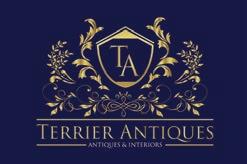
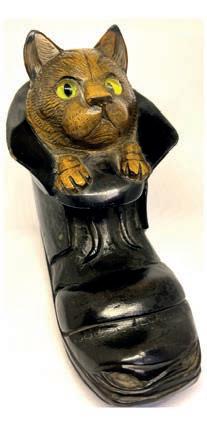


Rogers Jones & Co
Gregynog Hall Saleroom Gregynog Hall, Tregynon, Powys, SY16 3PL , 01686 650031 www.rogersjones.co.uk
The Summer Welsh Sale: Welsh Porcelain, Gregynog Books, Welsh Antiques and Fine Art, Jul 27
Rogers Jones & Co 17 Llandough Trading Estate, Penarth, Cardiff, CF11 8RR, 02920 708125 www.rogersjones.co.uk
The Club House: Sports Memorabilia, Military Antiques, Jun 6
The Family Collection of Gwilym and Claudia, May 23
IRELAND
Adam’s 26, Stephens Green, Dublin 2, D02 X665, Ireland, 00 353 1 6760261 www.adams.ie
The Jewellery Box, Jun 24 Fine Asian Art, Jun 25





Co ee with his local vicar sparked Antiques Roadshow expert Marc Allum with an idea on how to unite the world’s religions
Over co ee with my local vicar I found myself re ecting on the strange, wonderful ways that faith, history and art weave themselves into the fabric of our lives. I don’t go to church, but I live in the old rectory beside the parish church of St Andrews in my home county of Wiltshire. is unique setting has connected me deeply to the building’s past and its preservation. As a trustee of the Fabric Fund, I nd great meaning in contributing to the care and continuation of a structure that has long stood as a spiritual anchor in our community.
Why the interest, you might ask? Perhaps it needs little explanation to fellow collectors or lovers of antiquity. My home, like many historic houses, is steeped in stories— and lled with objects of reverence. Over the years, I’ve collected artefacts that embody the sacred across many
traditions: Christian, Buddhist, Hindu, Shinto, Islamic and beyond. For me, the impulse to collect has always been about more than aesthetics or rarity. It is rooted in a profound respect for the signi cance these objects once held for their devotees.
Indeed, the sanctity of place matters just as much. e temples, shrines, churches, and mosques where these items once resided seem to linger within them. It’s as though the echo of prayer, incense and ritual clings to the patina of a statue or the worn velvet of a reliquary box. e thought of these objects becoming ‘homeless’– removed from their original context – can move me deeply. In my own way, I try to o er them sanctuary.
One corner of my home features what I call my multidenominational altar: a replace repurposed to display an eclectic gallimaufry of sacred artefacts. Among them are relics, gurines, icons, and even vials of water gathered from holy sites around the world. is arrangement is less about creating a shrine than about honouring the shared human impulse to revere, to seek, and to preserve.
Am I religious? If asked directly, I might say no. But in truth, I don’t know what the term means anymore. What I do know is that the most moving experiences of my life have occurred in sacred spaces – cathedrals, mosques, temples – each one steeped in stillness and awe. And perhaps, as a collector and antiquarian, I nd my own form of faith through the objects themselves: through the stories they tell and the feelings they stir.
Above St Andrews Church in Chippenham could build bridges between the faiths, image public domain
Below Marc’s plan to see the world’s great religions come together, image Shutterstock

‘Indeed,
So, as the vicar and I sipped our co ee, I shared an idea that had been quietly forming in my mind: an exhibition of reverential artefacts from across the world’s religions. Not as a theological statement, but as a celebration of the artistry, symbolism, and sacred heritage they represent. We imagined how such an exhibition – rooted in respect and curiosity – might serve as a gentle invitation to unity. In a world too often de ned by division, perhaps the appreciation of art and antiquity can o er a small but powerful way to build bridges.
What began as a morning chat may blossom into something with the potential to reach far beyond my hearth. If our little corner of love and tolerance can inspire greater understanding, then it will be art—and the reverence it embodies—that has quietly led the way.
Marc Allum is an author, lecturer and specialist on the BBC’s Antiques Roadshow. For more details go to www.marcallum.co.uk
the sanctity of place matters just as much. The temples, shrines, churches, and mosques where these items once resided seem to linger within them. It’s as though the echo of prayer, incense, and ritual clings to the patina of a statue or the worn velvet of a reliquary box’
Azca Auctions is a London-based auction house offering expert-led sales across Islamic & Indian Art, Asian Art, Watches, and Jewellery. Whether you’re collecting or selling, our specialists provide trusted guidance, international reach, and free, no-obligation valuations.
17 June 2025
Arts of India and the Islamic Lands
19 June 2025
Watches and Jewellery
26 June 2025
Free Valuations Always Open
Drop-ins welcome at our Hammersmith gallery
For consignments, valuations, or any enquiry: info@azcaauctions.com
+44 (0)20 3911 6741
188R Hammersmith Road, London, W6 7DJ



Modern and Contemporary Middle Eastern Art






